Paul van Yperen's Blog, page 89
April 25, 2023
Harry Belafonte (1927-2023)
Singer, actor, composer, author, and producer Harry Belafonte (1927-2023), who passed away on Monday 25 April 2023, was one of the most successful African-American artists in history. In 1954, he became the first black performer to receive a Tony Award, and in 1957 the first African-American man to receive an Emmy Award, with his first solo TV special 'Tonight with Belafonte' (1959). As the 'King of Calypso', he popularised the Caribbean musical style internationally in the 1950s. His breakthrough album 'Calypso' (1956) is the first million-selling album by a single artist and his hit 'The Banana Boat Song' has become an evergreen. He also starred in several films, most notably in Otto Preminger's hit musical Carmen Jones (1954), Island in the Sun (Robert Rossen, 1957), Odds Against Tomorrow (Robert Wise, 1959), Robert Altman's Kansas City (1996), Bobby (Emilio Estevez, 2006) and more recently Spike Lee's BlacKkKlansman (2018). Throughout his career, he was an advocate for humanitarian causes, such as the anti-apartheid movement and USA for Africa.
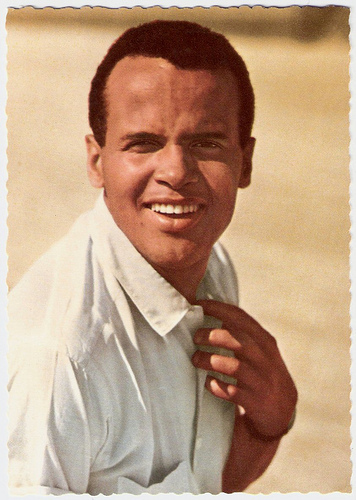
German postcard by Ufa (Universum-Film Aktiengesellschaft), Berlin-Tempelhof, no. CK 232. Retail price: 30 Pfg. Photo: Fried Agency.
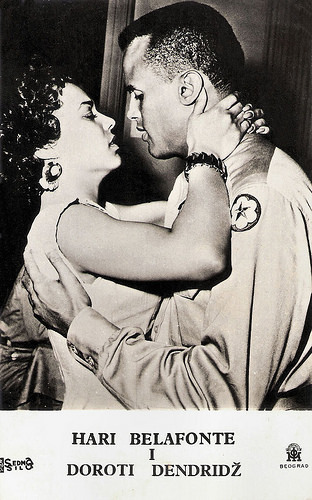
Yugoslavian postcard by IOM, Beograd. Photo: Sedmo Silo. Publicity still for Carmen Jones (Otto Preminger, 1954) with Dorothy Dandridge .
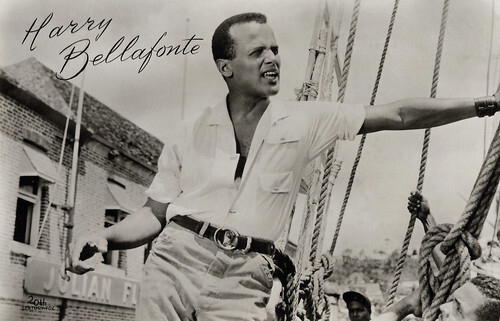
Dutch postcard by Uitgeverij Takken, Utrecht, no. AX 3680. Photo: 20th Century Fox. Harry Belafonte in Island in the Sun (Robert Rossen, 1957). Belafonte's name is misspelt on the card.
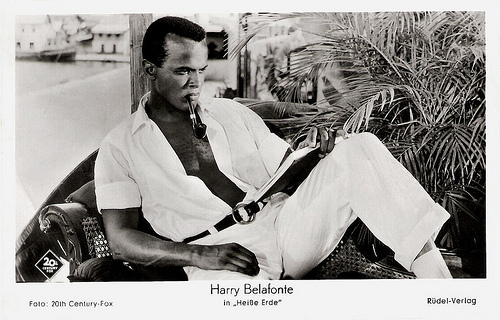
German postcard by Rüdel-Verlag, Hamburg-Bergedorf, no. 2186. Photo: 20th Century Fox. Publicity still for Island in the Sun (Robert Rossen, 1957).
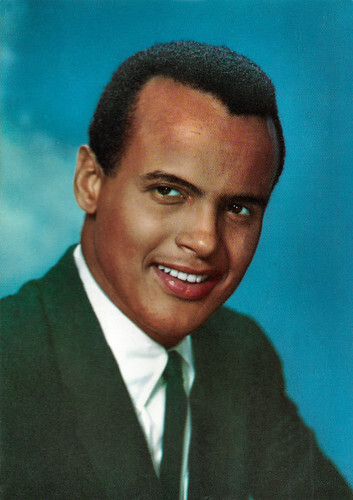
French postcard by Editions P.I., Paris, no. 143, offered by Les Carbones Korès "Carboplane", no. 174.
The King of Calypso
Harry Belafonte was born Harold George Bellanfanti Jr. at Lying-in Hospital in 1927, in Harlem, New York. He was the son of Melvine (née Love), a housekeeper, and Harold George Bellanfanti Sr., who worked as a chef. His mother was born in Jamaica, the child of a Scottish white mother and a black father. His father also was born in Jamaica, the child of a black mother and a Dutch Jewish father of Sephardi origins. From 1932 to 1940, he lived with one of his grandmothers in her native country of Jamaica, where he attended Wolmer's Schools. When he returned to New York City, he attended George Washington High School after which he joined the Navy and served during World War II.
In the 1940s, he was working as a janitor's assistant in NYC when a tenant gave him, as a gratuity, two tickets to see the American Negro Theater. He fell in love with the art form and also met Sidney Poitier . The financially struggling pair regularly purchased a single seat to local plays, trading places in between acts, after informing each other about the progression of the play. At the end of the 1940s, he took classes in acting at the Dramatic Workshop of The New School in New York with the influential German director Erwin Piscator alongside Marlon Brando , Tony Curtis , Walter Matthau, Bea Arthur, and Sidney Poitier , while performing with the American Negro Theatre in such plays as 'Days of Our Youth' (1946). In 1954, he would receive a Tony Award for his participation in the Broadway revue 'John Murray Anderson's Almanac'.
Belafonte started his career in music as a club singer in New York to pay for his acting classes. The first time he appeared in front of an audience at the Village Vanguard in New York, he was backed by the Charlie Parker band, which included Charlie Parker himself, Max Roach, and Miles Davis, among others. At first, he was a pop singer, launching his recording career on the Roost label in 1949, but later he developed a keen interest in folk music, learning material through the Library of Congress's American folk songs archives. With guitarist and friend Millard Thomas, Belafonte soon made his debut at the legendary jazz club The Village Vanguard. In 1952, he received a contract with RCA Victor. His first widely released single, which went on to become his 'signature' song with audience participation in virtually all his live performances, was 'Matilda' (1953). His breakthrough album 'Calypso' (1956) became the first LP in the world to sell over 1 million copies within a year. It spent 31 weeks at number 1, 58 weeks in the top ten, and 99 weeks on the U.S. charts. The album introduced American audiences to calypso music, which had originated in Trinidad and Tobago in the early 20th century.
Belafonte was dubbed the 'King of Calypso', a title he wore with reservations since he had no claims to any Calypso Monarch titles. One of the songs included in the album is the now famous 'Banana Boat Song' (listed as 'Day O' on the original release), which reached number five on the pop charts. His other smash hit was 'Jump in the Line'. Many of the compositions recorded for Calypso, including 'Banana Boat Song', gave songwriting credit to Irving Burgie. His triumphant success as an entertainer in the arts did not protect Belafonte from racial discrimination, particularly in the South. As a result, he refused to perform in the southern region of the United States from 1954 until 1961.
Belafonte's first film role was in Bright Road (Gerald Mayer, 1953), in which he appeared alongside Dorothy Dandridge . In this low-budget film adapted from the Christopher Award-winning short story 'See How They Run' by Mary Elizabeth Vroman, Dandridge starred as an idealistic first-year elementary school teacher trying to reach out to a problem student. Belafonte played the principal of the school. The two subsequently starred in Otto Preminger's hit musical Carmen Jones (1954). The screenplay by Harry Kleiner was based on the lyrics and book by Oscar Hammerstein II, from the 1943 stage musical of the same name, set to the music of Georges Bizet's 1875 opera 'Carmen'. Ironically, Belafonte's singing in the film was dubbed by an opera singer, as Belafonte's own singing voice was seen as unsuitable for the role. Using his star clout, Belafonte was subsequently able to realise several then-controversial film roles. Island in the Sun (Robert Rossen, 1957) is about race relations and interracial romance set on the fictitious island of Santa Marta. The film was controversial at the time of its release for its hints of an affair between Belafonte's character and the character played by Joan Fontaine. The film also starred James Mason , Dorothy Dandridge, and Joan Collins .
In 1959, he starred in and produced the Film Noir Odds Against Tomorrow (Robert Wise, 1959), in which he played a bank robber uncomfortably teamed with a racist partner (Robert Ryan). He also co-starred with Inger Stevens in the Science-Fiction doomsday film The World, the Flesh and the Devil (Ranald MacDougall, 1959). Belafonte was offered the role of Porgy in Porgy and Bess (Otto Preminger, 1959), based on the 1935 opera Porgy and Bess by George Gershwin, DuBose Heyward, and Ira Gershwin. Here he would have once again starred opposite Dorothy Dandridge , but he refused the role because he objected to its racial stereotyping. Sidney Poitier would play the role in the film. Dissatisfied with the film roles available to him, he returned to music during the 1960s.
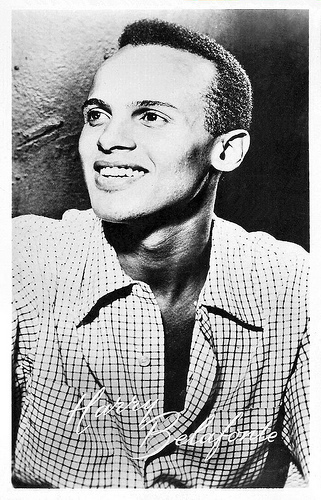
Dutch postcard by Uitgeverij Takken, Utrecht, no. 2054.
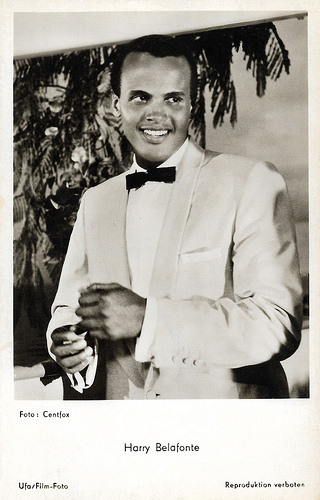
German postcard by Ufa/Film-Foto, Berlin-Tempelhof, no. FK 3791. Photo: Centfox. Publicity still for Island in the Sun (Robert Rossen, 1957).
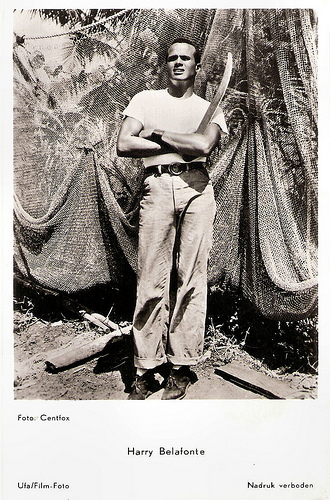
Dutch postcard by Gebr. Spanjersberg N.V., Rotterdam, no. 3793. Photo: Centfox. Publicity still for Island in the Sun (Robert Rossen, 1957).
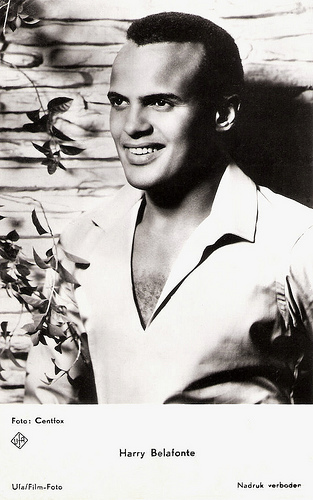
Dutch postcard by Gebr. Spanjersberg N.V., Rotterdam, no. 4022. Photo: Centfox. Publicity still for Island in the Sun (Robert Rossen, 1957).
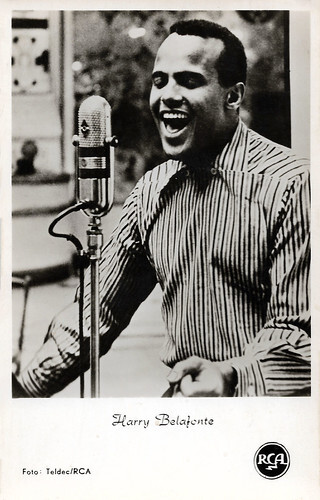
Dutch postcard by Editions Altona, Amsterdam, no. 5167. Photo: Teldec / RCA.
The Banana Boat Song
While primarily known for calypso, Harry Belafonte has recorded in many different genres, including blues, folk, gospel, show tunes and American standards. His second-most popular hit, which came immediately after 'The Banana Boat Song', was the comedic tune 'Mama Look at Bubu', also known as 'Mama Look a Boo-Boo' (originally recorded by Lord Melody in 1955), in which he sings humorously about misbehaving and disrespectful children. It reached number eleven on the pop chart. In 1959, he starred in Tonight With Belafonte, a nationally televised special that featured Odetta. Belafonte was the first Jamaican American to win an Emmy, for Revlon Revue: Tonight with Belafonte (1959). Belafonte recorded for RCA Victor from 1953 to 1974. Two live albums, both recorded at Carnegie Hall in 1959 and 1960, enjoyed critical and commercial success. From his 1959 album, 'Hava Nagila' became part of his regular routine and one of his signature songs. He was one of many entertainers recruited by Frank Sinatra to perform at the inaugural gala of President John F. Kennedy in 1961. That same year he released his second calypso album, 'Jump Up Calypso', which went on to become another million-seller. During the 1960s he introduced several artists to American audiences, most notably South African singer Miriam Makeba and Greek singer Nana Mouskouri. His album 'Midnight Special' (1962) included a young harmonica player named Bob Dylan.
As The Beatles and other stars from Britain began to dominate the pop charts, Belafonte's commercial success diminished. His 'Belafonte at The Greek Theatre' was his last album to appear in Billboard's Top 40. His last hit single, 'A Strange Song', was released in 1967 and peaked at number 5 on the charts. Belafonte has received Grammy Awards for the albums 'Swing Dat Hammer' (1960) and 'An Evening with Belafonte/Makeba' (1965). The latter album dealt with the political plight of black South Africans under apartheid. In 1967, Belafonte was the first non-classical artist to perform at the prestigious Saratoga Performing Arts Center (SPAC) in Upstate New York, soon to be followed by concerts there by The Doors, The 5th Dimension, The Who, and Janis Joplin. In February 1968, Belafonte guest-hosted The Tonight Show substituting for Johnny Carson. Among his interview guests were Martin Luther King Jr. and Sen. Robert F. Kennedy.
During the 1960s, he appeared on TV specials alongside such artists as Julie Andrews , Petula Clark , Lena Horne , and Nana Mouskouri. In 1968, Belafonte appeared on a Petula Clark TV special on NBC. In the middle of a song, Clark smiled and briefly touched Belafonte's arm. The show's sponsor, Plymouth Motors, wanted to cut out the segment, but Clark, who had ownership of the special, told NBC that the performance would be shown intact or not at all. American newspapers published articles reporting the controversy and, when the special aired, it grabbed huge ratings.
In the early 1970s, Belafonte returned to the cinema in two films with Sidney Poitier. The Western Buck and the Preacher (Sidney Poitier, 1972) broke Hollywood Western traditions by casting blacks as central characters and portraying both tension and solidarity between African Americans and Native Americans in the late 19th century. Buck and the Preacher was one of the first films directed by an African American and to be based on a band of African Americans fighting against the White majority. The film was produced by Belafonte Enterprises, Columbia Pictures Corporation, and E & R Productions Corp. Uptown Saturday Night (Sidney Poitier, 1974) is an action-comedy crime film written by Richard Wesley and starring Sidney Poitier , Bill Cosby, and Harry Belafonte. Although the film received mixed reviews, it was a commercial success and was part of the Blaxploitation wave. Later, Cosby and Poitier teamed up again, without Belafonte, for the sequels Let's Do It Again (Sidney Poitier, 1975) and A Piece of the Action (Sidney Poitier, 1977).
Harry Belafonte's recording activity slowed after he left RCA in the mid-1970s. RCA released his fifth and final Calypso album, 'Calypso Carnival' in 1971. From the mid-1970s to the early 1980s, Belafonte spent the greater part of his time touring Japan, Europe, Cuba, and elsewhere. In 1977, he released the album 'Turn the World Around' at Columbia Records. The album, with a strong focus on world music, was never issued in the United States.He subsequently was a guest star on a memorable episode of The Muppet Show (1978), in which he performed his signature song 'Day-O' on television for the first time. However, the episode is best known for Belafonte's rendition of the spiritual song 'Turn the World Around', from the album of the same name, which he performed with specially made Muppets that resembled African tribal masks. Belafonte reprised the song at John Henson's memorial in 1990.
In 1984, Belafonte produced and scored the musical film Beat Street (Stan Lathan, 1984). Set in the South Bronx, the film follows the lives of a pair of brothers and their group of friends, all of whom are devoted to various elements of early hip-hop culture. The cast included Rae Dawn Chong and Guy Davis. Together with Arthur Baker, Belafonte produced the gold-certified soundtrack of the same name. Beat Street's impact was felt internationally as well as throughout the United States. In Germany, for example, films such as Beat Street are credited with introducing the hip-hop movement to the country. In 1985, he was one of the organisers behind the Grammy Award-winning song 'We Are the World', a multi-artist effort to raise funds for Africa, and performed in the Live Aid concert that same year. Belafonte's involvement in 'USA for Africa' resulted in renewed interest in his music, culminating in a record deal with EMI. He subsequently released his first album of original material in over a decade, 'Paradise in Gazankulu', (1988). The album contains ten protest songs against the South African former Apartheid policy and is his last studio album. As UNICEF Goodwill Ambassador, Belafonte attended in 1988 a symposium in Harare, Zimbabwe, to focus attention on child survival and development in Southern African countries. As part of the symposium, he performed a concert for UNICEF. A Kodak video crew filmed the concert, which was released as a 60-minute concert video titled Global Carnival. Also in 1988, Tim Burton used 'The Banana Boat Song' and 'Jump in the Line' in his film Beetlejuice (Tim Burton, 1988).
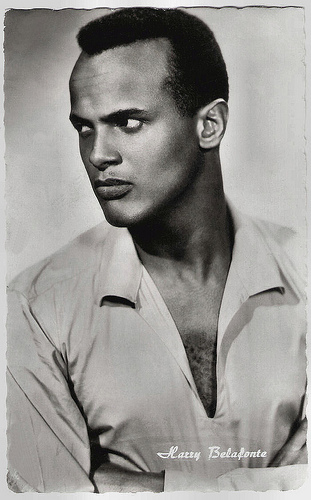
Dutch postcard, no. 2099. Photo: Centfox. Publicity still for Island in the Sun (Robert Rossen, 1957).
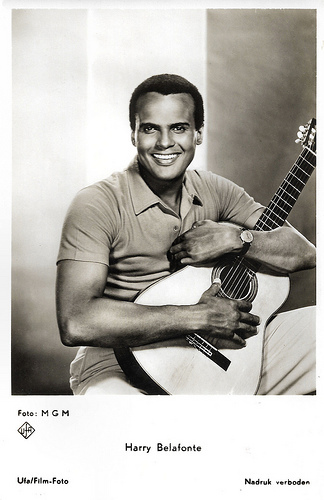
Dutch postcard by D.R.C., Holland, no. 1172. Photo: MGM /Ufa.
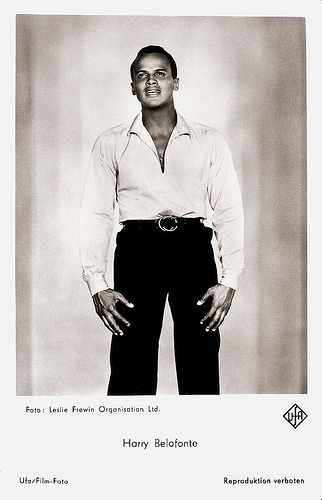
German postcard by Ufa/Film-Foto, Berlin-Tempelhof, no. FK 4282. Photo: Leslie Frewin Organisation Ltd.
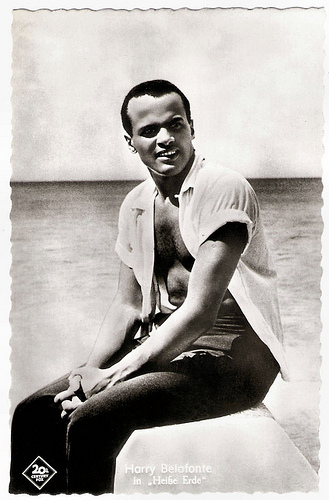
German postcard by Kolibri-Verlag, Minden/Westf., no. 2945. Photo: 20th Century Fox. Publicity still for Island in the Sun (Robert Rossen, 1957).
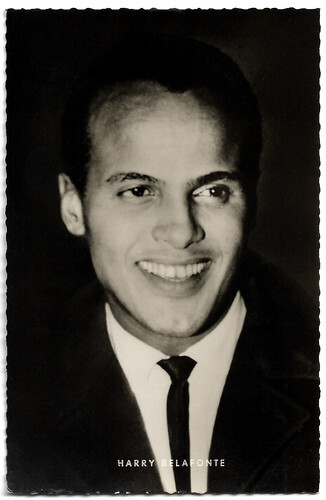
West-German postcard by Kunst und Bild, Berlin-Charlottenburg, no. V 143.
Always outspoken in his beliefs
Belafonte appeared with John Travolta in the film drama White Man's Burden (1995), about racism in an alternative America where black and white Americans have reversed cultural roles. The film was written and directed by Desmond Nakano. The film revolves around Louis Pinnock (Travolta), a white factory worker, who kidnaps Thaddeus Thomas (Belafonte), a black factory owner for firing him over a perceived slight. The film gained a negative reception from the critics and was not a box-office success. For Robert Altman's jazz age drama Kansas City (1996), he won the New York Film Critics Circle Award for Best Supporting Actor. Kansas City, which stars Jennifer Jason Leigh and Miranda Richardson, is also notable for its musical score being integrated into the film, with modern-day musicians recreating the Kansas City jazz of the 1930s. For instance, Craig Handy played the role of Coleman Hawkins, Geri Allen played Mary Lou Williams, and James Carter played Ben Webster.
Following a lengthy recording hiatus, 'An Evening with Harry Belafonte and Friends' (1997), a soundtrack and video of a televised concert, were released by Island Records. 'The Long Road to Freedom: An Anthology of Black Music', a huge multi-artist project recorded by RCA during the 1960s and 1970s, was finally released by the label in 2001. Belafonte went on the Today Show to promote the album on 11 September 2001 and was interviewed by Katie Couric just minutes before the first plane hit the World Trade Center. The album was nominated for the 2002 Grammy Awards for Best Boxed Recording Package, for Best Album Notes, and for Best Historical Album. On television, Harry Belafonte starred as an Associate Justice of the Supreme Court of the United States in the TV drama Swing Vote (David Anspaugh, 1999) with Andy Garcia. In 2006, Belafonte appeared in the film Bobby, Emilio Estevez's ensemble drama about the assassination of Robert F. Kennedy. Belafonte played Nelson, a friend of an employee of the Ambassador Hotel (Anthony Hopkins).
Belafonte received the Kennedy Center Honors in 1989. He was awarded the National Medal of Arts in 1994 and he won a Grammy Lifetime Achievement Award in 2000. He performed sold-out concerts globally from the 1950s to the 2000s. Owing to illness, he was forced to cancel a reunion tour with Nana Mouskouri planned for the spring and summer of 2003 following a tour in Europe. His last concert was a benefit concert for the Atlanta Opera on 25 October 2003. In a 2007 interview, he stated that he had since retired from performing. In 2017 Harry Belafonte released 'When Colors Come Together', an anthology of his music for Sony Legends produced by his son David Belafonte. David wrote a remake of 'Island In The Sun', arranged by longtime Belafonte musical director Richard Cummings featuring Harry Belafonte's grandchildren Sarafina and Amadeus and a children's choir.
Always outspoken in his beliefs, Belafonte achieved widespread attention for his political views in 2002 when he began making a series of negative comments about President George W. Bush and the Iraq War. Belafonte created controversy in October 2002 when he made disparaging remarks about Secretary of State Colin Powell. Far from being upset, Powell reportedly took the remarks good-humoured, refusing to inflame the situation any further. Belafonte's other controversial political statements on U.S. foreign policy have included opposing the U.S. embargo on Cuba, praising Soviet peace initiatives, attacking the U.S. invasion of Grenada, praising the Abraham Lincoln Brigade, honouring Ethel, and Julius Rosenberg, and praising Fidel Castro.
On a Martin Luther King Day speech at Duke University in 2006, Belafonte compared the American government to the 9/11 terrorists. Belafonte and his first wife Marguerite Byrd were married from 1948 to 1957. They have two daughters: Adrienne and Shari, who also worked as an actress. In 1957, Belafonte married his second wife Julie Robinson, a former dancer with the Katherine Dunham Company who was of Jewish descent. They had two children, David and Gina. David, the only son of Harry Belafonte, is a former model and actor and is an Emmy-winning and Grammy-nominated music producer and the executive director of the family-held company Belafonte Enterprises Inc. As a music producer, David has been involved in most of Belafonte's albums and tours and productions. After 47 years of marriage, Belafonte and Robinson got a divorce. In April 2008, Harry Belafonte married photographer Pamela Frank.
In 2018, Belafonte returned to the cinema in Spike Lee's biographical crime film BlacKkKlansman (2018) as an elderly civil rights pioneer. Set in 1970s Colorado Springs, the plot follows the first African-American detective in the city's police department as he sets out to infiltrate and expose the local chapter of the Ku Klux Klan. BlacKkKlansman premiered at the 2018 Cannes Film Festival, where it won the Grand Prix. Belafonte appears in the film recounting the lynching of Jesse Washington, a black teenage farmhand who was lynched in the county seat of Waco, Texas, on 15 May 1916, in what became a well-known example of racially motivated lynching. In 2019, the film won an Oscar for Best Adapted Screenplay. It was written by Charlie Wachtel, David Rabinowitz, Kevin Willmott and Spike Lee. Harry Belafonte died in New York on 25 April 2023, due to congestive heart failure. He was 96.
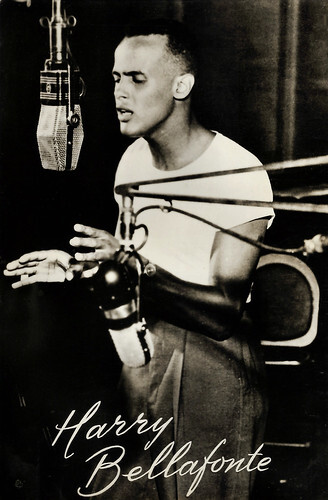
Dutch postcard by Uitg. Takken, Utrecht, no. 3241.
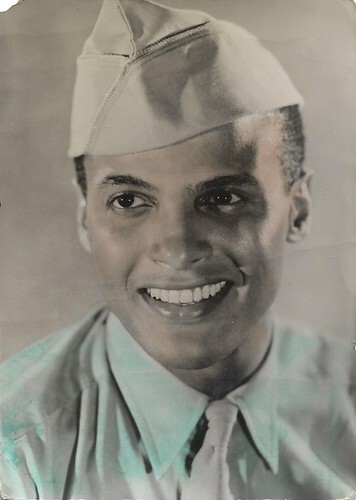
Former Yugoslavian (Croatian) postcard by 3 K, no. 3845, mailed on 18-7-1963. Harry Belafonte in Carmen Jones (Otto Preminger, 1954).
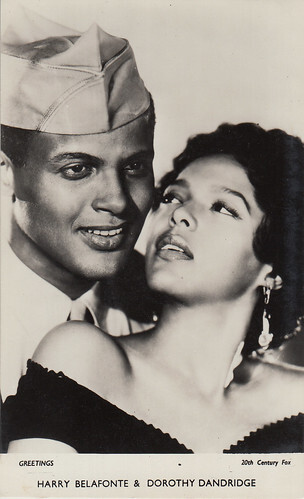
British postcard in the Greetings series. Photo: 20th Century Fox. Dorothy Dandridge and Harry Belafonte in Carmen Jones (Otto Preminger, 1954). Collection: Marlene Pilaete.
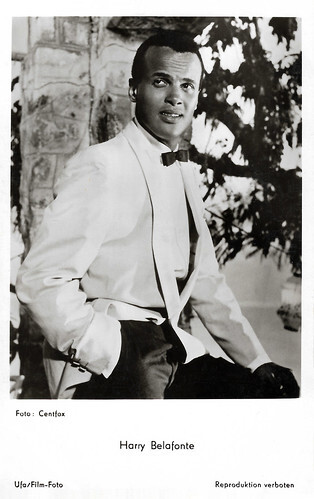
West-German postcard by Ufa/Film-Foto, Berlin-Tempelhof, no. FK 3659. Photo: Centfox. Harry Belafonte in Island in the Sun (Robert Rossen, 1957).
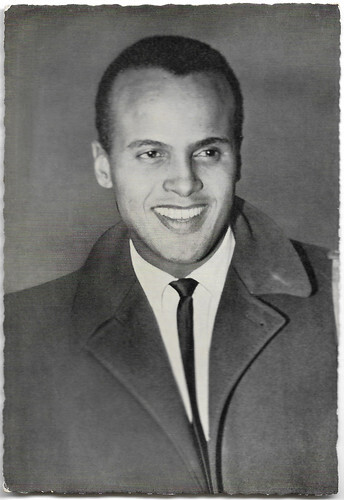
West-German postcard by WS-Druck, Wanne-Eickel, no. 174. Photo: dpa / Centfox.
Trailer for Bright Road (1953). Source: Department of Afro-American Research Arts Culture (YouTube).
Harry Belafonte sings the title song from Island In The Sun (1957) on TV. Source: Kester 1940 (YouTube).
'Day-O' (The Banana Boat Song) in Beetlejuice (1988). Source: Lipebianc (YouTube).
Harry Belafonte and The Muppets perform 'Earth Song'. Source: LenușTM (YouTube).
Sources: Wikipedia and .

German postcard by Ufa (Universum-Film Aktiengesellschaft), Berlin-Tempelhof, no. CK 232. Retail price: 30 Pfg. Photo: Fried Agency.

Yugoslavian postcard by IOM, Beograd. Photo: Sedmo Silo. Publicity still for Carmen Jones (Otto Preminger, 1954) with Dorothy Dandridge .

Dutch postcard by Uitgeverij Takken, Utrecht, no. AX 3680. Photo: 20th Century Fox. Harry Belafonte in Island in the Sun (Robert Rossen, 1957). Belafonte's name is misspelt on the card.

German postcard by Rüdel-Verlag, Hamburg-Bergedorf, no. 2186. Photo: 20th Century Fox. Publicity still for Island in the Sun (Robert Rossen, 1957).

French postcard by Editions P.I., Paris, no. 143, offered by Les Carbones Korès "Carboplane", no. 174.
The King of Calypso
Harry Belafonte was born Harold George Bellanfanti Jr. at Lying-in Hospital in 1927, in Harlem, New York. He was the son of Melvine (née Love), a housekeeper, and Harold George Bellanfanti Sr., who worked as a chef. His mother was born in Jamaica, the child of a Scottish white mother and a black father. His father also was born in Jamaica, the child of a black mother and a Dutch Jewish father of Sephardi origins. From 1932 to 1940, he lived with one of his grandmothers in her native country of Jamaica, where he attended Wolmer's Schools. When he returned to New York City, he attended George Washington High School after which he joined the Navy and served during World War II.
In the 1940s, he was working as a janitor's assistant in NYC when a tenant gave him, as a gratuity, two tickets to see the American Negro Theater. He fell in love with the art form and also met Sidney Poitier . The financially struggling pair regularly purchased a single seat to local plays, trading places in between acts, after informing each other about the progression of the play. At the end of the 1940s, he took classes in acting at the Dramatic Workshop of The New School in New York with the influential German director Erwin Piscator alongside Marlon Brando , Tony Curtis , Walter Matthau, Bea Arthur, and Sidney Poitier , while performing with the American Negro Theatre in such plays as 'Days of Our Youth' (1946). In 1954, he would receive a Tony Award for his participation in the Broadway revue 'John Murray Anderson's Almanac'.
Belafonte started his career in music as a club singer in New York to pay for his acting classes. The first time he appeared in front of an audience at the Village Vanguard in New York, he was backed by the Charlie Parker band, which included Charlie Parker himself, Max Roach, and Miles Davis, among others. At first, he was a pop singer, launching his recording career on the Roost label in 1949, but later he developed a keen interest in folk music, learning material through the Library of Congress's American folk songs archives. With guitarist and friend Millard Thomas, Belafonte soon made his debut at the legendary jazz club The Village Vanguard. In 1952, he received a contract with RCA Victor. His first widely released single, which went on to become his 'signature' song with audience participation in virtually all his live performances, was 'Matilda' (1953). His breakthrough album 'Calypso' (1956) became the first LP in the world to sell over 1 million copies within a year. It spent 31 weeks at number 1, 58 weeks in the top ten, and 99 weeks on the U.S. charts. The album introduced American audiences to calypso music, which had originated in Trinidad and Tobago in the early 20th century.
Belafonte was dubbed the 'King of Calypso', a title he wore with reservations since he had no claims to any Calypso Monarch titles. One of the songs included in the album is the now famous 'Banana Boat Song' (listed as 'Day O' on the original release), which reached number five on the pop charts. His other smash hit was 'Jump in the Line'. Many of the compositions recorded for Calypso, including 'Banana Boat Song', gave songwriting credit to Irving Burgie. His triumphant success as an entertainer in the arts did not protect Belafonte from racial discrimination, particularly in the South. As a result, he refused to perform in the southern region of the United States from 1954 until 1961.
Belafonte's first film role was in Bright Road (Gerald Mayer, 1953), in which he appeared alongside Dorothy Dandridge . In this low-budget film adapted from the Christopher Award-winning short story 'See How They Run' by Mary Elizabeth Vroman, Dandridge starred as an idealistic first-year elementary school teacher trying to reach out to a problem student. Belafonte played the principal of the school. The two subsequently starred in Otto Preminger's hit musical Carmen Jones (1954). The screenplay by Harry Kleiner was based on the lyrics and book by Oscar Hammerstein II, from the 1943 stage musical of the same name, set to the music of Georges Bizet's 1875 opera 'Carmen'. Ironically, Belafonte's singing in the film was dubbed by an opera singer, as Belafonte's own singing voice was seen as unsuitable for the role. Using his star clout, Belafonte was subsequently able to realise several then-controversial film roles. Island in the Sun (Robert Rossen, 1957) is about race relations and interracial romance set on the fictitious island of Santa Marta. The film was controversial at the time of its release for its hints of an affair between Belafonte's character and the character played by Joan Fontaine. The film also starred James Mason , Dorothy Dandridge, and Joan Collins .
In 1959, he starred in and produced the Film Noir Odds Against Tomorrow (Robert Wise, 1959), in which he played a bank robber uncomfortably teamed with a racist partner (Robert Ryan). He also co-starred with Inger Stevens in the Science-Fiction doomsday film The World, the Flesh and the Devil (Ranald MacDougall, 1959). Belafonte was offered the role of Porgy in Porgy and Bess (Otto Preminger, 1959), based on the 1935 opera Porgy and Bess by George Gershwin, DuBose Heyward, and Ira Gershwin. Here he would have once again starred opposite Dorothy Dandridge , but he refused the role because he objected to its racial stereotyping. Sidney Poitier would play the role in the film. Dissatisfied with the film roles available to him, he returned to music during the 1960s.

Dutch postcard by Uitgeverij Takken, Utrecht, no. 2054.

German postcard by Ufa/Film-Foto, Berlin-Tempelhof, no. FK 3791. Photo: Centfox. Publicity still for Island in the Sun (Robert Rossen, 1957).

Dutch postcard by Gebr. Spanjersberg N.V., Rotterdam, no. 3793. Photo: Centfox. Publicity still for Island in the Sun (Robert Rossen, 1957).

Dutch postcard by Gebr. Spanjersberg N.V., Rotterdam, no. 4022. Photo: Centfox. Publicity still for Island in the Sun (Robert Rossen, 1957).

Dutch postcard by Editions Altona, Amsterdam, no. 5167. Photo: Teldec / RCA.
The Banana Boat Song
While primarily known for calypso, Harry Belafonte has recorded in many different genres, including blues, folk, gospel, show tunes and American standards. His second-most popular hit, which came immediately after 'The Banana Boat Song', was the comedic tune 'Mama Look at Bubu', also known as 'Mama Look a Boo-Boo' (originally recorded by Lord Melody in 1955), in which he sings humorously about misbehaving and disrespectful children. It reached number eleven on the pop chart. In 1959, he starred in Tonight With Belafonte, a nationally televised special that featured Odetta. Belafonte was the first Jamaican American to win an Emmy, for Revlon Revue: Tonight with Belafonte (1959). Belafonte recorded for RCA Victor from 1953 to 1974. Two live albums, both recorded at Carnegie Hall in 1959 and 1960, enjoyed critical and commercial success. From his 1959 album, 'Hava Nagila' became part of his regular routine and one of his signature songs. He was one of many entertainers recruited by Frank Sinatra to perform at the inaugural gala of President John F. Kennedy in 1961. That same year he released his second calypso album, 'Jump Up Calypso', which went on to become another million-seller. During the 1960s he introduced several artists to American audiences, most notably South African singer Miriam Makeba and Greek singer Nana Mouskouri. His album 'Midnight Special' (1962) included a young harmonica player named Bob Dylan.
As The Beatles and other stars from Britain began to dominate the pop charts, Belafonte's commercial success diminished. His 'Belafonte at The Greek Theatre' was his last album to appear in Billboard's Top 40. His last hit single, 'A Strange Song', was released in 1967 and peaked at number 5 on the charts. Belafonte has received Grammy Awards for the albums 'Swing Dat Hammer' (1960) and 'An Evening with Belafonte/Makeba' (1965). The latter album dealt with the political plight of black South Africans under apartheid. In 1967, Belafonte was the first non-classical artist to perform at the prestigious Saratoga Performing Arts Center (SPAC) in Upstate New York, soon to be followed by concerts there by The Doors, The 5th Dimension, The Who, and Janis Joplin. In February 1968, Belafonte guest-hosted The Tonight Show substituting for Johnny Carson. Among his interview guests were Martin Luther King Jr. and Sen. Robert F. Kennedy.
During the 1960s, he appeared on TV specials alongside such artists as Julie Andrews , Petula Clark , Lena Horne , and Nana Mouskouri. In 1968, Belafonte appeared on a Petula Clark TV special on NBC. In the middle of a song, Clark smiled and briefly touched Belafonte's arm. The show's sponsor, Plymouth Motors, wanted to cut out the segment, but Clark, who had ownership of the special, told NBC that the performance would be shown intact or not at all. American newspapers published articles reporting the controversy and, when the special aired, it grabbed huge ratings.
In the early 1970s, Belafonte returned to the cinema in two films with Sidney Poitier. The Western Buck and the Preacher (Sidney Poitier, 1972) broke Hollywood Western traditions by casting blacks as central characters and portraying both tension and solidarity between African Americans and Native Americans in the late 19th century. Buck and the Preacher was one of the first films directed by an African American and to be based on a band of African Americans fighting against the White majority. The film was produced by Belafonte Enterprises, Columbia Pictures Corporation, and E & R Productions Corp. Uptown Saturday Night (Sidney Poitier, 1974) is an action-comedy crime film written by Richard Wesley and starring Sidney Poitier , Bill Cosby, and Harry Belafonte. Although the film received mixed reviews, it was a commercial success and was part of the Blaxploitation wave. Later, Cosby and Poitier teamed up again, without Belafonte, for the sequels Let's Do It Again (Sidney Poitier, 1975) and A Piece of the Action (Sidney Poitier, 1977).
Harry Belafonte's recording activity slowed after he left RCA in the mid-1970s. RCA released his fifth and final Calypso album, 'Calypso Carnival' in 1971. From the mid-1970s to the early 1980s, Belafonte spent the greater part of his time touring Japan, Europe, Cuba, and elsewhere. In 1977, he released the album 'Turn the World Around' at Columbia Records. The album, with a strong focus on world music, was never issued in the United States.He subsequently was a guest star on a memorable episode of The Muppet Show (1978), in which he performed his signature song 'Day-O' on television for the first time. However, the episode is best known for Belafonte's rendition of the spiritual song 'Turn the World Around', from the album of the same name, which he performed with specially made Muppets that resembled African tribal masks. Belafonte reprised the song at John Henson's memorial in 1990.
In 1984, Belafonte produced and scored the musical film Beat Street (Stan Lathan, 1984). Set in the South Bronx, the film follows the lives of a pair of brothers and their group of friends, all of whom are devoted to various elements of early hip-hop culture. The cast included Rae Dawn Chong and Guy Davis. Together with Arthur Baker, Belafonte produced the gold-certified soundtrack of the same name. Beat Street's impact was felt internationally as well as throughout the United States. In Germany, for example, films such as Beat Street are credited with introducing the hip-hop movement to the country. In 1985, he was one of the organisers behind the Grammy Award-winning song 'We Are the World', a multi-artist effort to raise funds for Africa, and performed in the Live Aid concert that same year. Belafonte's involvement in 'USA for Africa' resulted in renewed interest in his music, culminating in a record deal with EMI. He subsequently released his first album of original material in over a decade, 'Paradise in Gazankulu', (1988). The album contains ten protest songs against the South African former Apartheid policy and is his last studio album. As UNICEF Goodwill Ambassador, Belafonte attended in 1988 a symposium in Harare, Zimbabwe, to focus attention on child survival and development in Southern African countries. As part of the symposium, he performed a concert for UNICEF. A Kodak video crew filmed the concert, which was released as a 60-minute concert video titled Global Carnival. Also in 1988, Tim Burton used 'The Banana Boat Song' and 'Jump in the Line' in his film Beetlejuice (Tim Burton, 1988).

Dutch postcard, no. 2099. Photo: Centfox. Publicity still for Island in the Sun (Robert Rossen, 1957).

Dutch postcard by D.R.C., Holland, no. 1172. Photo: MGM /Ufa.

German postcard by Ufa/Film-Foto, Berlin-Tempelhof, no. FK 4282. Photo: Leslie Frewin Organisation Ltd.

German postcard by Kolibri-Verlag, Minden/Westf., no. 2945. Photo: 20th Century Fox. Publicity still for Island in the Sun (Robert Rossen, 1957).

West-German postcard by Kunst und Bild, Berlin-Charlottenburg, no. V 143.
Always outspoken in his beliefs
Belafonte appeared with John Travolta in the film drama White Man's Burden (1995), about racism in an alternative America where black and white Americans have reversed cultural roles. The film was written and directed by Desmond Nakano. The film revolves around Louis Pinnock (Travolta), a white factory worker, who kidnaps Thaddeus Thomas (Belafonte), a black factory owner for firing him over a perceived slight. The film gained a negative reception from the critics and was not a box-office success. For Robert Altman's jazz age drama Kansas City (1996), he won the New York Film Critics Circle Award for Best Supporting Actor. Kansas City, which stars Jennifer Jason Leigh and Miranda Richardson, is also notable for its musical score being integrated into the film, with modern-day musicians recreating the Kansas City jazz of the 1930s. For instance, Craig Handy played the role of Coleman Hawkins, Geri Allen played Mary Lou Williams, and James Carter played Ben Webster.
Following a lengthy recording hiatus, 'An Evening with Harry Belafonte and Friends' (1997), a soundtrack and video of a televised concert, were released by Island Records. 'The Long Road to Freedom: An Anthology of Black Music', a huge multi-artist project recorded by RCA during the 1960s and 1970s, was finally released by the label in 2001. Belafonte went on the Today Show to promote the album on 11 September 2001 and was interviewed by Katie Couric just minutes before the first plane hit the World Trade Center. The album was nominated for the 2002 Grammy Awards for Best Boxed Recording Package, for Best Album Notes, and for Best Historical Album. On television, Harry Belafonte starred as an Associate Justice of the Supreme Court of the United States in the TV drama Swing Vote (David Anspaugh, 1999) with Andy Garcia. In 2006, Belafonte appeared in the film Bobby, Emilio Estevez's ensemble drama about the assassination of Robert F. Kennedy. Belafonte played Nelson, a friend of an employee of the Ambassador Hotel (Anthony Hopkins).
Belafonte received the Kennedy Center Honors in 1989. He was awarded the National Medal of Arts in 1994 and he won a Grammy Lifetime Achievement Award in 2000. He performed sold-out concerts globally from the 1950s to the 2000s. Owing to illness, he was forced to cancel a reunion tour with Nana Mouskouri planned for the spring and summer of 2003 following a tour in Europe. His last concert was a benefit concert for the Atlanta Opera on 25 October 2003. In a 2007 interview, he stated that he had since retired from performing. In 2017 Harry Belafonte released 'When Colors Come Together', an anthology of his music for Sony Legends produced by his son David Belafonte. David wrote a remake of 'Island In The Sun', arranged by longtime Belafonte musical director Richard Cummings featuring Harry Belafonte's grandchildren Sarafina and Amadeus and a children's choir.
Always outspoken in his beliefs, Belafonte achieved widespread attention for his political views in 2002 when he began making a series of negative comments about President George W. Bush and the Iraq War. Belafonte created controversy in October 2002 when he made disparaging remarks about Secretary of State Colin Powell. Far from being upset, Powell reportedly took the remarks good-humoured, refusing to inflame the situation any further. Belafonte's other controversial political statements on U.S. foreign policy have included opposing the U.S. embargo on Cuba, praising Soviet peace initiatives, attacking the U.S. invasion of Grenada, praising the Abraham Lincoln Brigade, honouring Ethel, and Julius Rosenberg, and praising Fidel Castro.
On a Martin Luther King Day speech at Duke University in 2006, Belafonte compared the American government to the 9/11 terrorists. Belafonte and his first wife Marguerite Byrd were married from 1948 to 1957. They have two daughters: Adrienne and Shari, who also worked as an actress. In 1957, Belafonte married his second wife Julie Robinson, a former dancer with the Katherine Dunham Company who was of Jewish descent. They had two children, David and Gina. David, the only son of Harry Belafonte, is a former model and actor and is an Emmy-winning and Grammy-nominated music producer and the executive director of the family-held company Belafonte Enterprises Inc. As a music producer, David has been involved in most of Belafonte's albums and tours and productions. After 47 years of marriage, Belafonte and Robinson got a divorce. In April 2008, Harry Belafonte married photographer Pamela Frank.
In 2018, Belafonte returned to the cinema in Spike Lee's biographical crime film BlacKkKlansman (2018) as an elderly civil rights pioneer. Set in 1970s Colorado Springs, the plot follows the first African-American detective in the city's police department as he sets out to infiltrate and expose the local chapter of the Ku Klux Klan. BlacKkKlansman premiered at the 2018 Cannes Film Festival, where it won the Grand Prix. Belafonte appears in the film recounting the lynching of Jesse Washington, a black teenage farmhand who was lynched in the county seat of Waco, Texas, on 15 May 1916, in what became a well-known example of racially motivated lynching. In 2019, the film won an Oscar for Best Adapted Screenplay. It was written by Charlie Wachtel, David Rabinowitz, Kevin Willmott and Spike Lee. Harry Belafonte died in New York on 25 April 2023, due to congestive heart failure. He was 96.

Dutch postcard by Uitg. Takken, Utrecht, no. 3241.

Former Yugoslavian (Croatian) postcard by 3 K, no. 3845, mailed on 18-7-1963. Harry Belafonte in Carmen Jones (Otto Preminger, 1954).

British postcard in the Greetings series. Photo: 20th Century Fox. Dorothy Dandridge and Harry Belafonte in Carmen Jones (Otto Preminger, 1954). Collection: Marlene Pilaete.

West-German postcard by Ufa/Film-Foto, Berlin-Tempelhof, no. FK 3659. Photo: Centfox. Harry Belafonte in Island in the Sun (Robert Rossen, 1957).

West-German postcard by WS-Druck, Wanne-Eickel, no. 174. Photo: dpa / Centfox.
Trailer for Bright Road (1953). Source: Department of Afro-American Research Arts Culture (YouTube).
Harry Belafonte sings the title song from Island In The Sun (1957) on TV. Source: Kester 1940 (YouTube).
'Day-O' (The Banana Boat Song) in Beetlejuice (1988). Source: Lipebianc (YouTube).
Harry Belafonte and The Muppets perform 'Earth Song'. Source: LenușTM (YouTube).
Sources: Wikipedia and .
Published on April 25, 2023 22:00
April 24, 2023
Eleanor Parker
American actress Eleanor Parker (1922-2013) appeared in some 80 films and television series. She was nominated three times for the Academy Award for Best Actress, for Caged (1950), Detective Story (1951) and Interrupted Melody (1955). Her role in Caged also won her the Volpi Cup for Best Actress at the Venice Film Festival. One of her most memorable roles was that of the Baroness in The Sound of Music (1965). Her biographer Doug McClelland called her ‘Woman of a Thousand Faces’, because of her versatility.
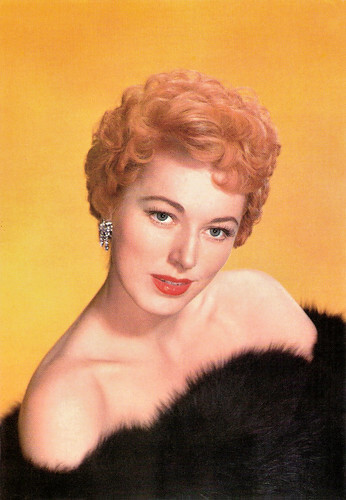
Italian postcard by Rotalfoto, Milano, no. N. 107.
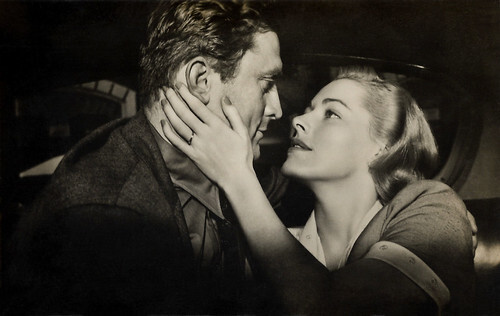
Spanish postcard by JDP, Valencia, no. 1375. Photo: Kirk Douglas and Eleanor Parker in Detective Story (William Wyler, 1951).
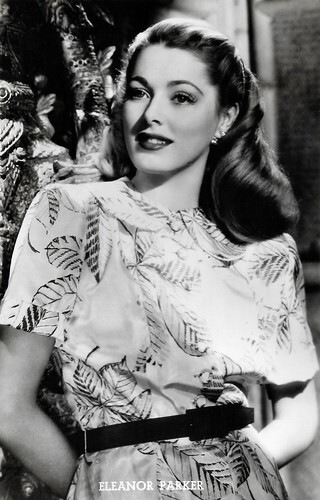
Belgian postcard, no. 551. Photo: Warner Bros.
Mission to Moscow
Eleanor Jean Parker was born in 1922, in Cedarville, Ohio. She was the daughter of Lola (Isett) and Lester Day Parker. Her family moved to East Cleveland, Ohio, where she attended public schools and graduated from Shaw High School. She appeared in a number of school plays. When she was 15 she started to attend the Rice Summer Theatre on Martha's Vineyard in Massachusetts.
After graduation, she moved to California and began appearing at the Pasadena Playhouse. There she was spotted by a Warners Bros talent scout, Irving Kumin. The studio signed her to a long-term contract in June 1941. She was cast that year in They Died with Their Boots On (Raoul Walsh, 1941), but her scenes were cut. Her actual film debut was as Nurse Ryan in the short Soldiers in White (B. Reeves Eason, 1942). She was given some decent roles in B films, Busses Roar (D. Ross Lederman, 1942) and The Mysterious Doctor (Benjamin Stoloff, 1943) opposite John Loder .
She also had a small role in one of Warner Brothers' biggest productions for the 1943 season, the pro-Soviet Mission to Moscow (Michael Curtiz, 1943) as Emlen Davies, daughter of the U.S. ambassador to the U.S.S.R (Walter Huston). On the set, she met her first husband, Navy Lieutenant Fred L. Losse, but the marriage turned out to be a brief wartime affair. Parker had impressed Warners enough to offer her a strong role in a prestige production, Between Two Worlds (Edward A. Blatt, 1944), playing the suicidal wife of Paul Henreid's character. She played support roles in Crime by Night (William Clemens, 1944) and The Last Ride (D. Ross Lederman, 1944).
Then she got the starring role opposite Dennis Morgan in The Very Thought of You (Delmer Daves, 1944). She was considered enough of a ‘name’ to be given a cameo in Hollywood Canteen (Delmer Daves, 1944). Warners gave her the choice role of Mildred Rogers in a new version of Somerset Maugham's Of Human Bondage (Edmund Goulding, 1946), but previews were not favourable and the film sat on the shelf for two years before being released. She had her big break when she was cast opposite John Garfield in Pride of the Marines (Delmer Daves, 1945). However, two films with Errol Flynn that followed, the romantic comedy Never Say Goodbye (James V. Kern, 1946) and the drama Escape Me Never (Peter Godfrey, 1947), were box office disappointments.
Parker was suspended twice by Warners for refusing parts in films – in Stallion Road (James V. Kern, 1947), where she was replaced by Alexis Smith and Love and Learn (Frederick De Cordova, 1947). She made the comedy Voice of the Turtle (Irving Rapper, 1947) with Ronald Reagan , and the mystery The Woman in White (Peter Godfrey, 1948). She refused to appear in Somewhere in the City (Vincent Sherman, 1950) so Warners suspended her again; Virginia Mayo played the role. Parker then had two years off, during which time she married and had a baby. She turned down a role in The Hasty Heart (Vincent Sherman, 1949) which she wanted to do, but it would have meant going to England and she did not want to leave her baby alone during its first year.
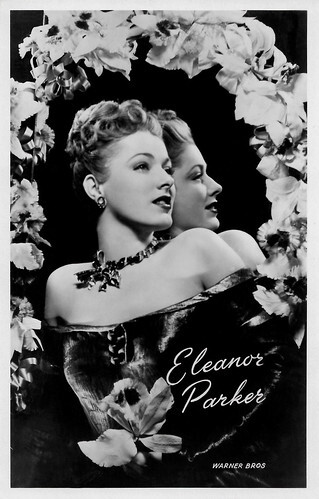
Belgian postcard. Photo: Warner Bros.
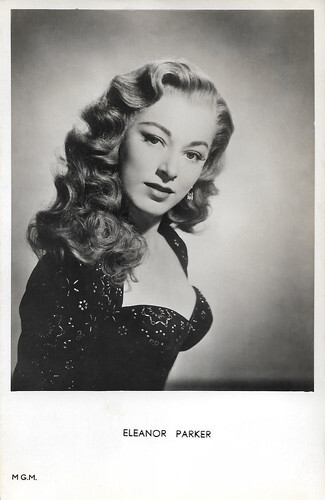
Vintage postcard, no. 92. Photo: M.G.M.
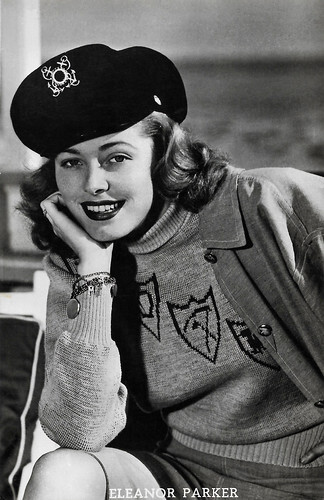
Belgian postcard, no. 950. Photo: Warner Bros.
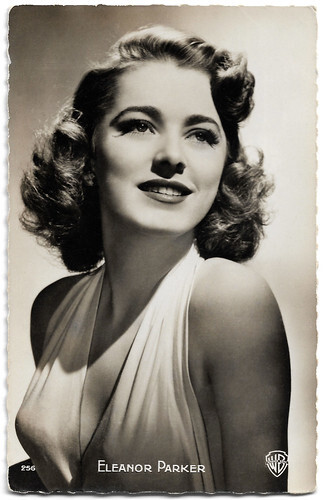
French postcard by Editions P.I., Paris, no. 256. Photo: Warner Bros.
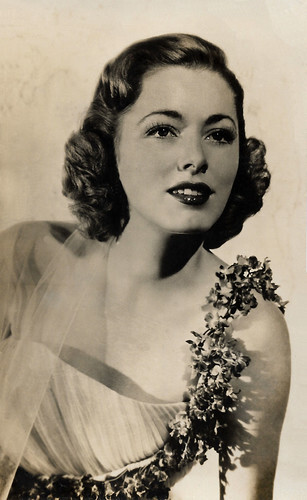
Spanish postcard, no. 2319.
Interrupted Melody
Eleanor Parker returned in Chain Lightning (Stuart Heisler, 1950) with Humphrey Bogart . Parker heard about a women-in-prison film Warners were making, Caged (John Cromwell, 1950), and actively lobbied for the role. She got it, won the 1950 Volpi Cup for Best Actress at the Venice Film Festival and was nominated for an Academy Award. She also had a good role in the melodrama Three Secrets (Robert Wise, 1950).
In February 1950, Parker left Warner Bros. after having been under contract there for eight years. Parker had understood that she would star in a film called Safe Harbor, but Warner Bros. apparently had no intention of making it. Because of this misunderstanding, her agents negotiated her release. Parker's career outside of Warners started badly with Valentino (Lewis Allen, 1951) playing a fictionalised wife of Rudolph Valentino for producer Edward Small. She tried a comedy at 20th Century Fox with Fred MacMurray , A Millionaire for Christy (George Marshall, 1951).
In 1951, Parker signed a contract with Paramount for one film a year, with an option for outside films. This arrangement began brilliantly with Detective Story (William Wyler, 1951) playing Mary McLeod, the woman who doesn't understand the position of her unstable detective husband ( Kirk Douglas ). Parker was nominated for the Oscar in 1951 for her performance. Parker followed Detective Story with her portrayal of an actress in love with a swashbuckling nobleman ( Stewart Granger ) in Scaramouche (George Sidney, 1952), a role originally intended for Ava Gardner . Wikipedia : “Parker later claimed that Granger was the only person she didn't get along with during her entire career. However, they had good chemistry and the film was a massive hit.“
MGM cast her into Above and Beyond (Melvin Frank, Norman Panama, 1952), a biopic of Lt. Col. Paul W. Tibbets, Jr. ( Robert Taylor ), the pilot of the aircraft that dropped the atomic bomb on Hiroshima. It was a solid hit. While Parker was making a third film for MGM, Escape from Fort Bravo (John Sturges, 1953), she signed a five-year contract with the studio. She was named as star of a Sidney Sheldon script, My Most Intimate Friend and of One More Time, from a script by Ruth Gordon and Garson Kanin directed by George Cukor, but neither film was made. Back at Paramount, Parker starred with Charlton Heston as a 1900s mail-order bride in The Naked Jungle (Byron Haskin, 1954), produced by George Pal. Parker returned to MGM where she was reunited with Robert Taylor in an Egyptian adventure film, Valley of the Kings (Robert Pirosh, 1954), and a Western, Many Rivers to Cross (Roy Rowland, 1955).
MGM gave her one of her best roles as opera singer Marjorie Lawrence struck down by polio in Interrupted Melody (Curtis Bernhardt, 1955). This was a big hit and earned Parker a third Oscar nomination; she later said it was her favourite film. Also in 1955, Parker appeared in the film adaptation of the National Book Award-winner The Man with the Golden Arm (Otto Preminger, 1955), released through United Artists. She played Zosh, the supposedly wheelchair-bound wife of heroin-addicted, would-be jazz drummer Frankie Machine ( Frank Sinatra ). It was a major commercial and critical success. In 1956, she co-starred with Clark Gable in the Western comedy The King and Four Queens (Raoul Walsh, 1956), also for United Artists. It was then back at MGM for two dramas: Lizzie (Hugo Haas, 1957), in the title role, as a woman with a split personality; and The Seventh Sin (Ronald Neame, 1957), a remake of The Painted Veil (Richard Boleslawski, 1934) in the role originated by Greta Garbo and, once again, intended for Ava Gardner . Both films flopped at the box office and, as a result, Parker's plans to produce her own film, L'Eternelle, about French resistance fighters, did not materialise.
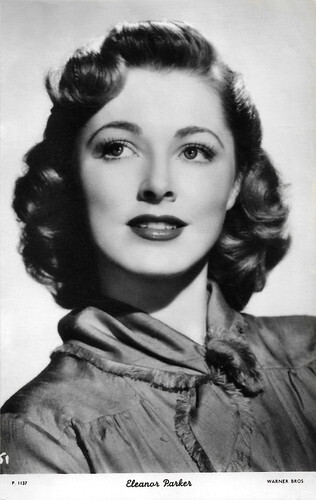
British postcard in "The People' series by Show Parade Picture Service, London, no. P 1137. Photo: Warner Bros.
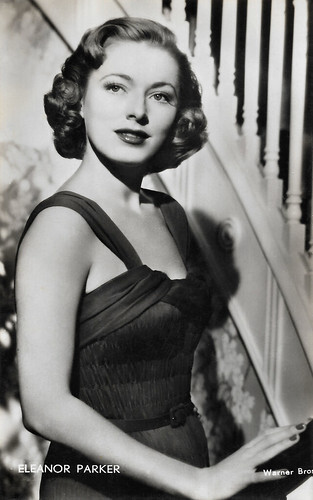
Dutch postcard. Photo: Warner Bros.
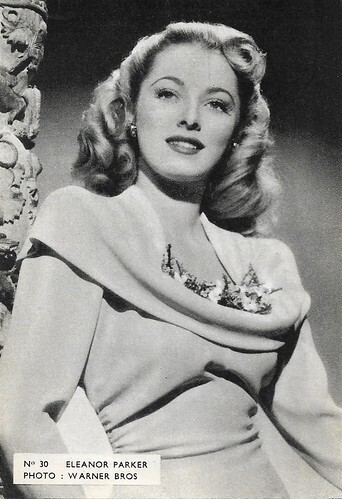
Belgian collectors card by Publicité Agence Bell, Brussels, for the Cinéma Montagne in Charleroi, no. 30. Photo: Warners Bros.
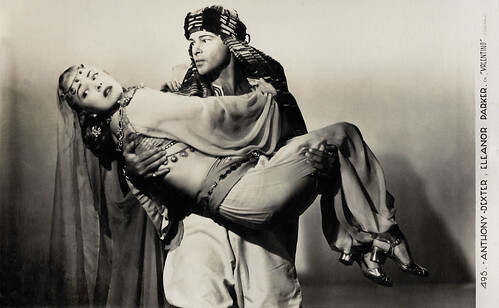
Spanish card, no. 495. Photo: Columbia. Anthony Dexter and Eleanor Parker in Valentino (Lewis Allen, 1951).
The Sound of Music
Eleanor Parker supported Frank Sinatra in a popular comedy, A Hole in the Head (Frank Capra, 1959). She returned to MGM for Home from the Hill (Vincente Minnelli, 1960), co-starring with Robert Mitchum , then took over Lana Turner 's role of Constance Rossi in Return to Peyton Place (José Ferrer, 1961), the sequel to the hit 1957 film. That was made by 20th Century Fox who also produced Madison Avenue (H. Bruce Humberstone, 1961) with Parker.
In 1960, she made her TV debut, and in the following years, she worked increasingly in television, with the occasional film role such as Panic Button (George Sherman, Giuliano Carnimeo, 1964) with Maurice Chevalier and Jayne Mansfield . Parker's best-known screen role is Baroness Elsa Schraeder in the Oscar-winning musical The Sound of Music (Robert Wise, 1965). The Baroness was famously and poignantly unsuccessful in keeping the affections of Captain Georg von Trapp (Christopher Plummer) after he falls in love with Maria ( Julie Andrews ).
In 1966, Parker played an alcoholic widow in the crime drama Warning Shot (Buzz Kulik, 1967), a talent scout who discovers a Hollywood star in The Oscar (Russell Rouse, 1966), and a rich alcoholic in An American Dream (Robert Gist, 1966). However, her film career seemed to go downhill. A Playboy Magazine reviewer derided the cast of The Oscar as "has-beens and never-will-be". From the late 1960s, she focused on television. In 1963, Parker appeared in the medical TV drama about psychiatry The Eleventh Hour in the episode Why Am I Grown So Cold?, for which she was nominated for an Emmy Award. She also appeared in episodes of Breaking Point (1964) and The Man from U.N.C.L.E. (1968). In 1969–1970, Parker starred in the television series Bracken's World, for which she was nominated for a 1970 Golden Globe Award.
Parker also appeared on stage in the role of Margo Channing in 'Applause', the Broadway musical version of the film All About Eve (Joseph L. Mankiewicz, 1950). In 1976, she played Maxine in a revival of 'The Night of the Iguana'. Her last film role was in a Farrah Fawcett bomb, Sunburn (Richard C. Sarafian, 1979). Subsequently, she appeared very infrequently on TV, most recently in Dead on the Money (Mark Cullingham, 1991).
Eleanor Parker was married four times. Her first husband was Fred Losee (1943-1944). Her second marriage to Bert E. Friedlob (1946-1953) produced three children Susan Eleanor Friedlob (1948), Sharon Anne Friedlob (1950), and Richard Parker Friedlob (1952). Her third marriage was to American portrait painter Paul Clemens (1954-1965) and the couple had one child, actor Paul Clemens (1958). Her fourth marriage with Raymond N. Hirsch (1966-2001) ended when Hirsch died of oesophagal cancer. She was the grandmother of actor/director Chasen Parker. Eleanor Parker died in 2013 at a medical facility in Palm Springs, California of complications of pneumonia. She was 91. Parker was raised a Protestant and later converted to Judaism, telling the New York Daily News columnist Kay Gardella in August 1969, "I think we're all Jews at heart ... I wanted to convert for a long time."
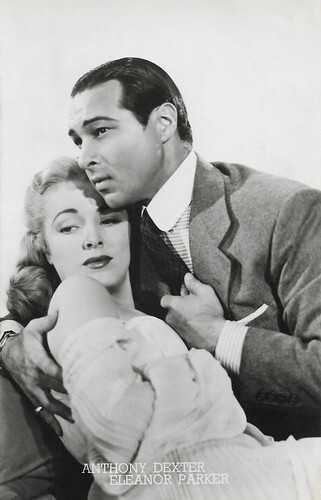
Belgian card, no. 751. Photo: Columbia. Anthony Dexter and Eleanor Parker in Valentino (Lewis Allen, 1951).
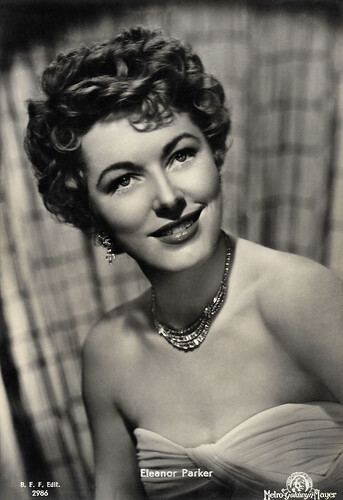
Italian postcard by B.F.F. Editore, no. 2986. Photo: MGM (Metro Goldwyn Mayer).
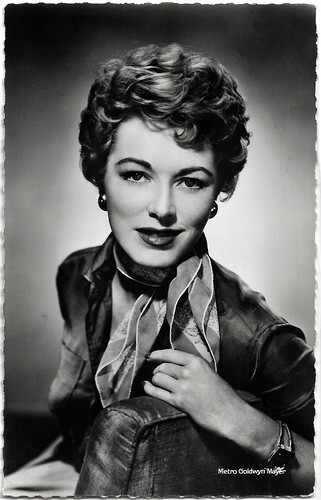
French postcard by Editions du Globe, no 485. Photo: Metro-Goldwyn-Mayer.
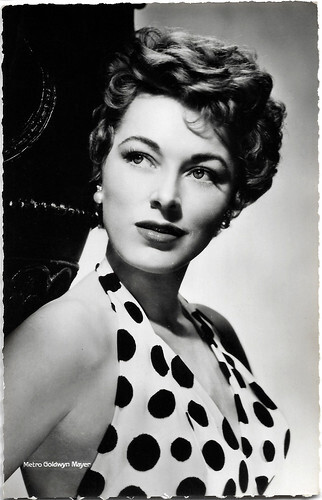
French postcard by Editions du Globe, no 486. Photo: Metro-Goldwyn-Mayer.
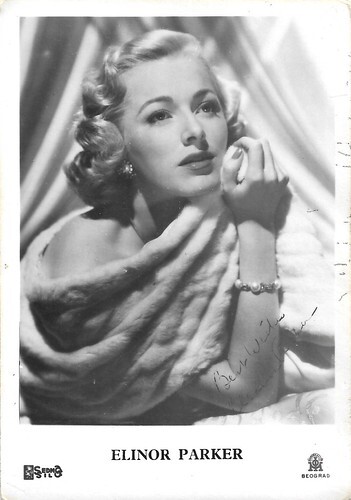
Yugoslavian postcard by Sedma Sila. Photo: IOM (Morava Film), Beograd (Belgrade).
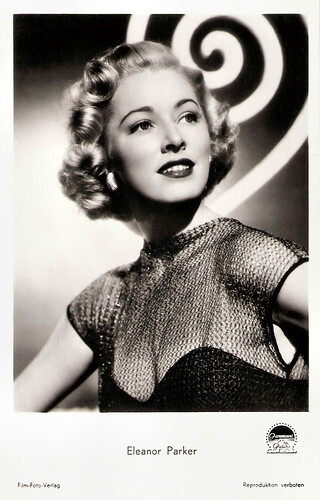
West German postcard by Film-Foto-Verlag, Berlin-Tempelhof, no. FK 258. Photo: Paramount.
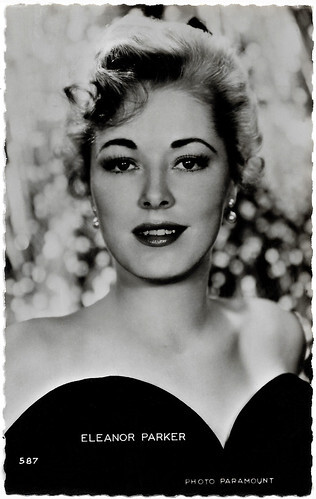
French postcard by Editions P.I., Paris, presented by Les Carbones Korès "Carboplane", no. 587. Photo: Paramount, 1955.
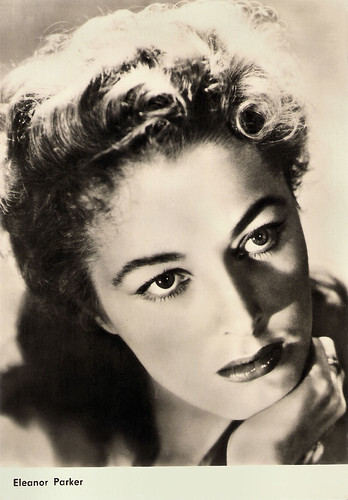
East-German postcard by VEB Progress Film-Vertrieb, Berlin, no. 2679. Eleanor Parker in The Man with the Golden Arm (Otto Preminger, 1955).
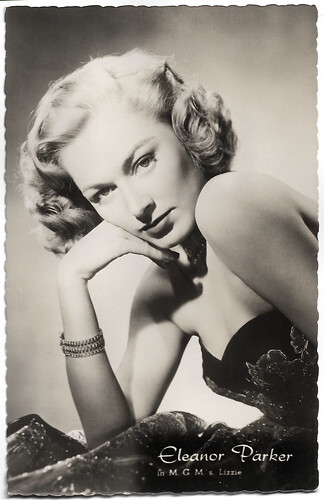
Dutch postcard. Photo: MGM. Eleanor Parker in Lizzie (Hugo Haas, 1957).
Sources: (IMDb), Wikipedia and .

Italian postcard by Rotalfoto, Milano, no. N. 107.

Spanish postcard by JDP, Valencia, no. 1375. Photo: Kirk Douglas and Eleanor Parker in Detective Story (William Wyler, 1951).

Belgian postcard, no. 551. Photo: Warner Bros.
Mission to Moscow
Eleanor Jean Parker was born in 1922, in Cedarville, Ohio. She was the daughter of Lola (Isett) and Lester Day Parker. Her family moved to East Cleveland, Ohio, where she attended public schools and graduated from Shaw High School. She appeared in a number of school plays. When she was 15 she started to attend the Rice Summer Theatre on Martha's Vineyard in Massachusetts.
After graduation, she moved to California and began appearing at the Pasadena Playhouse. There she was spotted by a Warners Bros talent scout, Irving Kumin. The studio signed her to a long-term contract in June 1941. She was cast that year in They Died with Their Boots On (Raoul Walsh, 1941), but her scenes were cut. Her actual film debut was as Nurse Ryan in the short Soldiers in White (B. Reeves Eason, 1942). She was given some decent roles in B films, Busses Roar (D. Ross Lederman, 1942) and The Mysterious Doctor (Benjamin Stoloff, 1943) opposite John Loder .
She also had a small role in one of Warner Brothers' biggest productions for the 1943 season, the pro-Soviet Mission to Moscow (Michael Curtiz, 1943) as Emlen Davies, daughter of the U.S. ambassador to the U.S.S.R (Walter Huston). On the set, she met her first husband, Navy Lieutenant Fred L. Losse, but the marriage turned out to be a brief wartime affair. Parker had impressed Warners enough to offer her a strong role in a prestige production, Between Two Worlds (Edward A. Blatt, 1944), playing the suicidal wife of Paul Henreid's character. She played support roles in Crime by Night (William Clemens, 1944) and The Last Ride (D. Ross Lederman, 1944).
Then she got the starring role opposite Dennis Morgan in The Very Thought of You (Delmer Daves, 1944). She was considered enough of a ‘name’ to be given a cameo in Hollywood Canteen (Delmer Daves, 1944). Warners gave her the choice role of Mildred Rogers in a new version of Somerset Maugham's Of Human Bondage (Edmund Goulding, 1946), but previews were not favourable and the film sat on the shelf for two years before being released. She had her big break when she was cast opposite John Garfield in Pride of the Marines (Delmer Daves, 1945). However, two films with Errol Flynn that followed, the romantic comedy Never Say Goodbye (James V. Kern, 1946) and the drama Escape Me Never (Peter Godfrey, 1947), were box office disappointments.
Parker was suspended twice by Warners for refusing parts in films – in Stallion Road (James V. Kern, 1947), where she was replaced by Alexis Smith and Love and Learn (Frederick De Cordova, 1947). She made the comedy Voice of the Turtle (Irving Rapper, 1947) with Ronald Reagan , and the mystery The Woman in White (Peter Godfrey, 1948). She refused to appear in Somewhere in the City (Vincent Sherman, 1950) so Warners suspended her again; Virginia Mayo played the role. Parker then had two years off, during which time she married and had a baby. She turned down a role in The Hasty Heart (Vincent Sherman, 1949) which she wanted to do, but it would have meant going to England and she did not want to leave her baby alone during its first year.

Belgian postcard. Photo: Warner Bros.

Vintage postcard, no. 92. Photo: M.G.M.

Belgian postcard, no. 950. Photo: Warner Bros.

French postcard by Editions P.I., Paris, no. 256. Photo: Warner Bros.

Spanish postcard, no. 2319.
Interrupted Melody
Eleanor Parker returned in Chain Lightning (Stuart Heisler, 1950) with Humphrey Bogart . Parker heard about a women-in-prison film Warners were making, Caged (John Cromwell, 1950), and actively lobbied for the role. She got it, won the 1950 Volpi Cup for Best Actress at the Venice Film Festival and was nominated for an Academy Award. She also had a good role in the melodrama Three Secrets (Robert Wise, 1950).
In February 1950, Parker left Warner Bros. after having been under contract there for eight years. Parker had understood that she would star in a film called Safe Harbor, but Warner Bros. apparently had no intention of making it. Because of this misunderstanding, her agents negotiated her release. Parker's career outside of Warners started badly with Valentino (Lewis Allen, 1951) playing a fictionalised wife of Rudolph Valentino for producer Edward Small. She tried a comedy at 20th Century Fox with Fred MacMurray , A Millionaire for Christy (George Marshall, 1951).
In 1951, Parker signed a contract with Paramount for one film a year, with an option for outside films. This arrangement began brilliantly with Detective Story (William Wyler, 1951) playing Mary McLeod, the woman who doesn't understand the position of her unstable detective husband ( Kirk Douglas ). Parker was nominated for the Oscar in 1951 for her performance. Parker followed Detective Story with her portrayal of an actress in love with a swashbuckling nobleman ( Stewart Granger ) in Scaramouche (George Sidney, 1952), a role originally intended for Ava Gardner . Wikipedia : “Parker later claimed that Granger was the only person she didn't get along with during her entire career. However, they had good chemistry and the film was a massive hit.“
MGM cast her into Above and Beyond (Melvin Frank, Norman Panama, 1952), a biopic of Lt. Col. Paul W. Tibbets, Jr. ( Robert Taylor ), the pilot of the aircraft that dropped the atomic bomb on Hiroshima. It was a solid hit. While Parker was making a third film for MGM, Escape from Fort Bravo (John Sturges, 1953), she signed a five-year contract with the studio. She was named as star of a Sidney Sheldon script, My Most Intimate Friend and of One More Time, from a script by Ruth Gordon and Garson Kanin directed by George Cukor, but neither film was made. Back at Paramount, Parker starred with Charlton Heston as a 1900s mail-order bride in The Naked Jungle (Byron Haskin, 1954), produced by George Pal. Parker returned to MGM where she was reunited with Robert Taylor in an Egyptian adventure film, Valley of the Kings (Robert Pirosh, 1954), and a Western, Many Rivers to Cross (Roy Rowland, 1955).
MGM gave her one of her best roles as opera singer Marjorie Lawrence struck down by polio in Interrupted Melody (Curtis Bernhardt, 1955). This was a big hit and earned Parker a third Oscar nomination; she later said it was her favourite film. Also in 1955, Parker appeared in the film adaptation of the National Book Award-winner The Man with the Golden Arm (Otto Preminger, 1955), released through United Artists. She played Zosh, the supposedly wheelchair-bound wife of heroin-addicted, would-be jazz drummer Frankie Machine ( Frank Sinatra ). It was a major commercial and critical success. In 1956, she co-starred with Clark Gable in the Western comedy The King and Four Queens (Raoul Walsh, 1956), also for United Artists. It was then back at MGM for two dramas: Lizzie (Hugo Haas, 1957), in the title role, as a woman with a split personality; and The Seventh Sin (Ronald Neame, 1957), a remake of The Painted Veil (Richard Boleslawski, 1934) in the role originated by Greta Garbo and, once again, intended for Ava Gardner . Both films flopped at the box office and, as a result, Parker's plans to produce her own film, L'Eternelle, about French resistance fighters, did not materialise.

British postcard in "The People' series by Show Parade Picture Service, London, no. P 1137. Photo: Warner Bros.

Dutch postcard. Photo: Warner Bros.

Belgian collectors card by Publicité Agence Bell, Brussels, for the Cinéma Montagne in Charleroi, no. 30. Photo: Warners Bros.

Spanish card, no. 495. Photo: Columbia. Anthony Dexter and Eleanor Parker in Valentino (Lewis Allen, 1951).
The Sound of Music
Eleanor Parker supported Frank Sinatra in a popular comedy, A Hole in the Head (Frank Capra, 1959). She returned to MGM for Home from the Hill (Vincente Minnelli, 1960), co-starring with Robert Mitchum , then took over Lana Turner 's role of Constance Rossi in Return to Peyton Place (José Ferrer, 1961), the sequel to the hit 1957 film. That was made by 20th Century Fox who also produced Madison Avenue (H. Bruce Humberstone, 1961) with Parker.
In 1960, she made her TV debut, and in the following years, she worked increasingly in television, with the occasional film role such as Panic Button (George Sherman, Giuliano Carnimeo, 1964) with Maurice Chevalier and Jayne Mansfield . Parker's best-known screen role is Baroness Elsa Schraeder in the Oscar-winning musical The Sound of Music (Robert Wise, 1965). The Baroness was famously and poignantly unsuccessful in keeping the affections of Captain Georg von Trapp (Christopher Plummer) after he falls in love with Maria ( Julie Andrews ).
In 1966, Parker played an alcoholic widow in the crime drama Warning Shot (Buzz Kulik, 1967), a talent scout who discovers a Hollywood star in The Oscar (Russell Rouse, 1966), and a rich alcoholic in An American Dream (Robert Gist, 1966). However, her film career seemed to go downhill. A Playboy Magazine reviewer derided the cast of The Oscar as "has-beens and never-will-be". From the late 1960s, she focused on television. In 1963, Parker appeared in the medical TV drama about psychiatry The Eleventh Hour in the episode Why Am I Grown So Cold?, for which she was nominated for an Emmy Award. She also appeared in episodes of Breaking Point (1964) and The Man from U.N.C.L.E. (1968). In 1969–1970, Parker starred in the television series Bracken's World, for which she was nominated for a 1970 Golden Globe Award.
Parker also appeared on stage in the role of Margo Channing in 'Applause', the Broadway musical version of the film All About Eve (Joseph L. Mankiewicz, 1950). In 1976, she played Maxine in a revival of 'The Night of the Iguana'. Her last film role was in a Farrah Fawcett bomb, Sunburn (Richard C. Sarafian, 1979). Subsequently, she appeared very infrequently on TV, most recently in Dead on the Money (Mark Cullingham, 1991).
Eleanor Parker was married four times. Her first husband was Fred Losee (1943-1944). Her second marriage to Bert E. Friedlob (1946-1953) produced three children Susan Eleanor Friedlob (1948), Sharon Anne Friedlob (1950), and Richard Parker Friedlob (1952). Her third marriage was to American portrait painter Paul Clemens (1954-1965) and the couple had one child, actor Paul Clemens (1958). Her fourth marriage with Raymond N. Hirsch (1966-2001) ended when Hirsch died of oesophagal cancer. She was the grandmother of actor/director Chasen Parker. Eleanor Parker died in 2013 at a medical facility in Palm Springs, California of complications of pneumonia. She was 91. Parker was raised a Protestant and later converted to Judaism, telling the New York Daily News columnist Kay Gardella in August 1969, "I think we're all Jews at heart ... I wanted to convert for a long time."

Belgian card, no. 751. Photo: Columbia. Anthony Dexter and Eleanor Parker in Valentino (Lewis Allen, 1951).

Italian postcard by B.F.F. Editore, no. 2986. Photo: MGM (Metro Goldwyn Mayer).

French postcard by Editions du Globe, no 485. Photo: Metro-Goldwyn-Mayer.

French postcard by Editions du Globe, no 486. Photo: Metro-Goldwyn-Mayer.

Yugoslavian postcard by Sedma Sila. Photo: IOM (Morava Film), Beograd (Belgrade).

West German postcard by Film-Foto-Verlag, Berlin-Tempelhof, no. FK 258. Photo: Paramount.

French postcard by Editions P.I., Paris, presented by Les Carbones Korès "Carboplane", no. 587. Photo: Paramount, 1955.

East-German postcard by VEB Progress Film-Vertrieb, Berlin, no. 2679. Eleanor Parker in The Man with the Golden Arm (Otto Preminger, 1955).

Dutch postcard. Photo: MGM. Eleanor Parker in Lizzie (Hugo Haas, 1957).
Sources: (IMDb), Wikipedia and .
Published on April 24, 2023 22:00
April 22, 2023
Scottish actor Ewan McGregor (1971) first received worldw...
Scottish actor Ewan McGregor (1971) first received worldwide acclaim with his role as heroin addict Mark Renton in Trainspotting (1996). Later, he played the young Obi-Wan in the Star Wars prequel trilogy and poet Christian in the musical Moulin Rouge! (2001).
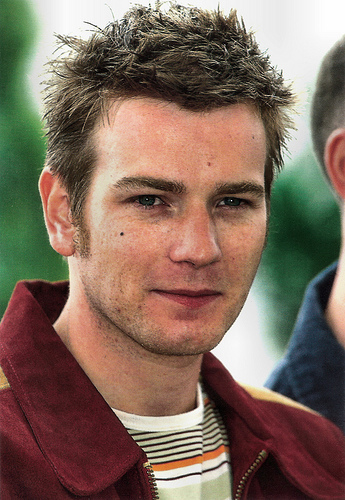
British postcard by Editions Limited, no. PRT-019.
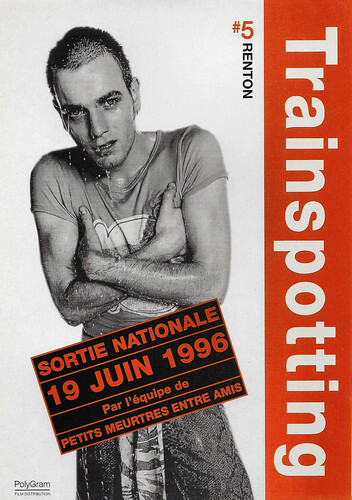
French promotion card by Cardcom. Photo: Liam Longman for Polygram Film Distribution. Promotion for Trainspotting (Danny Boyle, 1996).
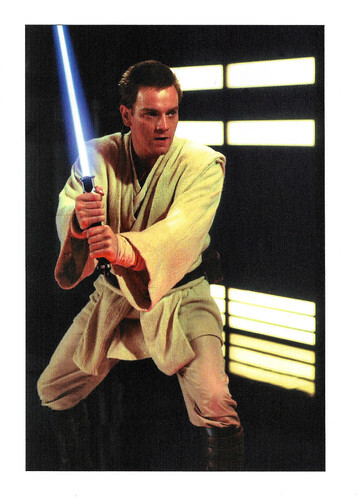
British double card by Danilo, London, no. SW032. Photo: Lucasfilm. Ewan McGregor as Obi-Wan Kenobi in Star Wars: Episode I - The Phantom Menace (George Lucas, 1999).
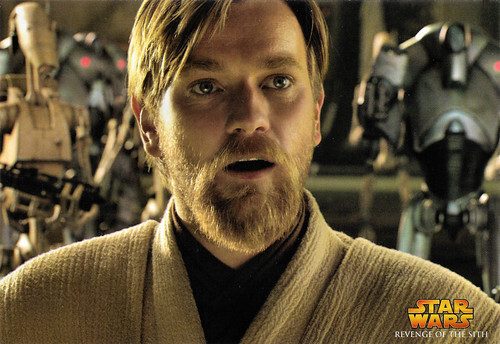
American postcard by Classico San Francisco, no. 106-138. Photo: Lucasfilm. Ewan McGregor as Obi-Wan Kenobi in Star Wars: Episode 3 - Revenge of the Sith (George Lucas, 2005).
Energetic, powerful and photogenic
Ewan Gordan McGregor was born in 1971 in Crieff, Scotland, just a few miles north of Edinburgh. His parents were the schoolteachers James Charles Stuart McGregor and Carole Diane Lawson. His uncle is actor Denis Lawson. He also has a brother Colin, who became an RAF pilot. As a child, Ewan did little acting, but enjoyed singing, and became a soloist for his school's orchestra and choir. At age 16, he left Morrison Academy in Crieff to join the Perth Repertory Theatre. His parents encouraged him to leave school and pursue his acting goals rather than be unhappy. Ewan worked as a stagehand and had small roles in the productions of the Perth Repertory Theatre. Then, he studied for three years at the Guildhall School of Music and Drama in London.
Six months prior to his graduation from Guildhall, he landed a major role as Private Mick Hopper in the excellent TV series Lipstick on Your Collar (Renny Rye, 1993), written by Dennis Potter. McGregor then starred in the miniseries The Scarlet & The Black (Ben Bolt, 1993), an adaptation of Henri Beyle Stendhal's 1830 novel. In that same year, McGregor made his film debut with a bit part in the American drama Being Human (Bill Forsyth, 1993), which starred Robin Williams . The film undeservedly flopped and closed almost as soon as it opened, which limited McGregor's exposure. He continued to make television appearances in the United States and Britain, including Family Style (Justin Chadwick, 1993), Doggin' Around (Desmond Davis, 1994) and an episode of the crime series Kavanagh QC (Colin Gregg, 1995).
He got his first major film role in the Noir Shallow Grave (Danny Boyle, 1994), which was received well by critics. Samuli Launonen at IMDb : “A great modern thriller containing all the necessary ingredients of a decent suspense story: constantly growing tension, sly humour, and genuinely surprising plot twists. (…) The three leads are all great, but there's no question about who the movie belongs to: Ewan McGregor is energetic, powerful and photogenic in his portrayal of a young journalist.” In 1995, McGregor married, French production designer Eve Mavrakis. He continued to work in British films as the surfing parable Blue Juice (Carl Prechezer, 1995) with Catherine Zeta-Jones , and Peter Greenaway's The Pillow Book (1996).
Then he had his big break with Trainspotting (1996), his second film with director Danny Boyle. McGregor shaved his head and lost 30 lbs to play the main character and heroin addict Mark Renton. The film, an adaptation of Irvine Welsh's novel, and McGregor's role received worldwide critical acclaim. Following this success, he took a completely different role as Frank Churchill in the Jane Austen adaptation Emma (Douglas McGrath, 1996), starring Gwyneth Paltrow. His next films included Brassed Off (Mark Herman, 1996), The Serpent's Kiss (Philippe Rousselot, 1997), A Life Less Ordinary (Danny Boyle, 1997), and Nightwatch (Ole Bornedal, 1998). He also acted opposite Jonathan Rhys Meyers and Christian Bale in Velvet Goldmine (Todd Haynes, 1999), as a 1970s-era glam rocker in the mode of Iggy Pop.
Ewan McGregor landed the largest role of his career when he signed on in 1998 as Obi-Wan Kenobi in the Star Wars prequel trilogy. McGregor already had a connection with the iconic movie series as his uncle, Denis Lawson, appeared as Wedge Antilles in the original three films. He studied Alec Guinness ' films in preparation for his role as Obi-Wan Kenobi to ensure accuracy in everything from his accent to the pacing of his words. Star Wars: Episode I - The Phantom Menace (George Lucas, 1999) was a box-office blockbuster, which launched the then 28-year-old actor into mega-stardom. The next two instalments of the trilogy would follow years later.
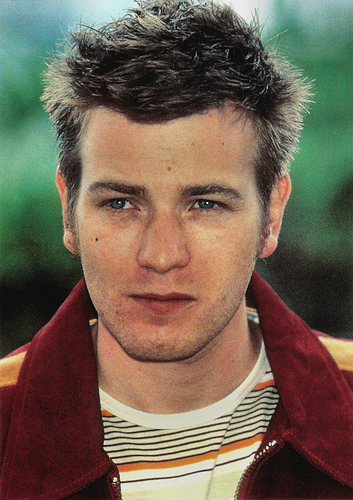
British postcard by Heroes Publishing Ltd., London, no. SFC 3096.
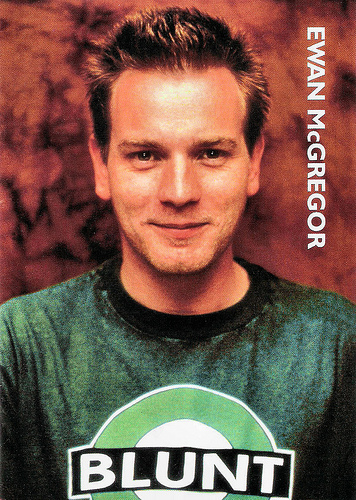
British postcard by Pyramid, Leicester, no. PC 2111.
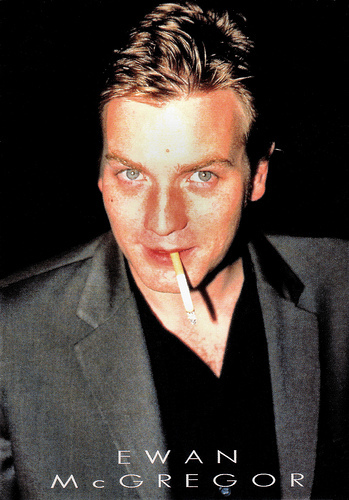
British postcard by Anabas, Essex, no. AP 749, 1999.
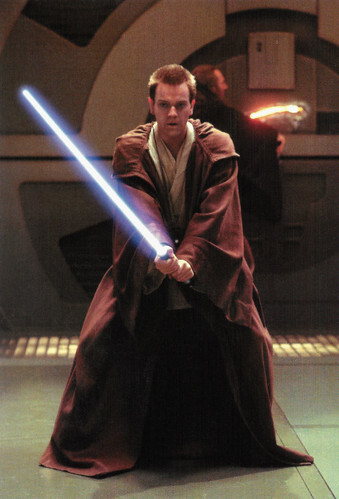
American postcard by Classico San Francisco, no. 106-035. Photo: Lucasfilm. Ewan McGregor as Obi-Wan Kenobi in Star Wars: Episode I - The Phantom Menace (George Lucas, 1999).
Another challenging role
In the early 21st century, Ewan McGregor started his own production company called Natural Nylon. He founded it with fellow actors Jude Law, Sadie Frost, Jonny Lee Miller and Sean Pertwee. The group's first film was the biopic Nora (Pat Murphy, 2000), which dramatised the real-life relationship between Irish author James Joyce and Nora Barnacle. McGregor starred as Joyce opposite Susan Lynch as Barnacle. McGregor took on another challenging role in the musical Moulin Rouge! (Baz Luhrmann, 2000), set in Paris in 1899. McGregor starred as the young poet Christian, who falls in love with the terminally-ill courtesan Satine, played by Nicole Kidman .
Perry Seibert at AllMovie : “A bold artistic statement, Moulin Rouge is Baz Luhrmann's first masterpiece. Frantically edited, paced, and photographed, the film is not an easy undertaking; it forces the viewer to accept it on its terms. The sets, costumes, and sound are stylish in the extreme. The greatest risk the film takes is having the characters speak predominantly in song lyrics. The young writer Christian (Ewan McGregor) and the doomed performer Satine ( Nicole Kidman ) argue about whether they will fall in love while telling each other, 'Love lifts us up where we belong' and 'I will always love you.' When they aren't speaking in song lyrics, they sing to each other, with McGregor doing a better than credible job with Elton John's 'Your Song'.”
McGregor was nominated for a Golden Globe Award for Best Actor for his part and a Screen Actors Guild Award for Outstanding Performance by a Cast. Later that same year, the war film Black Hawk Down (Ridley Scott, 2001) was released with McGregor among an ensemble cast. He continued his role as Obi-Wan Kenobi in the second film of the trilogy, Star Wars: Episode II - Attack of the Clone (George Lucas, 2002), which was another commercial success.
McGregor was able to parlay his popularity into many more films. When Tim Burton was looking for someone in McGregor's age range to play Albert Finney as a young man in the fantasy film Big Fish (2003), he was given the part. The film was a critical and commercial success as well. McGregor also starred in the drama Young Adam (David Mackenzie, 2003). He played Joe Taylor, one of two barge workers who pull up the corpse of a young woman from a river. Also that year, McGregor and Renée Zellweger starred in Down With Love (Peyton Reed, 2003), a homage to 1960s romantic comedies.
In 2004, McGregor and his best friend Charley Boorman created a documentary about riding their motorcycles from London to New York. The pair travelled east through Europe and Asia and then flew to Alaska to finish the journey to New York. The entire journey, entitled Long Way Round, covered over 19,000 miles and 12 countries. The project was conceived partly to raise awareness of the worldwide efforts of UNICEF. McGregor reprised his role as Obi-Wan Kenobi for the final time in Star Wars: Episode III - Revenge of the Sith (George Lucas, 2005). He also lent his voice to the animated family film Robots (Chris Wedge, Carlos Saldanha, 2005), starred with Scarlett Johansson in the big-budget Sci-Fi actioner The Island (Michael Bay, 2005), and filmed the psychological thriller Stay (Marc Forster, 2005).
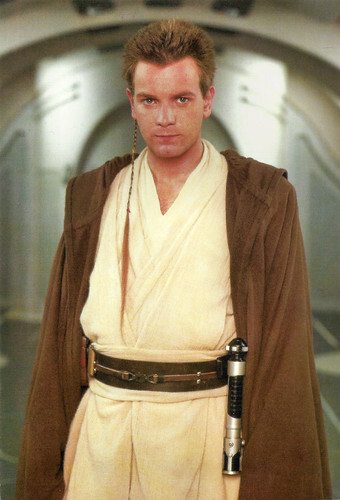
American postcard by Classico San Francisco, no. 106-015. Photo: Lucasfilm. Ewan McGregor as Obi-Wan-Kenobi in Star Wars: Episode I - The Phantom Menace (George Lucas, 1999).
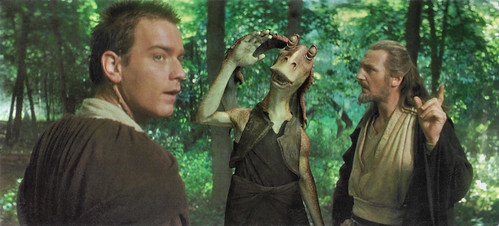
American postcard by Classico San Francisco, no. 490-003. Photo: Lucasfilm. Ewan McGregor as Obi-Wan Kenobi, Ahmed Best as Jar Jar Binks and Liam Neeson as Qui-Gon Jinn in Star Wars: Episode I - The Phantom Menace (George Lucas, 1999).
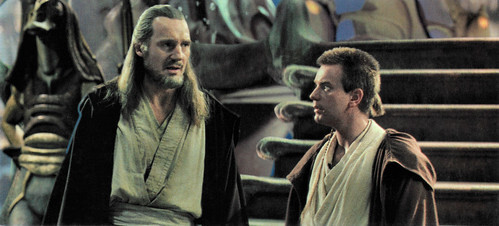
American postcard by Classico San Francisco, no. 490-020. Photo: Lucasfilm. Liam Neeson as Qui-Gon Jinn and Ewan McGregor as Obi-Wan Kenobi in Star Wars: Episode I - The Phantom Menace (George Lucas, 1999).
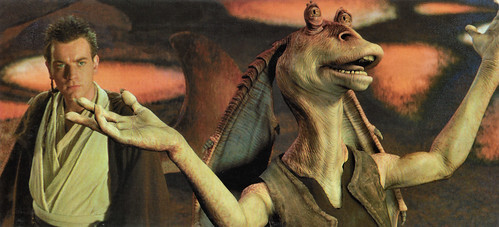
American postcard by Classico San Francisco, no. 490-027. Photo: Lucasfilm. Ewan McGregor as Obi-Wan Kenobi and Ahmed Best as Jar Jar Binks in Star Wars: Episode I - The Phantom Menace (George Lucas, 1999).
Amazingly good
After multiple commercial and critical successes, Ewan McGregor tried his hand at two arthouse films in 2006. His first was Scenes of a Sexual Nature, Ed Blum's directorial debut about a day in the life of seven British couples. The second was Miss Potter (Chris Noonan, 2007), a biopic on the life of popular author Beatrix Potter (Renée Zellweger). McGregor portrays Norman, her editor and paramour. He also tried his hand at stage acting. From 2005 to 2007 he played Sky Masterson in the revival of Guys & Dolls at London's Piccadilly Theatre, and for this part, he was nominated for a Laurence Olivier Award for Best Actor in a Musical in 2007. He also appeared on stage as Iago in Othello (2007–2008).
In between, McGregor and Boorman created a follow-up documentary to their 2004 trip. For Long Way Down (2007), they rode their motorcycles from John o' Groats in northern Scotland to Cape Town, South Africa. Next, he appeared in the films Cassandra's Dream (Woody Allen, 2007) with Colin Farrell, Incendiary (Sharon Maguire, 2008) and Deception (Marcel Langenegger, 2008) with Hugh Jackman. McGregor starred with Jim Carrey as a gay couple in I Love You Phillip Morris (Glenn Ficarra, John Requa, 2009), and appeared in the blockbuster Angels & Demons (Ron Howard, 2009), the sequel to the popular Dan Brown novel and film, The DaVinci Code. For the title role in Roman Polanski's The Ghost Writer (2010), he won the Best Actor award at the 23rd European Film Awards.
Bruce Eder at AllMovie : “McGregor is amazingly good in a role that gives him relatively little to work with - he is a character that not only has no name, but no past to speak of and no family entanglements, so his experience shouldn't resonate much with the audience. But what should become a cipher that few can penetrate instead becomes a kind of big-screen everyman for audience members to relate to - up to a point. This is a very cold movie at its centre, very distant, despite McGregor's success at fleshing out a character that is hardly more than a skeleton, in terms of what he brings to us. He's just vulnerable enough, and surprised and sceptical enough - about what he's been asked to do, and the world of politics to which he's been asked to enter - to give us something to grab on to.”
His later films include Beginners (Mike Mills, 2010), Perfect Sense (David Mackenzie, 2011) opposite Eva Green, the British romantic comedy-drama Salmon Fishing in the Yemen (Lasse Hallström, 2011), Lo imposible (J.A. Bayona, 2012), and August: Osage County (John Wells, 2013). He was awarded the OBE (Officer of the Order of the British Empire) in the 2013 Queen's New Years Honours List for his services to drama and charity. Ewan McGregor and his wife have three daughters: Clara Mathilde (1996), Esther Rose (2001), and 4-year-old Jamiyan adopted from Mongolia in 2006. He became an American citizen in 2016.
His more recent films include the Miles Davis biopic Miles Ahead (Don Cheadle, 2015) and the British thriller Our Kind of Traitor (Susanna White, 2016). He returned as Mark Renton in T2: Trainspotting (Danny Boyle, 2017). On TV he starred in the third season of the hit series Fargo (2017). In 2019, McGregor starred as the older Danny Torrance in Doctor Sleep (Mike Flanagan, 2019), the film adaptation of Stephen King's novel of the same name. In 2021, McGregor created a charismatic portrait of the American fashion designer Halston in the Netflix miniseries Halston (Daniel Minahan, 2021), based on the biography 'Simply Halston' by journalist Steven Gaines. McGregor was also billed as executive producer, jointly with Ryan Murphy.
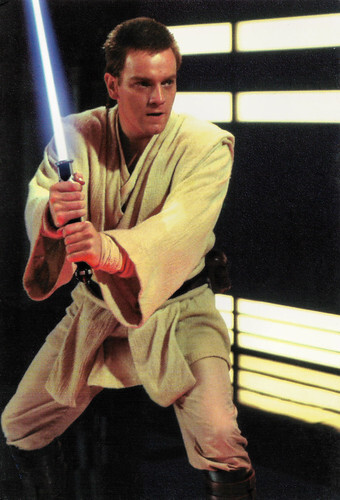
American postcard by Classico San Francisco, no. 106-002. Photo: Lucasfilm. Ewan McGregor as Obi-Wan Kenobi in Star Wars: Episode I - The Phantom Menace (George Lucas, 1999).
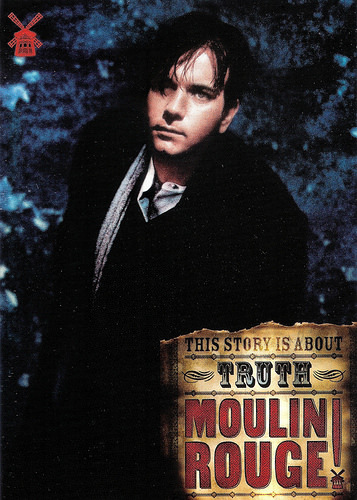
British postcard by Go Card. Photo: 20th Century Fox. Publicity still for Moulin Rouge! (Baz Luhrmann, 2001)
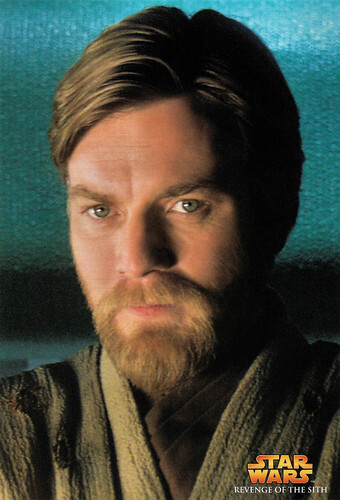
American postcard by Classico San Francisco, no. 106-117. Photo: Lucasfilm. Ewan McGregor as Obi-Wan Kenobi in Star Wars: Episode 3 - Revenge of the Sith (George Lucas, 2005).
Trailer Trainspotting (1996). Source: Movieclips Trailer Vault (YouTube).
Trailer Moulin Rouge! (2001). Source: Athena Stamos (YouTube).
Trailer The Ghost Writer (2010). Source: Movieclips Trailer Vault (YouTube).
Sources: Samuli Launonen (IMDb), Perry Seibert (AllMovie), Bruce Eder (AllMovie), Biography.com, AllMovie, Wikipedia and .

British postcard by Editions Limited, no. PRT-019.

French promotion card by Cardcom. Photo: Liam Longman for Polygram Film Distribution. Promotion for Trainspotting (Danny Boyle, 1996).

British double card by Danilo, London, no. SW032. Photo: Lucasfilm. Ewan McGregor as Obi-Wan Kenobi in Star Wars: Episode I - The Phantom Menace (George Lucas, 1999).

American postcard by Classico San Francisco, no. 106-138. Photo: Lucasfilm. Ewan McGregor as Obi-Wan Kenobi in Star Wars: Episode 3 - Revenge of the Sith (George Lucas, 2005).
Energetic, powerful and photogenic
Ewan Gordan McGregor was born in 1971 in Crieff, Scotland, just a few miles north of Edinburgh. His parents were the schoolteachers James Charles Stuart McGregor and Carole Diane Lawson. His uncle is actor Denis Lawson. He also has a brother Colin, who became an RAF pilot. As a child, Ewan did little acting, but enjoyed singing, and became a soloist for his school's orchestra and choir. At age 16, he left Morrison Academy in Crieff to join the Perth Repertory Theatre. His parents encouraged him to leave school and pursue his acting goals rather than be unhappy. Ewan worked as a stagehand and had small roles in the productions of the Perth Repertory Theatre. Then, he studied for three years at the Guildhall School of Music and Drama in London.
Six months prior to his graduation from Guildhall, he landed a major role as Private Mick Hopper in the excellent TV series Lipstick on Your Collar (Renny Rye, 1993), written by Dennis Potter. McGregor then starred in the miniseries The Scarlet & The Black (Ben Bolt, 1993), an adaptation of Henri Beyle Stendhal's 1830 novel. In that same year, McGregor made his film debut with a bit part in the American drama Being Human (Bill Forsyth, 1993), which starred Robin Williams . The film undeservedly flopped and closed almost as soon as it opened, which limited McGregor's exposure. He continued to make television appearances in the United States and Britain, including Family Style (Justin Chadwick, 1993), Doggin' Around (Desmond Davis, 1994) and an episode of the crime series Kavanagh QC (Colin Gregg, 1995).
He got his first major film role in the Noir Shallow Grave (Danny Boyle, 1994), which was received well by critics. Samuli Launonen at IMDb : “A great modern thriller containing all the necessary ingredients of a decent suspense story: constantly growing tension, sly humour, and genuinely surprising plot twists. (…) The three leads are all great, but there's no question about who the movie belongs to: Ewan McGregor is energetic, powerful and photogenic in his portrayal of a young journalist.” In 1995, McGregor married, French production designer Eve Mavrakis. He continued to work in British films as the surfing parable Blue Juice (Carl Prechezer, 1995) with Catherine Zeta-Jones , and Peter Greenaway's The Pillow Book (1996).
Then he had his big break with Trainspotting (1996), his second film with director Danny Boyle. McGregor shaved his head and lost 30 lbs to play the main character and heroin addict Mark Renton. The film, an adaptation of Irvine Welsh's novel, and McGregor's role received worldwide critical acclaim. Following this success, he took a completely different role as Frank Churchill in the Jane Austen adaptation Emma (Douglas McGrath, 1996), starring Gwyneth Paltrow. His next films included Brassed Off (Mark Herman, 1996), The Serpent's Kiss (Philippe Rousselot, 1997), A Life Less Ordinary (Danny Boyle, 1997), and Nightwatch (Ole Bornedal, 1998). He also acted opposite Jonathan Rhys Meyers and Christian Bale in Velvet Goldmine (Todd Haynes, 1999), as a 1970s-era glam rocker in the mode of Iggy Pop.
Ewan McGregor landed the largest role of his career when he signed on in 1998 as Obi-Wan Kenobi in the Star Wars prequel trilogy. McGregor already had a connection with the iconic movie series as his uncle, Denis Lawson, appeared as Wedge Antilles in the original three films. He studied Alec Guinness ' films in preparation for his role as Obi-Wan Kenobi to ensure accuracy in everything from his accent to the pacing of his words. Star Wars: Episode I - The Phantom Menace (George Lucas, 1999) was a box-office blockbuster, which launched the then 28-year-old actor into mega-stardom. The next two instalments of the trilogy would follow years later.

British postcard by Heroes Publishing Ltd., London, no. SFC 3096.

British postcard by Pyramid, Leicester, no. PC 2111.

British postcard by Anabas, Essex, no. AP 749, 1999.

American postcard by Classico San Francisco, no. 106-035. Photo: Lucasfilm. Ewan McGregor as Obi-Wan Kenobi in Star Wars: Episode I - The Phantom Menace (George Lucas, 1999).
Another challenging role
In the early 21st century, Ewan McGregor started his own production company called Natural Nylon. He founded it with fellow actors Jude Law, Sadie Frost, Jonny Lee Miller and Sean Pertwee. The group's first film was the biopic Nora (Pat Murphy, 2000), which dramatised the real-life relationship between Irish author James Joyce and Nora Barnacle. McGregor starred as Joyce opposite Susan Lynch as Barnacle. McGregor took on another challenging role in the musical Moulin Rouge! (Baz Luhrmann, 2000), set in Paris in 1899. McGregor starred as the young poet Christian, who falls in love with the terminally-ill courtesan Satine, played by Nicole Kidman .
Perry Seibert at AllMovie : “A bold artistic statement, Moulin Rouge is Baz Luhrmann's first masterpiece. Frantically edited, paced, and photographed, the film is not an easy undertaking; it forces the viewer to accept it on its terms. The sets, costumes, and sound are stylish in the extreme. The greatest risk the film takes is having the characters speak predominantly in song lyrics. The young writer Christian (Ewan McGregor) and the doomed performer Satine ( Nicole Kidman ) argue about whether they will fall in love while telling each other, 'Love lifts us up where we belong' and 'I will always love you.' When they aren't speaking in song lyrics, they sing to each other, with McGregor doing a better than credible job with Elton John's 'Your Song'.”
McGregor was nominated for a Golden Globe Award for Best Actor for his part and a Screen Actors Guild Award for Outstanding Performance by a Cast. Later that same year, the war film Black Hawk Down (Ridley Scott, 2001) was released with McGregor among an ensemble cast. He continued his role as Obi-Wan Kenobi in the second film of the trilogy, Star Wars: Episode II - Attack of the Clone (George Lucas, 2002), which was another commercial success.
McGregor was able to parlay his popularity into many more films. When Tim Burton was looking for someone in McGregor's age range to play Albert Finney as a young man in the fantasy film Big Fish (2003), he was given the part. The film was a critical and commercial success as well. McGregor also starred in the drama Young Adam (David Mackenzie, 2003). He played Joe Taylor, one of two barge workers who pull up the corpse of a young woman from a river. Also that year, McGregor and Renée Zellweger starred in Down With Love (Peyton Reed, 2003), a homage to 1960s romantic comedies.
In 2004, McGregor and his best friend Charley Boorman created a documentary about riding their motorcycles from London to New York. The pair travelled east through Europe and Asia and then flew to Alaska to finish the journey to New York. The entire journey, entitled Long Way Round, covered over 19,000 miles and 12 countries. The project was conceived partly to raise awareness of the worldwide efforts of UNICEF. McGregor reprised his role as Obi-Wan Kenobi for the final time in Star Wars: Episode III - Revenge of the Sith (George Lucas, 2005). He also lent his voice to the animated family film Robots (Chris Wedge, Carlos Saldanha, 2005), starred with Scarlett Johansson in the big-budget Sci-Fi actioner The Island (Michael Bay, 2005), and filmed the psychological thriller Stay (Marc Forster, 2005).

American postcard by Classico San Francisco, no. 106-015. Photo: Lucasfilm. Ewan McGregor as Obi-Wan-Kenobi in Star Wars: Episode I - The Phantom Menace (George Lucas, 1999).

American postcard by Classico San Francisco, no. 490-003. Photo: Lucasfilm. Ewan McGregor as Obi-Wan Kenobi, Ahmed Best as Jar Jar Binks and Liam Neeson as Qui-Gon Jinn in Star Wars: Episode I - The Phantom Menace (George Lucas, 1999).

American postcard by Classico San Francisco, no. 490-020. Photo: Lucasfilm. Liam Neeson as Qui-Gon Jinn and Ewan McGregor as Obi-Wan Kenobi in Star Wars: Episode I - The Phantom Menace (George Lucas, 1999).

American postcard by Classico San Francisco, no. 490-027. Photo: Lucasfilm. Ewan McGregor as Obi-Wan Kenobi and Ahmed Best as Jar Jar Binks in Star Wars: Episode I - The Phantom Menace (George Lucas, 1999).
Amazingly good
After multiple commercial and critical successes, Ewan McGregor tried his hand at two arthouse films in 2006. His first was Scenes of a Sexual Nature, Ed Blum's directorial debut about a day in the life of seven British couples. The second was Miss Potter (Chris Noonan, 2007), a biopic on the life of popular author Beatrix Potter (Renée Zellweger). McGregor portrays Norman, her editor and paramour. He also tried his hand at stage acting. From 2005 to 2007 he played Sky Masterson in the revival of Guys & Dolls at London's Piccadilly Theatre, and for this part, he was nominated for a Laurence Olivier Award for Best Actor in a Musical in 2007. He also appeared on stage as Iago in Othello (2007–2008).
In between, McGregor and Boorman created a follow-up documentary to their 2004 trip. For Long Way Down (2007), they rode their motorcycles from John o' Groats in northern Scotland to Cape Town, South Africa. Next, he appeared in the films Cassandra's Dream (Woody Allen, 2007) with Colin Farrell, Incendiary (Sharon Maguire, 2008) and Deception (Marcel Langenegger, 2008) with Hugh Jackman. McGregor starred with Jim Carrey as a gay couple in I Love You Phillip Morris (Glenn Ficarra, John Requa, 2009), and appeared in the blockbuster Angels & Demons (Ron Howard, 2009), the sequel to the popular Dan Brown novel and film, The DaVinci Code. For the title role in Roman Polanski's The Ghost Writer (2010), he won the Best Actor award at the 23rd European Film Awards.
Bruce Eder at AllMovie : “McGregor is amazingly good in a role that gives him relatively little to work with - he is a character that not only has no name, but no past to speak of and no family entanglements, so his experience shouldn't resonate much with the audience. But what should become a cipher that few can penetrate instead becomes a kind of big-screen everyman for audience members to relate to - up to a point. This is a very cold movie at its centre, very distant, despite McGregor's success at fleshing out a character that is hardly more than a skeleton, in terms of what he brings to us. He's just vulnerable enough, and surprised and sceptical enough - about what he's been asked to do, and the world of politics to which he's been asked to enter - to give us something to grab on to.”
His later films include Beginners (Mike Mills, 2010), Perfect Sense (David Mackenzie, 2011) opposite Eva Green, the British romantic comedy-drama Salmon Fishing in the Yemen (Lasse Hallström, 2011), Lo imposible (J.A. Bayona, 2012), and August: Osage County (John Wells, 2013). He was awarded the OBE (Officer of the Order of the British Empire) in the 2013 Queen's New Years Honours List for his services to drama and charity. Ewan McGregor and his wife have three daughters: Clara Mathilde (1996), Esther Rose (2001), and 4-year-old Jamiyan adopted from Mongolia in 2006. He became an American citizen in 2016.
His more recent films include the Miles Davis biopic Miles Ahead (Don Cheadle, 2015) and the British thriller Our Kind of Traitor (Susanna White, 2016). He returned as Mark Renton in T2: Trainspotting (Danny Boyle, 2017). On TV he starred in the third season of the hit series Fargo (2017). In 2019, McGregor starred as the older Danny Torrance in Doctor Sleep (Mike Flanagan, 2019), the film adaptation of Stephen King's novel of the same name. In 2021, McGregor created a charismatic portrait of the American fashion designer Halston in the Netflix miniseries Halston (Daniel Minahan, 2021), based on the biography 'Simply Halston' by journalist Steven Gaines. McGregor was also billed as executive producer, jointly with Ryan Murphy.

American postcard by Classico San Francisco, no. 106-002. Photo: Lucasfilm. Ewan McGregor as Obi-Wan Kenobi in Star Wars: Episode I - The Phantom Menace (George Lucas, 1999).

British postcard by Go Card. Photo: 20th Century Fox. Publicity still for Moulin Rouge! (Baz Luhrmann, 2001)

American postcard by Classico San Francisco, no. 106-117. Photo: Lucasfilm. Ewan McGregor as Obi-Wan Kenobi in Star Wars: Episode 3 - Revenge of the Sith (George Lucas, 2005).
Trailer Trainspotting (1996). Source: Movieclips Trailer Vault (YouTube).
Trailer Moulin Rouge! (2001). Source: Athena Stamos (YouTube).
Trailer The Ghost Writer (2010). Source: Movieclips Trailer Vault (YouTube).
Sources: Samuli Launonen (IMDb), Perry Seibert (AllMovie), Bruce Eder (AllMovie), Biography.com, AllMovie, Wikipedia and .
Published on April 22, 2023 22:00
Ewan McGregor
Scottish actor Ewan McGregor (1971) first received worldwide acclaim with his role as heroin addict Mark Renton in Trainspotting (1996). Later, he played the young Obi-Wan in the Star Wars prequel trilogy and poet Christian in the musical Moulin Rouge! (2001).

British postcard by Editions Limited, no. PRT-019.

French promotion card by Cardcom. Photo: Liam Longman for Polygram Film Distribution. Promotion for Trainspotting (Danny Boyle, 1996).

British double card by Danilo, London, no. SW032. Photo: Lucasfilm. Ewan McGregor as Obi-Wan Kenobi in Star Wars: Episode I - The Phantom Menace (George Lucas, 1999).

American postcard by Classico San Francisco, no. 106-138. Photo: Lucasfilm. Ewan McGregor as Obi-Wan Kenobi in Star Wars: Episode 3 - Revenge of the Sith (George Lucas, 2005).
Energetic, powerful and photogenic
Ewan Gordan McGregor was born in 1971 in Crieff, Scotland, just a few miles north of Edinburgh. His parents were the schoolteachers James Charles Stuart McGregor and Carole Diane Lawson. His uncle is actor Denis Lawson. He also has a brother Colin, who became an RAF pilot.
As a child, Ewan did little acting, but enjoyed singing, and became a soloist for his school's orchestra and choir. At age 16, he left Morrison Academy in Crieff to join the Perth Repertory Theatre. His parents encouraged him to leave school and pursue his acting goals rather than be unhappy. Ewan worked as a stagehand and had small roles in the productions of the Perth Repertory Theatre. Then, he studied for three years at the Guildhall School of Music and Drama in London.
Six months prior to his graduation from Guildhall, he landed a major role as Private Mick Hopper in the excellent TV series Lipstick on Your Collar (Renny Rye, 1993), written by Dennis Potter. McGregor then starred in the miniseries The Scarlet & The Black (Ben Bolt, 1993), an adaptation of Henri Beyle Stendhal's 1830 novel.
In that same year, McGregor made his film debut with a bit part in the American drama Being Human (Bill Forsyth, 1993), which starred Robin Williams . The film undeservedly flopped and closed almost as soon as it opened, which limited McGregor's exposure. He continued to make television appearances in the United States and Britain, including Family Style (Justin Chadwick, 1993), Doggin' Around (Desmond Davis, 1994) and an episode of the crime series Kavanagh QC (Colin Gregg, 1995).
He got his first major film role in the Noir Shallow Grave (Danny Boyle, 1994), which was received well by critics. Samuli Launonen at IMDb : “A great modern thriller containing all the necessary ingredients of a decent suspense story: constantly growing tension, sly humour, and genuinely surprising plot twists. (…) The three leads are all great, but there's no question about who the movie belongs to: Ewan McGregor is energetic, powerful and photogenic in his portrayal of a young journalist.”
In 1995, McGregor married, French production designer Eve Mavrakis. He continued to work in British films as the surfing parable Blue Juice (Carl Prechezer, 1995) with Catherine Zeta-Jones , and Peter Greenaway's The Pillow Book (1996).
Then he had his big break with Trainspotting (1996), his second film with director Danny Boyle. McGregor shaved his head and lost 30 lbs to play the main character and heroin addict Mark Renton. The film, an adaptation of Irvine Welsh's novel, and McGregor's role received worldwide critical acclaim.
Following this success, he took a completely different role as Frank Churchill in the Jane Austen adaptation Emma (Douglas McGrath, 1996), starring Gwyneth Paltrow. His next films included Brassed Off (Mark Herman, 1996), The Serpent's Kiss (Philippe Rousselot, 1997), A Life Less Ordinary (Danny Boyle, 1997), and Nightwatch (Ole Bornedal, 1998). He also acted opposite Jonathan Rhys Meyers and Christian Bale in Velvet Goldmine (Todd Haynes, 1999), as a 1970s-era glam rocker in the mode of Iggy Pop.
Ewan McGregor landed the largest role of his career when he signed on in 1998 as Obi-Wan Kenobi in the Star Wars prequel trilogy. McGregor already had a connection with the iconic movie series as his uncle, Denis Lawson, appeared as Wedge Antilles in the original three films. He studied Alec Guinness ' films in preparation for his role as Obi-Wan Kenobi to ensure accuracy in everything from his accent to the pacing of his words. Star Wars: Episode I - The Phantom Menace (George Lucas, 1999) was a box-office blockbuster, which launched the then 28-year-old actor into mega-stardom. The next two instalments of the trilogy would follow years later.

British postcard by Heroes Publishing Ltd., London, no. SFC 3096.

British postcard by Pyramid, Leicester, no. PC 2111.

British postcard by Anabas, Essex, no. AP 749, 1999.

American postcard by Classico San Francisco, no. 106-035. Photo: Lucasfilm. Ewan McGregor as Obi-Wan Kenobi in Star Wars: Episode I - The Phantom Menace (George Lucas, 1999).
Another challenging role
In the early 21st century, Ewan McGregor started his own production company called Natural Nylon. He founded it with fellow actors Jude Law, Sadie Frost, Jonny Lee Miller and Sean Pertwee. The group's first film was the biopic Nora (Pat Murphy, 2000), which dramatised the real-life relationship between Irish author James Joyce and Nora Barnacle. McGregor starred as Joyce opposite Susan Lynch as Barnacle.
McGregor took on another challenging role in the musical Moulin Rouge! (Baz Luhrmann, 2000), set in Paris in 1899. McGregor starred as the young poet Christian, who falls in love with the terminally-ill courtesan Satine, played by Nicole Kidman.
Perry Seibert at AllMovie : “A bold artistic statement, Moulin Rouge is Baz Luhrmann's first masterpiece. Frantically edited, paced, and photographed, the film is not an easy undertaking; it forces the viewer to accept it on its terms. The sets, costumes, and sound are stylish in the extreme. The greatest risk the film takes is having the characters speak predominantly in song lyrics. The young writer Christian (Ewan McGregor) and the doomed performer Satine (Nicole Kidman) argue about whether they will fall in love while telling each other, 'Love lifts us up where we belong' and 'I will always love you.' When they aren't speaking in song lyrics, they sing to each other, with McGregor doing a better than credible job with Elton John's 'Your Song'.”
McGregor was nominated for a Golden Globe Award for Best Actor for his part and a Screen Actors Guild Award for Outstanding Performance by a Cast. Later that same year, the war film Black Hawk Down (Ridley Scott, 2001) was released with McGregor among an ensemble cast. He continued his role as Obi-Wan Kenobi in the second film of the trilogy, Star Wars: Episode II - Attack of the Clone (George Lucas, 2002), which was another commercial success.
McGregor was able to parlay his popularity into many more films. When Tim Burton was looking for someone in McGregor's age range to play Albert Finney as a young man in the fantasy film Big Fish (2003), he was given the part. The film was a critical and commercial success as well. McGregor also starred in the drama Young Adam (David Mackenzie, 2003). He played Joe Taylor, one of two barge workers who pull up the corpse of a young woman from a river. Also that year, McGregor and Renée Zellweger starred in Down With Love (Peyton Reed, 2003), a homage to 1960s romantic comedies.
In 2004, McGregor and his best friend Charley Boorman created a documentary about riding their motorcycles from London to New York. The pair travelled east through Europe and Asia and then flew to Alaska to finish the journey to New York. The entire journey, entitled Long Way Round, covered over 19,000 miles and 12 countries. The project was conceived partly to raise awareness of the worldwide efforts of UNICEF.
McGregor reprised his role as Obi-Wan Kenobi for the final time in Star Wars: Episode III - Revenge of the Sith (George Lucas, 2005). He also lent his voice to the animated family film Robots (Chris Wedge, Carlos Saldanha, 2005), starred with Scarlett Johansson in the big-budget Sci-Fi actioner The Island (Michael Bay, 2005), and filmed the psychological thriller Stay (Marc Forster, 2005).

American postcard by Classico San Francisco, no. 106-015. Photo: Lucasfilm. Ewan McGregor as Obi-Wan-Kenobi in Star Wars: Episode I - The Phantom Menace (George Lucas, 1999).

American postcard by Classico San Francisco, no. 490-003. Photo: Lucasfilm. Ewan McGregor as Obi-Wan Kenobi, Ahmed Best as Jar Jar Binks and Liam Neeson as Qui-Gon Jinn in Star Wars: Episode I - The Phantom Menace (George Lucas, 1999).

American postcard by Classico San Francisco, no. 490-020. Photo: Lucasfilm. Liam Neeson as Qui-Gon Jinn and Ewan McGregor as Obi-Wan Kenobi in Star Wars: Episode I - The Phantom Menace (George Lucas, 1999).

American postcard by Classico San Francisco, no. 490-027. Photo: Lucasfilm. Ewan McGregor as Obi-Wan Kenobi and Ahmed Best as Jar Jar Binks in Star Wars: Episode I - The Phantom Menace (George Lucas, 1999).
Amazingly good
After multiple commercial and critical successes, Ewan McGregor tried his hand at two arthouse films in 2006. His first was Scenes of a Sexual Nature, Ed Blum's directorial debut about a day in the life of seven British couples. The second was Miss Potter (Chris Noonan, 2007), a biopic on the life of popular author Beatrix Potter (Renée Zellweger). McGregor portrays Norman, her editor and paramour.
He also tried his hand at stage acting. From 2005 to 2007 he played Sky Masterson in the revival of Guys & Dolls at London's Piccadilly Theatre, and for this part, he was nominated for a Laurence Olivier Award for Best Actor in a Musical in 2007. He also appeared on stage as Iago in Othello (2007–2008).
In between, McGregor and Boorman created a follow-up documentary to their 2004 trip. For Long Way Down (2007), they rode their motorcycles from John o' Groats in northern Scotland to Cape Town, South Africa. Next, he appeared in the films Cassandra's Dream (Woody Allen, 2007) with Colin Farrell, Incendiary (Sharon Maguire, 2008) and Deception (Marcel Langenegger, 2008) with Hugh Jackman.
McGregor starred with Jim Carrey as a gay couple in I Love You Phillip Morris (Glenn Ficarra, John Requa, 2009), and appeared in the blockbuster Angels & Demons (Ron Howard, 2009), the sequel to the popular Dan Brown novel and film, The DaVinci Code. For the title role in Roman Polanski's The Ghost Writer (2010), he won the Best Actor award at the 23rd European Film Awards.
Bruce Eder at AllMovie : “McGregor is amazingly good in a role that gives him relatively little to work with - he is a character that not only has no name, but no past to speak of and no family entanglements, so his experience shouldn't resonate much with the audience. But what should become a cipher that few can penetrate instead becomes a kind of big-screen everyman for audience members to relate to - up to a point. This is a very cold movie at its center, very distant, despite McGregor's success at fleshing out a character that is hardly more than a skeleton, in terms of what he brings to us. He's just vulnerable enough, and surprised and skeptical enough - about what he's been asked to do, and the world of politics to which he's been asked to enter - to give us something to grab on to.”
His later films include Beginners (Mike Mills, 2010), Perfect Sense (David Mackenzie, 2011) opposite Eva Green, the British romantic comedy-drama Salmon Fishing in the Yemen (Lasse Hallström, 2011), Lo imposible (J.A. Bayona, 2012), and August: Osage County (John Wells, 2013).
He was awarded the OBE (Officer of the Order of the British Empire) in the 2013 Queen's New Years Honours List for his services to drama and charity. Ewan McGregor and his wife have three daughters: Clara Mathilde (1996), Esther Rose (2001), and 4-year-old Jamiyan adopted from Mongolia in 2006.
His recent films include the Miles Davis biopic Miles Ahead (Don Cheadle, 2015) and the British thriller Our Kind of Traitor (Susanna White, 2016). For 2017 is scheduled T2: Trainspotting, in which he will return as Mark Renton, again under the direction of Danny Boyle. On TV he will star in the third season of the hit series Fargo, now set in 2010.

American postcard by Classico San Francisco, no. 106-002. Photo: Lucasfilm. Ewan McGregor as Obi-Wan Kenobi in Star Wars: Episode I - The Phantom Menace (George Lucas, 1999).

British postcard by Go Card. Photo: 20th Century Fox. Publicity still for Moulin Rouge! (Baz Luhrmann, 2001)

American postcard by Classico San Francisco, no. 106-117. Photo: Lucasfilm. Ewan McGregor as Obi-Wan Kenobi in Star Wars: Episode 3 - Revenge of the Sith (George Lucas, 2005).
Trailer Trainspotting (1996). Source: Movieclips Trailer Vault (YouTube).
Trailer Moulin Rouge! (2001). Source: Athena Stamos (YouTube).
Trailer The Ghost Writer (2010). Source: Movieclips Trailer Vault (YouTube).
Sources: Samuli Launonen (IMDb), Perry Seibert (AllMovie), Bruce Eder (AllMovie), Biography.com, AllMovie, Wikipedia and .

British postcard by Editions Limited, no. PRT-019.

French promotion card by Cardcom. Photo: Liam Longman for Polygram Film Distribution. Promotion for Trainspotting (Danny Boyle, 1996).

British double card by Danilo, London, no. SW032. Photo: Lucasfilm. Ewan McGregor as Obi-Wan Kenobi in Star Wars: Episode I - The Phantom Menace (George Lucas, 1999).

American postcard by Classico San Francisco, no. 106-138. Photo: Lucasfilm. Ewan McGregor as Obi-Wan Kenobi in Star Wars: Episode 3 - Revenge of the Sith (George Lucas, 2005).
Energetic, powerful and photogenic
Ewan Gordan McGregor was born in 1971 in Crieff, Scotland, just a few miles north of Edinburgh. His parents were the schoolteachers James Charles Stuart McGregor and Carole Diane Lawson. His uncle is actor Denis Lawson. He also has a brother Colin, who became an RAF pilot.
As a child, Ewan did little acting, but enjoyed singing, and became a soloist for his school's orchestra and choir. At age 16, he left Morrison Academy in Crieff to join the Perth Repertory Theatre. His parents encouraged him to leave school and pursue his acting goals rather than be unhappy. Ewan worked as a stagehand and had small roles in the productions of the Perth Repertory Theatre. Then, he studied for three years at the Guildhall School of Music and Drama in London.
Six months prior to his graduation from Guildhall, he landed a major role as Private Mick Hopper in the excellent TV series Lipstick on Your Collar (Renny Rye, 1993), written by Dennis Potter. McGregor then starred in the miniseries The Scarlet & The Black (Ben Bolt, 1993), an adaptation of Henri Beyle Stendhal's 1830 novel.
In that same year, McGregor made his film debut with a bit part in the American drama Being Human (Bill Forsyth, 1993), which starred Robin Williams . The film undeservedly flopped and closed almost as soon as it opened, which limited McGregor's exposure. He continued to make television appearances in the United States and Britain, including Family Style (Justin Chadwick, 1993), Doggin' Around (Desmond Davis, 1994) and an episode of the crime series Kavanagh QC (Colin Gregg, 1995).
He got his first major film role in the Noir Shallow Grave (Danny Boyle, 1994), which was received well by critics. Samuli Launonen at IMDb : “A great modern thriller containing all the necessary ingredients of a decent suspense story: constantly growing tension, sly humour, and genuinely surprising plot twists. (…) The three leads are all great, but there's no question about who the movie belongs to: Ewan McGregor is energetic, powerful and photogenic in his portrayal of a young journalist.”
In 1995, McGregor married, French production designer Eve Mavrakis. He continued to work in British films as the surfing parable Blue Juice (Carl Prechezer, 1995) with Catherine Zeta-Jones , and Peter Greenaway's The Pillow Book (1996).
Then he had his big break with Trainspotting (1996), his second film with director Danny Boyle. McGregor shaved his head and lost 30 lbs to play the main character and heroin addict Mark Renton. The film, an adaptation of Irvine Welsh's novel, and McGregor's role received worldwide critical acclaim.
Following this success, he took a completely different role as Frank Churchill in the Jane Austen adaptation Emma (Douglas McGrath, 1996), starring Gwyneth Paltrow. His next films included Brassed Off (Mark Herman, 1996), The Serpent's Kiss (Philippe Rousselot, 1997), A Life Less Ordinary (Danny Boyle, 1997), and Nightwatch (Ole Bornedal, 1998). He also acted opposite Jonathan Rhys Meyers and Christian Bale in Velvet Goldmine (Todd Haynes, 1999), as a 1970s-era glam rocker in the mode of Iggy Pop.
Ewan McGregor landed the largest role of his career when he signed on in 1998 as Obi-Wan Kenobi in the Star Wars prequel trilogy. McGregor already had a connection with the iconic movie series as his uncle, Denis Lawson, appeared as Wedge Antilles in the original three films. He studied Alec Guinness ' films in preparation for his role as Obi-Wan Kenobi to ensure accuracy in everything from his accent to the pacing of his words. Star Wars: Episode I - The Phantom Menace (George Lucas, 1999) was a box-office blockbuster, which launched the then 28-year-old actor into mega-stardom. The next two instalments of the trilogy would follow years later.

British postcard by Heroes Publishing Ltd., London, no. SFC 3096.

British postcard by Pyramid, Leicester, no. PC 2111.

British postcard by Anabas, Essex, no. AP 749, 1999.

American postcard by Classico San Francisco, no. 106-035. Photo: Lucasfilm. Ewan McGregor as Obi-Wan Kenobi in Star Wars: Episode I - The Phantom Menace (George Lucas, 1999).
Another challenging role
In the early 21st century, Ewan McGregor started his own production company called Natural Nylon. He founded it with fellow actors Jude Law, Sadie Frost, Jonny Lee Miller and Sean Pertwee. The group's first film was the biopic Nora (Pat Murphy, 2000), which dramatised the real-life relationship between Irish author James Joyce and Nora Barnacle. McGregor starred as Joyce opposite Susan Lynch as Barnacle.
McGregor took on another challenging role in the musical Moulin Rouge! (Baz Luhrmann, 2000), set in Paris in 1899. McGregor starred as the young poet Christian, who falls in love with the terminally-ill courtesan Satine, played by Nicole Kidman.
Perry Seibert at AllMovie : “A bold artistic statement, Moulin Rouge is Baz Luhrmann's first masterpiece. Frantically edited, paced, and photographed, the film is not an easy undertaking; it forces the viewer to accept it on its terms. The sets, costumes, and sound are stylish in the extreme. The greatest risk the film takes is having the characters speak predominantly in song lyrics. The young writer Christian (Ewan McGregor) and the doomed performer Satine (Nicole Kidman) argue about whether they will fall in love while telling each other, 'Love lifts us up where we belong' and 'I will always love you.' When they aren't speaking in song lyrics, they sing to each other, with McGregor doing a better than credible job with Elton John's 'Your Song'.”
McGregor was nominated for a Golden Globe Award for Best Actor for his part and a Screen Actors Guild Award for Outstanding Performance by a Cast. Later that same year, the war film Black Hawk Down (Ridley Scott, 2001) was released with McGregor among an ensemble cast. He continued his role as Obi-Wan Kenobi in the second film of the trilogy, Star Wars: Episode II - Attack of the Clone (George Lucas, 2002), which was another commercial success.
McGregor was able to parlay his popularity into many more films. When Tim Burton was looking for someone in McGregor's age range to play Albert Finney as a young man in the fantasy film Big Fish (2003), he was given the part. The film was a critical and commercial success as well. McGregor also starred in the drama Young Adam (David Mackenzie, 2003). He played Joe Taylor, one of two barge workers who pull up the corpse of a young woman from a river. Also that year, McGregor and Renée Zellweger starred in Down With Love (Peyton Reed, 2003), a homage to 1960s romantic comedies.
In 2004, McGregor and his best friend Charley Boorman created a documentary about riding their motorcycles from London to New York. The pair travelled east through Europe and Asia and then flew to Alaska to finish the journey to New York. The entire journey, entitled Long Way Round, covered over 19,000 miles and 12 countries. The project was conceived partly to raise awareness of the worldwide efforts of UNICEF.
McGregor reprised his role as Obi-Wan Kenobi for the final time in Star Wars: Episode III - Revenge of the Sith (George Lucas, 2005). He also lent his voice to the animated family film Robots (Chris Wedge, Carlos Saldanha, 2005), starred with Scarlett Johansson in the big-budget Sci-Fi actioner The Island (Michael Bay, 2005), and filmed the psychological thriller Stay (Marc Forster, 2005).

American postcard by Classico San Francisco, no. 106-015. Photo: Lucasfilm. Ewan McGregor as Obi-Wan-Kenobi in Star Wars: Episode I - The Phantom Menace (George Lucas, 1999).

American postcard by Classico San Francisco, no. 490-003. Photo: Lucasfilm. Ewan McGregor as Obi-Wan Kenobi, Ahmed Best as Jar Jar Binks and Liam Neeson as Qui-Gon Jinn in Star Wars: Episode I - The Phantom Menace (George Lucas, 1999).

American postcard by Classico San Francisco, no. 490-020. Photo: Lucasfilm. Liam Neeson as Qui-Gon Jinn and Ewan McGregor as Obi-Wan Kenobi in Star Wars: Episode I - The Phantom Menace (George Lucas, 1999).

American postcard by Classico San Francisco, no. 490-027. Photo: Lucasfilm. Ewan McGregor as Obi-Wan Kenobi and Ahmed Best as Jar Jar Binks in Star Wars: Episode I - The Phantom Menace (George Lucas, 1999).
Amazingly good
After multiple commercial and critical successes, Ewan McGregor tried his hand at two arthouse films in 2006. His first was Scenes of a Sexual Nature, Ed Blum's directorial debut about a day in the life of seven British couples. The second was Miss Potter (Chris Noonan, 2007), a biopic on the life of popular author Beatrix Potter (Renée Zellweger). McGregor portrays Norman, her editor and paramour.
He also tried his hand at stage acting. From 2005 to 2007 he played Sky Masterson in the revival of Guys & Dolls at London's Piccadilly Theatre, and for this part, he was nominated for a Laurence Olivier Award for Best Actor in a Musical in 2007. He also appeared on stage as Iago in Othello (2007–2008).
In between, McGregor and Boorman created a follow-up documentary to their 2004 trip. For Long Way Down (2007), they rode their motorcycles from John o' Groats in northern Scotland to Cape Town, South Africa. Next, he appeared in the films Cassandra's Dream (Woody Allen, 2007) with Colin Farrell, Incendiary (Sharon Maguire, 2008) and Deception (Marcel Langenegger, 2008) with Hugh Jackman.
McGregor starred with Jim Carrey as a gay couple in I Love You Phillip Morris (Glenn Ficarra, John Requa, 2009), and appeared in the blockbuster Angels & Demons (Ron Howard, 2009), the sequel to the popular Dan Brown novel and film, The DaVinci Code. For the title role in Roman Polanski's The Ghost Writer (2010), he won the Best Actor award at the 23rd European Film Awards.
Bruce Eder at AllMovie : “McGregor is amazingly good in a role that gives him relatively little to work with - he is a character that not only has no name, but no past to speak of and no family entanglements, so his experience shouldn't resonate much with the audience. But what should become a cipher that few can penetrate instead becomes a kind of big-screen everyman for audience members to relate to - up to a point. This is a very cold movie at its center, very distant, despite McGregor's success at fleshing out a character that is hardly more than a skeleton, in terms of what he brings to us. He's just vulnerable enough, and surprised and skeptical enough - about what he's been asked to do, and the world of politics to which he's been asked to enter - to give us something to grab on to.”
His later films include Beginners (Mike Mills, 2010), Perfect Sense (David Mackenzie, 2011) opposite Eva Green, the British romantic comedy-drama Salmon Fishing in the Yemen (Lasse Hallström, 2011), Lo imposible (J.A. Bayona, 2012), and August: Osage County (John Wells, 2013).
He was awarded the OBE (Officer of the Order of the British Empire) in the 2013 Queen's New Years Honours List for his services to drama and charity. Ewan McGregor and his wife have three daughters: Clara Mathilde (1996), Esther Rose (2001), and 4-year-old Jamiyan adopted from Mongolia in 2006.
His recent films include the Miles Davis biopic Miles Ahead (Don Cheadle, 2015) and the British thriller Our Kind of Traitor (Susanna White, 2016). For 2017 is scheduled T2: Trainspotting, in which he will return as Mark Renton, again under the direction of Danny Boyle. On TV he will star in the third season of the hit series Fargo, now set in 2010.

American postcard by Classico San Francisco, no. 106-002. Photo: Lucasfilm. Ewan McGregor as Obi-Wan Kenobi in Star Wars: Episode I - The Phantom Menace (George Lucas, 1999).

British postcard by Go Card. Photo: 20th Century Fox. Publicity still for Moulin Rouge! (Baz Luhrmann, 2001)

American postcard by Classico San Francisco, no. 106-117. Photo: Lucasfilm. Ewan McGregor as Obi-Wan Kenobi in Star Wars: Episode 3 - Revenge of the Sith (George Lucas, 2005).
Trailer Trainspotting (1996). Source: Movieclips Trailer Vault (YouTube).
Trailer Moulin Rouge! (2001). Source: Athena Stamos (YouTube).
Trailer The Ghost Writer (2010). Source: Movieclips Trailer Vault (YouTube).
Sources: Samuli Launonen (IMDb), Perry Seibert (AllMovie), Bruce Eder (AllMovie), Biography.com, AllMovie, Wikipedia and .
Published on April 22, 2023 22:00
April 21, 2023
José Mojica
Mexican actor and tenor José Mojica (1896-1974) was briefly slated to become a Ramón Novarro-style Latin lover in early Hollywood sound films. Together with Novarro, Dolores del Río, Tito Guízar, and Lupe Vélez, he was among the first Mexican people who made history in Hollywood.
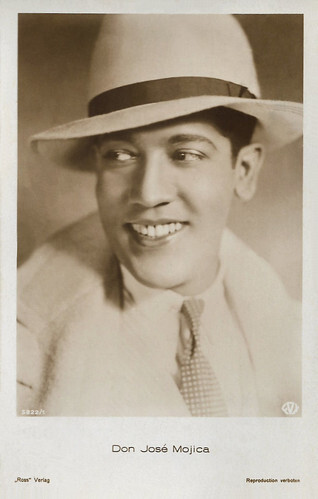
German postcard by Ross Verlag, no. 5822/1, 1930-1931. Photo: Fox.
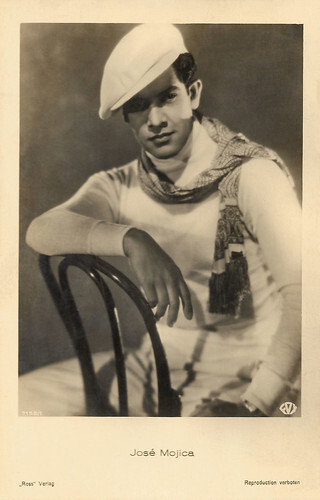
German postcard by Ross Verlag, no. 7152/1, 1932-1933. Photo: Fox.
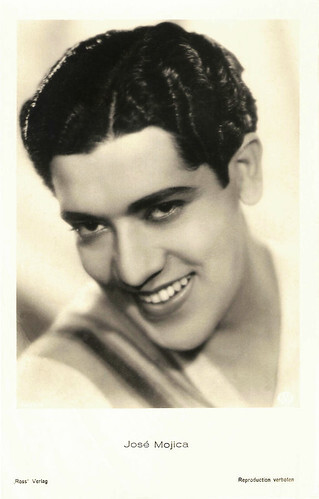
German postcard by Ross Verlag, no. 7422/1, 1932-1933. Photo: Fox.
To New York with $500 in his pocket
José Mojica was born Crescenciano Abel Exaltación de la Cruz José de Jesus Mojica Montenegro y Chavarín in 1896 in San Gabriel, Jalisco, Mexico. Mojica was raised in a coffee and sugar plantation community until the age of six after his stepfather Francisco died. He never knew his real father.
When his mother's extended family suffered financial challenges, they moved with limited means to Mexico City where he studied at the Academy of San Carlos and later attended the National School of Agriculture.
He initially planned for a career in engineering, but changed his mind and studied singing at the National Conservatory of Music. In 1916 he debuted at the Teatro Arbeu, playing the Count Almaviva role in Gioachino Rossini's opera 'The Barber of Seville'. The following year, he performed the role of Rodrigo in Giuseppe Verdi's 'Otello'.
Funded by his mother, he went to New York with $500 in his pocket, attending performances of Enrico Caruso. Caruso, having met Mojica in 1919, was sufficiently impressed by his singing to help him obtain a contract with the Chicago Civic Opera Company. He debuted that same year with the minor role of Lord Arthur Bucklaw in Gaetano Donizetti's 'Lucia di Lammermoor', an opera loosely based upon Sir Walter Scott's historical novel 'The Bride of Lammermoor'.
Mojica was soon given leads opposite Mary Garden and Amelita Galli-Curci when playing leading parts in Claude Debussy´s 'Pelléas et Mélisande' and Sergej Prokofiev's 'The Love for Three Oranges'. José Mojica also recorded for Edison in 1920, 1925 and 1926.
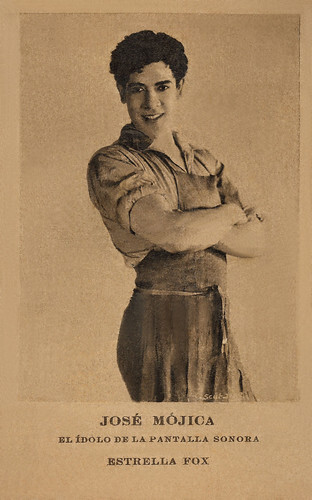
Spanish card. Photo: Fox. José Mojica in Cuando el amor ríe/When Love Laughs (David Howard, Manuel París, William J. Scully, 1930). Caption: José Mojica, The idol of the sound screen, Fox star. The film was released in Spain as Ladrón de amor.
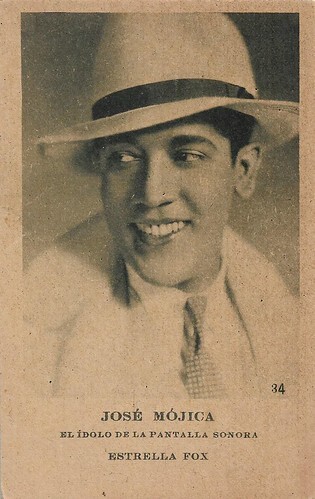
Spanish postcard, no. 34. Photo: Fox. Caption: El idolo de la pantalla sonora, Estrella Fox. (The idol of the sound screen, Fox star).
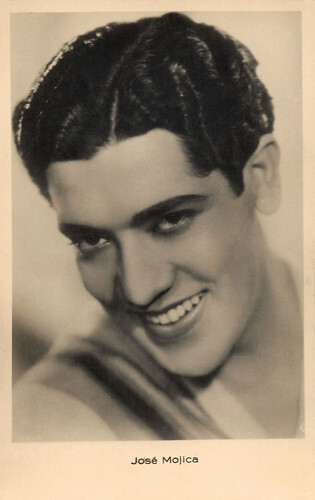
Vintage postcard.
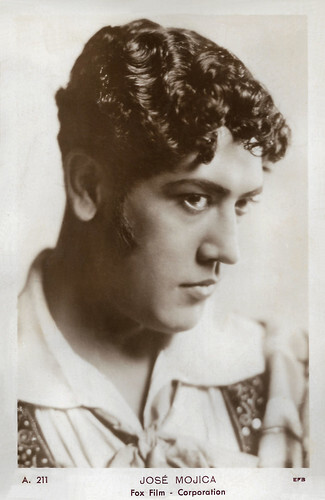
Spanish postcard by EFB (Editorial Fotográfica, Barcelona), no. A 211. Photo: Fox. Sent by mail in 1932.
A tendency to overact
Signed by Fox in 1930, José Mojica moved to California and appeared as a Spanish outlaw in the romantic musical One Mad Kiss (Marcel Silver, James Tinling, 1930), co-starring Argentine actress Mona Maris .
I.S. Mowis at IMDb : "Though he lacked neither charm nor a good voice, his popular appeal was limited by a square jaw, a stocky figure and a rather broad nose - worse, he had a tendency to overact. Fox, as a result, dropped Mojica from their 'A-list'." He starred in a series of Spanish-language romances and adventures for the next three years, often alongside Maris, Conchita Montenegro or Rosita Moreno.
One of the first was Cuando El Amor Rie/When Love Laughs (David Howard, 1930). Hal Erickson at AllMovie : "Cuando el Amor Rie is one of several Spanish-language films produced in Hollywood by Fox Studios before its 1935 merger with 20th Century studios. Set in Spanish California, the story revolves around devil-may-care-singing cowboy Jose Mojica. Wandering onto the ranch property owned by Don Alvarado, Mojica offers to tame a dangerous bucking bronco. Once he's done what he promised, Mojica accepts Alvarado's invitation to likewise "tame" his employer's tempestuous daughter Mona Maris . In other words, it's South-of-the-Border Shakespeare."
His characters remained essentially the same, even including a curious impersonation of highwayman Dick Turpin in El caballero de la noche/Dick Turpin (James Tinling, 1932). Mojica made a few more films in Mexico at the end of the decade. Following the death of his mother and prompted by religious visions, he then took the unusual step of selling his worldly possessions and becoming a Franciscan monk under the name Fray Jose de Guadalupe Mojica. After his retirement, he appeared in a few films to collect money for his order, such as El Pórtico de la Gloria/The porch of glory (Rafael J. Salvia, 1953) and Seguiré Tus Pasos/I Will Follow in Your Footsteps (Alfredo B. Crevenna, 1966).
José Mojica spent the remainder of his life in seminaries and monasteries in Peru. There he died of heart trouble in 1974 in Lima, Peru at the age of 79.
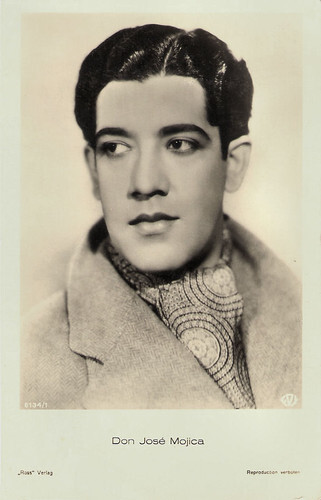
German postcard by Ross Verlag, no. 5134/1, 1930-1931. Photo: Fox.
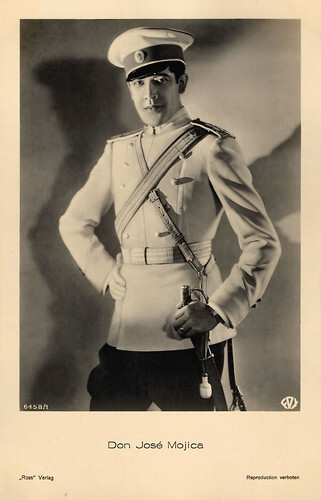
German postcard by Ross Verlag, no. 6458/1, 1931-1932. Photo: Fox.
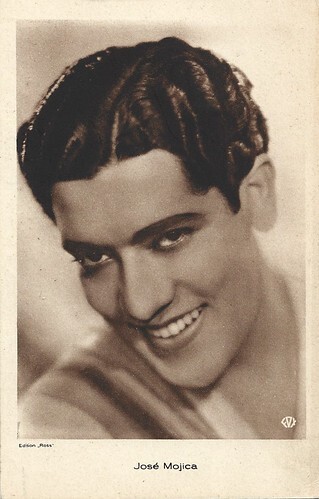
Possibly a German-Portuguese postcard, although it may also refer to a French Ross card because of the text "Edition Ross" (but a series number conspicuously lacks). Fox. Portuguese text (translated): "From 16 May, the most sympathetic film actor-singer José Mojica, who at the Trindade presents his excellent films of Fox, will perform and sing in Spanish in 'O bandido mascarado." Cinema Trindade was and is a cinema in Porto, Portugal. The Masked Bandit may refer to Mojica's Dick Turpin film El caballero de la noche (James Tinling, 1932).
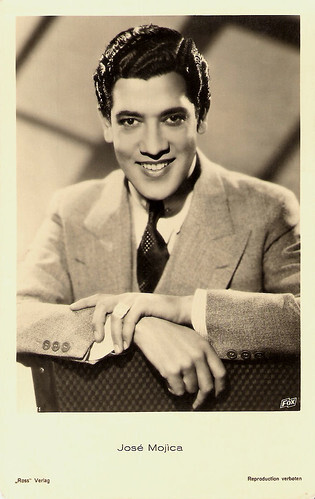
German postcard by Ross Verlag, no. 9210/1, 1935-1936. Photo: Fox.
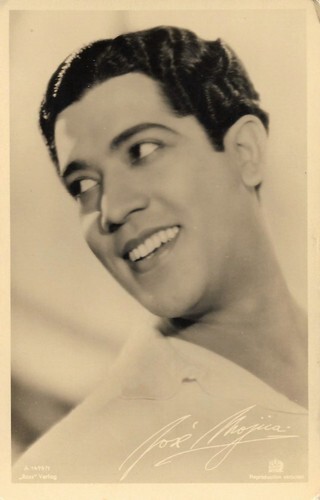
German postard by Ross Verlag, no. A 1479/1, 1937-1938. Photo: Fox.
Sources: (IMDb), Hal Erickson (AllMovie), José L. Bernabé Tronchoni (Find A Grave), Wikipedia and .

German postcard by Ross Verlag, no. 5822/1, 1930-1931. Photo: Fox.

German postcard by Ross Verlag, no. 7152/1, 1932-1933. Photo: Fox.

German postcard by Ross Verlag, no. 7422/1, 1932-1933. Photo: Fox.
To New York with $500 in his pocket
José Mojica was born Crescenciano Abel Exaltación de la Cruz José de Jesus Mojica Montenegro y Chavarín in 1896 in San Gabriel, Jalisco, Mexico. Mojica was raised in a coffee and sugar plantation community until the age of six after his stepfather Francisco died. He never knew his real father.
When his mother's extended family suffered financial challenges, they moved with limited means to Mexico City where he studied at the Academy of San Carlos and later attended the National School of Agriculture.
He initially planned for a career in engineering, but changed his mind and studied singing at the National Conservatory of Music. In 1916 he debuted at the Teatro Arbeu, playing the Count Almaviva role in Gioachino Rossini's opera 'The Barber of Seville'. The following year, he performed the role of Rodrigo in Giuseppe Verdi's 'Otello'.
Funded by his mother, he went to New York with $500 in his pocket, attending performances of Enrico Caruso. Caruso, having met Mojica in 1919, was sufficiently impressed by his singing to help him obtain a contract with the Chicago Civic Opera Company. He debuted that same year with the minor role of Lord Arthur Bucklaw in Gaetano Donizetti's 'Lucia di Lammermoor', an opera loosely based upon Sir Walter Scott's historical novel 'The Bride of Lammermoor'.
Mojica was soon given leads opposite Mary Garden and Amelita Galli-Curci when playing leading parts in Claude Debussy´s 'Pelléas et Mélisande' and Sergej Prokofiev's 'The Love for Three Oranges'. José Mojica also recorded for Edison in 1920, 1925 and 1926.

Spanish card. Photo: Fox. José Mojica in Cuando el amor ríe/When Love Laughs (David Howard, Manuel París, William J. Scully, 1930). Caption: José Mojica, The idol of the sound screen, Fox star. The film was released in Spain as Ladrón de amor.

Spanish postcard, no. 34. Photo: Fox. Caption: El idolo de la pantalla sonora, Estrella Fox. (The idol of the sound screen, Fox star).

Vintage postcard.

Spanish postcard by EFB (Editorial Fotográfica, Barcelona), no. A 211. Photo: Fox. Sent by mail in 1932.
A tendency to overact
Signed by Fox in 1930, José Mojica moved to California and appeared as a Spanish outlaw in the romantic musical One Mad Kiss (Marcel Silver, James Tinling, 1930), co-starring Argentine actress Mona Maris .
I.S. Mowis at IMDb : "Though he lacked neither charm nor a good voice, his popular appeal was limited by a square jaw, a stocky figure and a rather broad nose - worse, he had a tendency to overact. Fox, as a result, dropped Mojica from their 'A-list'." He starred in a series of Spanish-language romances and adventures for the next three years, often alongside Maris, Conchita Montenegro or Rosita Moreno.
One of the first was Cuando El Amor Rie/When Love Laughs (David Howard, 1930). Hal Erickson at AllMovie : "Cuando el Amor Rie is one of several Spanish-language films produced in Hollywood by Fox Studios before its 1935 merger with 20th Century studios. Set in Spanish California, the story revolves around devil-may-care-singing cowboy Jose Mojica. Wandering onto the ranch property owned by Don Alvarado, Mojica offers to tame a dangerous bucking bronco. Once he's done what he promised, Mojica accepts Alvarado's invitation to likewise "tame" his employer's tempestuous daughter Mona Maris . In other words, it's South-of-the-Border Shakespeare."
His characters remained essentially the same, even including a curious impersonation of highwayman Dick Turpin in El caballero de la noche/Dick Turpin (James Tinling, 1932). Mojica made a few more films in Mexico at the end of the decade. Following the death of his mother and prompted by religious visions, he then took the unusual step of selling his worldly possessions and becoming a Franciscan monk under the name Fray Jose de Guadalupe Mojica. After his retirement, he appeared in a few films to collect money for his order, such as El Pórtico de la Gloria/The porch of glory (Rafael J. Salvia, 1953) and Seguiré Tus Pasos/I Will Follow in Your Footsteps (Alfredo B. Crevenna, 1966).
José Mojica spent the remainder of his life in seminaries and monasteries in Peru. There he died of heart trouble in 1974 in Lima, Peru at the age of 79.

German postcard by Ross Verlag, no. 5134/1, 1930-1931. Photo: Fox.

German postcard by Ross Verlag, no. 6458/1, 1931-1932. Photo: Fox.

Possibly a German-Portuguese postcard, although it may also refer to a French Ross card because of the text "Edition Ross" (but a series number conspicuously lacks). Fox. Portuguese text (translated): "From 16 May, the most sympathetic film actor-singer José Mojica, who at the Trindade presents his excellent films of Fox, will perform and sing in Spanish in 'O bandido mascarado." Cinema Trindade was and is a cinema in Porto, Portugal. The Masked Bandit may refer to Mojica's Dick Turpin film El caballero de la noche (James Tinling, 1932).

German postcard by Ross Verlag, no. 9210/1, 1935-1936. Photo: Fox.

German postard by Ross Verlag, no. A 1479/1, 1937-1938. Photo: Fox.
Sources: (IMDb), Hal Erickson (AllMovie), José L. Bernabé Tronchoni (Find A Grave), Wikipedia and .
Published on April 21, 2023 22:00
April 20, 2023
Let your hair hang down!
On 20-21 April 2023, Elisa Uffreduzzi (Marie Skłodowska-Curie Postdoctoral Fellow Université Libre de Bruxelles) organises the workshop 'Dance, Acting, Movement and Gestural Patterns in Silent Cinema' at Eye Collection Center, Amsterdam.
EFSP co-editor Ivo Blom will give the presentation 'Her/Hair Affairs', on conventions, personal vocabularies, and gestures in silent cinema related to hair. It involves such films as Malombra (1917) with Lyda Borelli, La storia di una donna (1920) with Pina Menichelli, Shoes (1916) by Lois Weber, and Grezy/Daydreams (1915) by Yevgeni Bauer. Other speakers will be e.g. Rachel Morley, Laurent Guido, Kristina Köhler, Marketa Uhrilova, Asli Özgen, Dominique Nasta, Vito Adriaensens, and Uffreduzzi herself.
Here at EFSP, Ivo gives you a preview of his presentation.
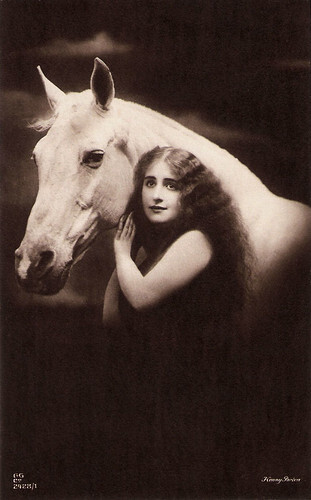
German postcard by GG, no. 2428/11. Henny Porten: ethereal girl, long hair and horse.
Sturdy and blond Henny Porten (1890-1960) was one of Germany's most essential and famous film actresses of silent cinema. She became the quintessence of German womanhood, ladylike yet kindhearted and a not a little petit bourgeois. She was also the producer of many of her own films.
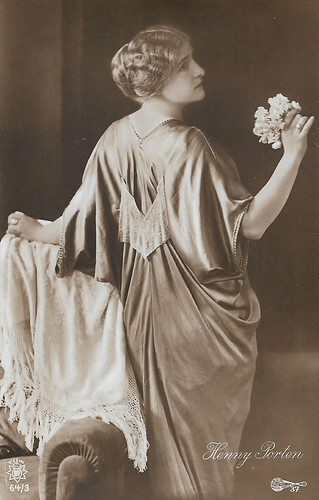
German postcard by Rotophot in the Film-Sterne series, no. 64/3. Photo: Messter-Film, no. 37. Henny Porten with hair pinned up.
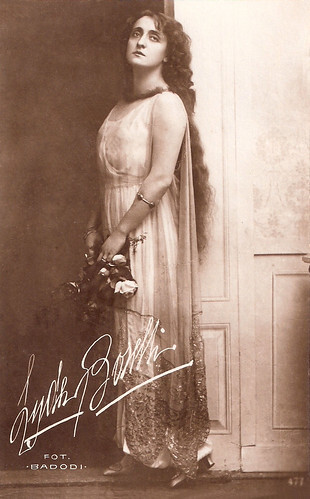
Italian postcard, no. 471. Photo: Attilio Badodi. Lyda Borelli: what a profile, what an exquisite dress (Paul Poiret?), what long hair!
Lyda Borelli (1887-1959) was already an acclaimed stage actress before she became the first diva of Italian silent cinema. The fascinating film star caused a craze among female fans called 'Borellismo'.
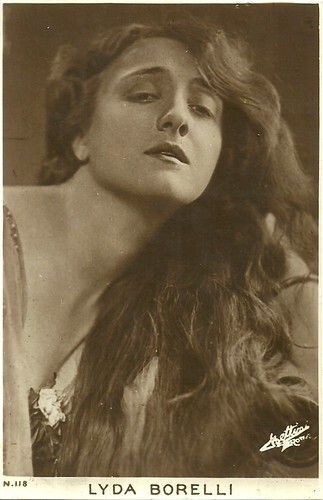
Italian postcard by Photo Ed. Soc. Anon. It. Bettini, Roma, no. 118. Photo: Riccardo Bettini. Again, Lyda Borelli and long hair.
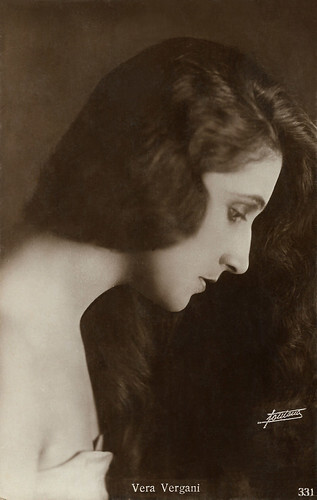
Italian postcard by Ed. A. Traldi, Milano, no. 331. Photo: Fontana. Vera Vergani, long hair.
Vera Vergani (1894–1989) was an Italian stage and film actress. She not only performed in the first stagings of Luigi Pirandello’s plays but in 1916-1921 she also knew a career as an actress in Italian silent cinema.
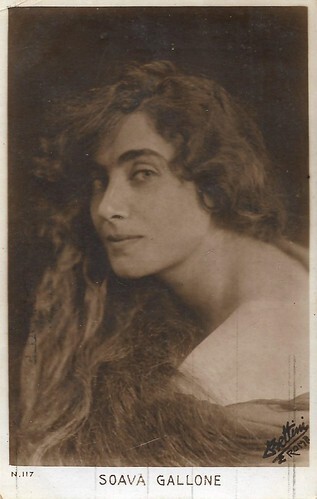
Italian postcard by Photo Ed. Soc. Anon. It. Bettini, Roma, no. 117. Photo: Riccardo Bettini. Soava Gallone, long hair (Was it one of Bettini's fixations?)
Polish actress Soava Gallone (1880-1957) was one of the divas of Italian silent cinema.
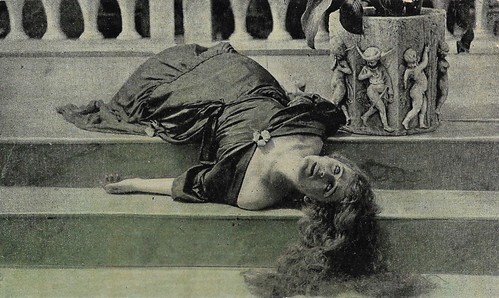
Spanish cromo (collectors card) by Chocolate Imperiale, no. 6 of 6. Photo: Sabaudo Film / distr. J. Verdaguer. Diana Karenne in Lea (Diana Karenne, Salvatore Aversano, 1916). Diana Karenne, long hair.
Polish actress Diana Karenne (1888-1940) was one of the divas of Italian silent cinema. Between 1916 and 1920, Karenne fascinated European audiences with her eccentric dresses and make-up, and with her primadonna behaviour.
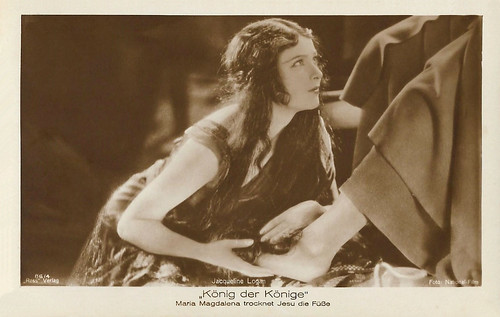
German postcard by Ross Verlag, no. 86/4. Photo: National Film. Biblical long hair: Jacqueline Logan in The King of Kings (Cecil B. DeMille, 1927). Caption: Mary Magdalene dries Jesus' feet.
Jacqueline Logan (1901-1983) was an American actress on the silent screen. Her most famous part is that of Mary Magdalene in The King of Kings (1927) by Cecil B. DeMille.
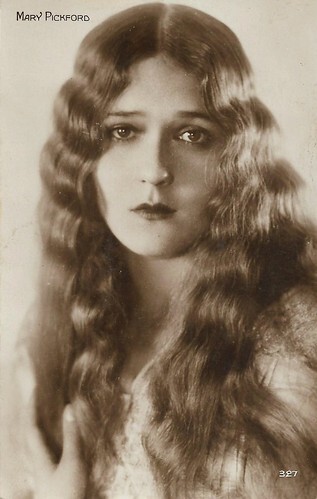
French postcard by Editions Cinémagazine, no. 327. Mary Pickford's long hair.
Mary Pickford (1892-1972) was a legendary silent film actress and was known as 'America’s sweetheart.' She was a founder of United Artists and helped establish the Academy.
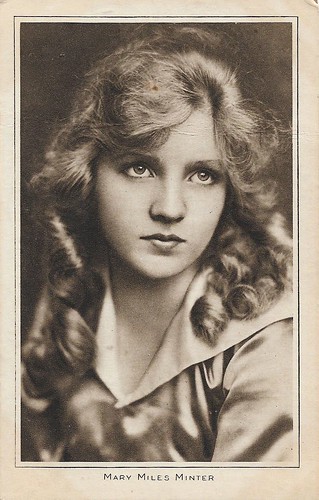
British postcard in the 'Pictures' Portrait Gallery, London. The girly look, Goldilocks: Mary Miles Minter.
Mary Miles Minter (1902-1984) was an American silent screen actress who grew into a rival of Mary Pickford. In 1919 she made her most famous film, Anne of Green Gables (presumably a lost film), with director William Desmond Taylor. The film became a huge success, as a result of which Taylor started to promote the actress.
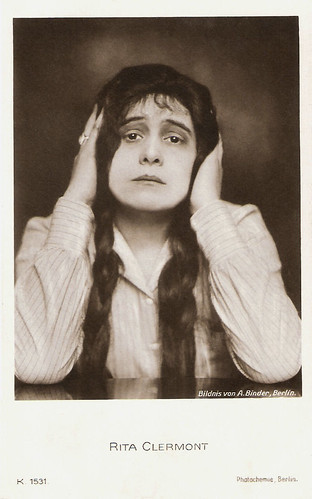
German postcard by Photochemie, Berlin, no. K. 1531. Photo: Alex Binder, Berlin. Backfisch and braids: Rita Clermont.
Rita Clermont (1894-1969) was a German film actress of the silent era. She received her first contract from Messter Film. Franz Hofer directed her in a series of similar cheerful stories, in which she mimed flappers, 'backfisches' and cheerful, rebellious girls. Until 1924, she appeared in 60 silent films.
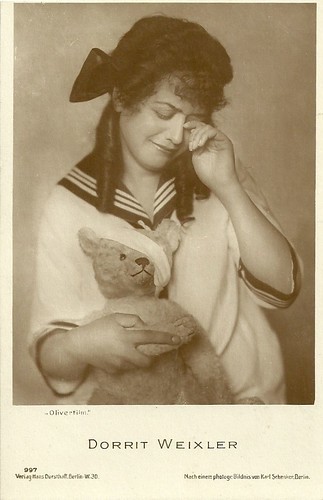
German postcard by Verlag Hans Dursthoff, Berlin, no. 997. Photo: Karl Schenker, Berlin / Oliver Film. Backfisch and locks: Dorrit Weixler.
German silent film actress Dorrit Weixler (1892-1916) anticipated such better-known comedy stars of the German cinema as Ossi Oswalda and Anny Ondra. Her popular roles were the temperamental teenager or the tomboy in a sailor suit who is tamed by the 'right man'. The career of the bright and light comedienne was like a candle burning on both sides.
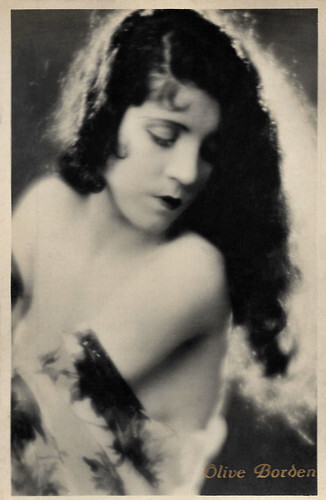
Italian postcard by G.B. Falci Editore, Milano, no. 614. Olive Borden, from long black curly hair to a bob cut.
Stunning Olive Borden (1906-1947) was considered one of the most beautiful actresses of the silent era. At 15, she started as a Mack Sennett bathing beauty and reached the peak of her career in 1926 when she made 11 films for Fox Studios and was earning $1,500 a week. She was nicknamed "the Joy Girl", after playing the lead in the 1927 film of that same title, but soon her career waned.
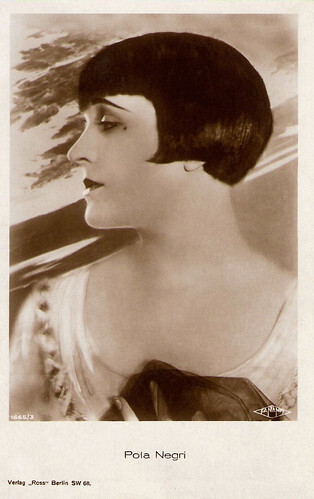
German postcard by Ross Verlag, Berlin, no. 1665/3, 1927-1928. Photo: FaNaMet (or ParUfaMet). Pola Negri bob cut.
Polish film actress Pola Negri (1897-1987) achieved notoriety as a femme fatale in German and American silent films between the 1910s and 1930s. In the late 1910s and the 1920s, she achieved notoriety as a femme fatale in silent films in Poland, Berlin, and Hollywood. Negri was an overnight sensation in Ernst Lubitsch's Madame du Barry/Passion (1919). Her vamp roles were so popular that she was a direct rival of Theda Bara, and lived in a Hollywood palace, modelled after the White House.
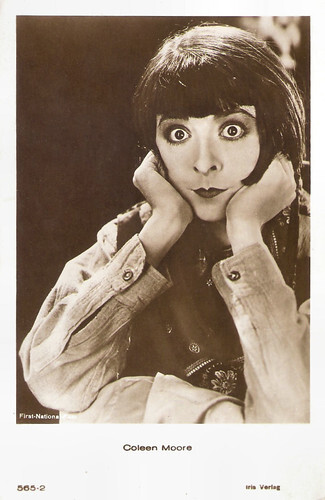
Austrian postcard by Iris-Verlag, no. 566/2. Photo: First-National-Film. Publicity still for The Desert Flower (Irving Cummings, 1925). Flapper & bob cut: Colleen Moore.
American actress Colleen Moore (1899-1988) was a star of the silent screen who appeared in about 100 films beginning in 1917. During the 1920s, she put her stamp on American social history, creating in dozens of films the image of the wide-eyed, insouciant flapper with her bobbed hair and short skirts.
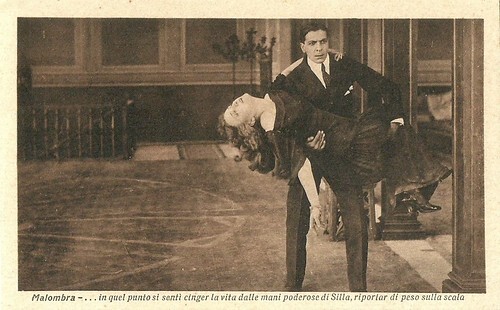
Italian postcard for Malombra (Carmine Gallone 1917), adapted from the novel by Antonio Fogazzaro, and starring Lyda Borelli and Amleto Novelli . IPA CT Duplex. Film Cines. Caption: ...at that moment she felt her waist held by the powerful hands of Silla, who lifted her back up the stairs. Hairs signals. Letting her hair down: Lyda Borelli in Malombra.
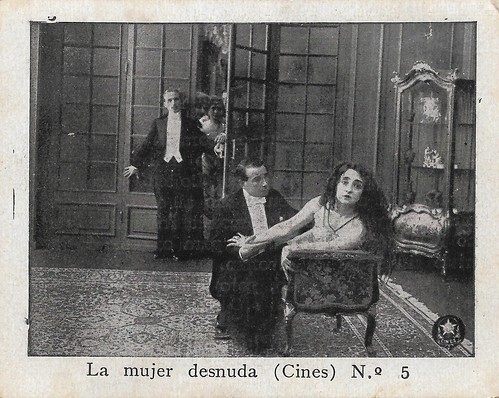
Spanish minicard (collectors card) by Reclam Films, Mallorca, no. 5 of 6 cards. Photo: Cines. Lyda Borelli in La donna nuda (Carmine Gallone, 1914). Letting her hair down: Borelli in La donna nuda.
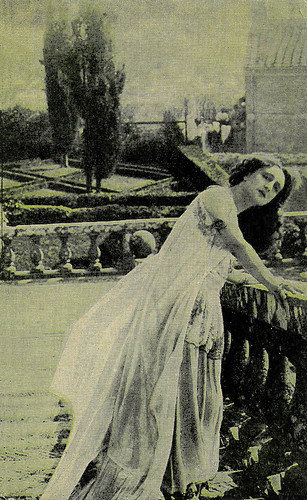
Spanish postcard by Amattler Marca Luna chocolate, series 7, no. 19. Lyda Borelli as Queen Maria Teresa in Carnevalesca (Amleto Palermi, 1918). Queen Maria Teresa, flees the castle after having unjustly killed her husband. Letting her hair down: Lyda Borelli in Carnevalesca (1918).
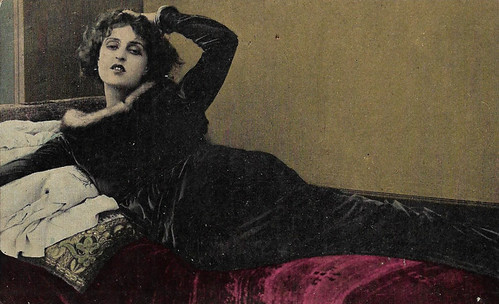
Spanish collectors card by Chocolate Imperiale, no. 6 of 6. Photo: Rinascimento Film. Pina Menichelli in Il giardino incantato/The Stronger Sex (Eugenio Perego, 1918). The film was originally entitled 'Il giardino della voluttà', a title which the Spanish cards on the film kept, but which became forbidden by the Italian censor. Pina Menichelli & touching hair.
Fascinating and enigmatic Pina Menichelli (1890-1984) was the most bizarre Italian diva of the silent era. With her contorted postures and disdainful expression, she impersonated the striking femme fatale.
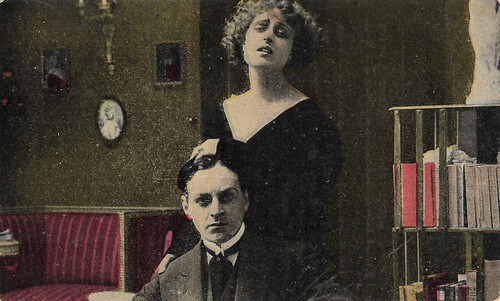
Spanish collectors card by Chocolate Imperiale, no. 5 of 6. Photo: Rinascimento Film. Pina Menichelli and Luigi Serventi in Il giardino incantato/The Stronger Sex (Eugenio Perego, 1918). Pina Menichelli & touching hair.
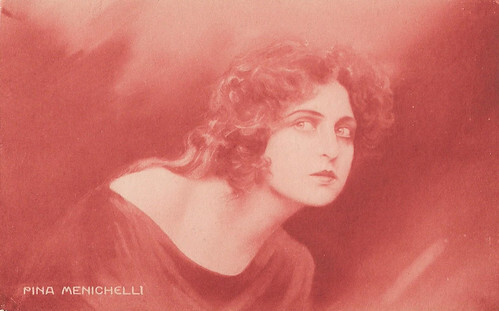
Italian postcard. Pina Menichelli with her hair unbound (danger ahead!).
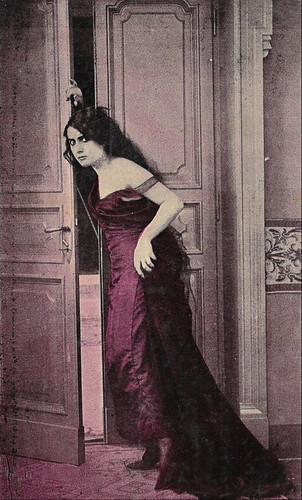
Spanish collectors card by Chocolate Amattler, Marca Luna, series 4, no. 17. Photo: Caesar Film. Francesca Bertini in Malìa (Alfredo De Antoni, 1917). The Spanish title for this film was Liliana. The portrait photos in this series were by Pinto, Rome. Francesca Bertini, unwinded long hair, after being raped and tattooed against her will, in Malía (a ripoff of The Cheat).
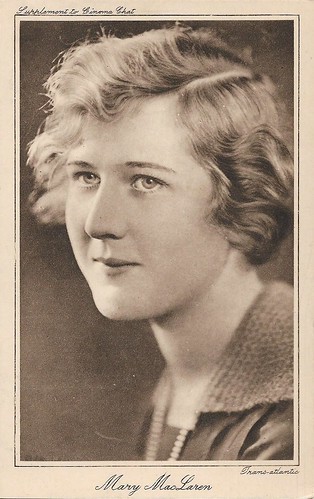
British postcard by Cinema Chat. Photo: Transatlantic (Universal's European distribution branch). Pinning up her hair: Mary MacLaren in Shoes (1918). The card is not from Shoes, sadly.
Mary MacLaren (1896–1985) was an American film actress. Mary was launched in 1916 in the lead of Shoes which tells about the desperate measures of a girl, selling her body for shoes. A successful film career, including a role as Anne of Austria, Queen of France, in Fred Niblo's The Three Musketeers (1921), starring Douglas Fairbanks.
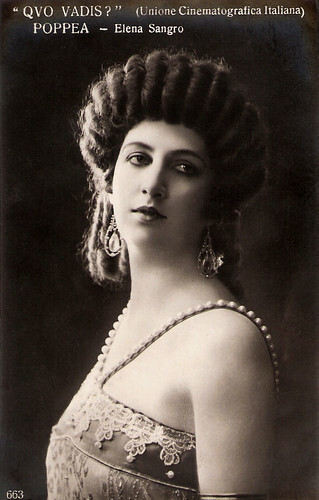
Italian postcard by Ed. A. Traldi, Milano, no. 663. Elena Sangro as the Empress Poppea in the epic film Quo vadis? (Gabriellino D'Annunzio, Georg Jacoby, 1924/1925), a production of UCI (Unione Cinematografica Italiana). Wigs: Elena Sangro in Quo vadis? (1924).
Elena Sangro (1896-1969) was one of the main actresses of the Italian cinema of the 1920s. In spite of the general film crisis then, she made one film after another. She was also one of the first female directors and she had a famous affair with the 64-year-old poet Gabriele D'Annunzio.
Notes
For Grezy/Daydreams (1915) see Silents Please and this gif.
For La moglie di Claudio with Menichelli, see Silents Please and this gif.
For the scene in Malombra with the metamorphosis, see YouTube, from 19:17 to 21:22.
See Shoes on the Eye Player. From 37:10: Mary binds her hair when she is going to prostitute herself. Her look in the mirror tells all: she knows what's coming. Till 37:55.
EFSP co-editor Ivo Blom will give the presentation 'Her/Hair Affairs', on conventions, personal vocabularies, and gestures in silent cinema related to hair. It involves such films as Malombra (1917) with Lyda Borelli, La storia di una donna (1920) with Pina Menichelli, Shoes (1916) by Lois Weber, and Grezy/Daydreams (1915) by Yevgeni Bauer. Other speakers will be e.g. Rachel Morley, Laurent Guido, Kristina Köhler, Marketa Uhrilova, Asli Özgen, Dominique Nasta, Vito Adriaensens, and Uffreduzzi herself.
Here at EFSP, Ivo gives you a preview of his presentation.

German postcard by GG, no. 2428/11. Henny Porten: ethereal girl, long hair and horse.
Sturdy and blond Henny Porten (1890-1960) was one of Germany's most essential and famous film actresses of silent cinema. She became the quintessence of German womanhood, ladylike yet kindhearted and a not a little petit bourgeois. She was also the producer of many of her own films.

German postcard by Rotophot in the Film-Sterne series, no. 64/3. Photo: Messter-Film, no. 37. Henny Porten with hair pinned up.

Italian postcard, no. 471. Photo: Attilio Badodi. Lyda Borelli: what a profile, what an exquisite dress (Paul Poiret?), what long hair!
Lyda Borelli (1887-1959) was already an acclaimed stage actress before she became the first diva of Italian silent cinema. The fascinating film star caused a craze among female fans called 'Borellismo'.

Italian postcard by Photo Ed. Soc. Anon. It. Bettini, Roma, no. 118. Photo: Riccardo Bettini. Again, Lyda Borelli and long hair.

Italian postcard by Ed. A. Traldi, Milano, no. 331. Photo: Fontana. Vera Vergani, long hair.
Vera Vergani (1894–1989) was an Italian stage and film actress. She not only performed in the first stagings of Luigi Pirandello’s plays but in 1916-1921 she also knew a career as an actress in Italian silent cinema.

Italian postcard by Photo Ed. Soc. Anon. It. Bettini, Roma, no. 117. Photo: Riccardo Bettini. Soava Gallone, long hair (Was it one of Bettini's fixations?)
Polish actress Soava Gallone (1880-1957) was one of the divas of Italian silent cinema.

Spanish cromo (collectors card) by Chocolate Imperiale, no. 6 of 6. Photo: Sabaudo Film / distr. J. Verdaguer. Diana Karenne in Lea (Diana Karenne, Salvatore Aversano, 1916). Diana Karenne, long hair.
Polish actress Diana Karenne (1888-1940) was one of the divas of Italian silent cinema. Between 1916 and 1920, Karenne fascinated European audiences with her eccentric dresses and make-up, and with her primadonna behaviour.

German postcard by Ross Verlag, no. 86/4. Photo: National Film. Biblical long hair: Jacqueline Logan in The King of Kings (Cecil B. DeMille, 1927). Caption: Mary Magdalene dries Jesus' feet.
Jacqueline Logan (1901-1983) was an American actress on the silent screen. Her most famous part is that of Mary Magdalene in The King of Kings (1927) by Cecil B. DeMille.

French postcard by Editions Cinémagazine, no. 327. Mary Pickford's long hair.
Mary Pickford (1892-1972) was a legendary silent film actress and was known as 'America’s sweetheart.' She was a founder of United Artists and helped establish the Academy.

British postcard in the 'Pictures' Portrait Gallery, London. The girly look, Goldilocks: Mary Miles Minter.
Mary Miles Minter (1902-1984) was an American silent screen actress who grew into a rival of Mary Pickford. In 1919 she made her most famous film, Anne of Green Gables (presumably a lost film), with director William Desmond Taylor. The film became a huge success, as a result of which Taylor started to promote the actress.

German postcard by Photochemie, Berlin, no. K. 1531. Photo: Alex Binder, Berlin. Backfisch and braids: Rita Clermont.
Rita Clermont (1894-1969) was a German film actress of the silent era. She received her first contract from Messter Film. Franz Hofer directed her in a series of similar cheerful stories, in which she mimed flappers, 'backfisches' and cheerful, rebellious girls. Until 1924, she appeared in 60 silent films.

German postcard by Verlag Hans Dursthoff, Berlin, no. 997. Photo: Karl Schenker, Berlin / Oliver Film. Backfisch and locks: Dorrit Weixler.
German silent film actress Dorrit Weixler (1892-1916) anticipated such better-known comedy stars of the German cinema as Ossi Oswalda and Anny Ondra. Her popular roles were the temperamental teenager or the tomboy in a sailor suit who is tamed by the 'right man'. The career of the bright and light comedienne was like a candle burning on both sides.

Italian postcard by G.B. Falci Editore, Milano, no. 614. Olive Borden, from long black curly hair to a bob cut.
Stunning Olive Borden (1906-1947) was considered one of the most beautiful actresses of the silent era. At 15, she started as a Mack Sennett bathing beauty and reached the peak of her career in 1926 when she made 11 films for Fox Studios and was earning $1,500 a week. She was nicknamed "the Joy Girl", after playing the lead in the 1927 film of that same title, but soon her career waned.

German postcard by Ross Verlag, Berlin, no. 1665/3, 1927-1928. Photo: FaNaMet (or ParUfaMet). Pola Negri bob cut.
Polish film actress Pola Negri (1897-1987) achieved notoriety as a femme fatale in German and American silent films between the 1910s and 1930s. In the late 1910s and the 1920s, she achieved notoriety as a femme fatale in silent films in Poland, Berlin, and Hollywood. Negri was an overnight sensation in Ernst Lubitsch's Madame du Barry/Passion (1919). Her vamp roles were so popular that she was a direct rival of Theda Bara, and lived in a Hollywood palace, modelled after the White House.

Austrian postcard by Iris-Verlag, no. 566/2. Photo: First-National-Film. Publicity still for The Desert Flower (Irving Cummings, 1925). Flapper & bob cut: Colleen Moore.
American actress Colleen Moore (1899-1988) was a star of the silent screen who appeared in about 100 films beginning in 1917. During the 1920s, she put her stamp on American social history, creating in dozens of films the image of the wide-eyed, insouciant flapper with her bobbed hair and short skirts.

Italian postcard for Malombra (Carmine Gallone 1917), adapted from the novel by Antonio Fogazzaro, and starring Lyda Borelli and Amleto Novelli . IPA CT Duplex. Film Cines. Caption: ...at that moment she felt her waist held by the powerful hands of Silla, who lifted her back up the stairs. Hairs signals. Letting her hair down: Lyda Borelli in Malombra.

Spanish minicard (collectors card) by Reclam Films, Mallorca, no. 5 of 6 cards. Photo: Cines. Lyda Borelli in La donna nuda (Carmine Gallone, 1914). Letting her hair down: Borelli in La donna nuda.

Spanish postcard by Amattler Marca Luna chocolate, series 7, no. 19. Lyda Borelli as Queen Maria Teresa in Carnevalesca (Amleto Palermi, 1918). Queen Maria Teresa, flees the castle after having unjustly killed her husband. Letting her hair down: Lyda Borelli in Carnevalesca (1918).

Spanish collectors card by Chocolate Imperiale, no. 6 of 6. Photo: Rinascimento Film. Pina Menichelli in Il giardino incantato/The Stronger Sex (Eugenio Perego, 1918). The film was originally entitled 'Il giardino della voluttà', a title which the Spanish cards on the film kept, but which became forbidden by the Italian censor. Pina Menichelli & touching hair.
Fascinating and enigmatic Pina Menichelli (1890-1984) was the most bizarre Italian diva of the silent era. With her contorted postures and disdainful expression, she impersonated the striking femme fatale.

Spanish collectors card by Chocolate Imperiale, no. 5 of 6. Photo: Rinascimento Film. Pina Menichelli and Luigi Serventi in Il giardino incantato/The Stronger Sex (Eugenio Perego, 1918). Pina Menichelli & touching hair.

Italian postcard. Pina Menichelli with her hair unbound (danger ahead!).

Spanish collectors card by Chocolate Amattler, Marca Luna, series 4, no. 17. Photo: Caesar Film. Francesca Bertini in Malìa (Alfredo De Antoni, 1917). The Spanish title for this film was Liliana. The portrait photos in this series were by Pinto, Rome. Francesca Bertini, unwinded long hair, after being raped and tattooed against her will, in Malía (a ripoff of The Cheat).

British postcard by Cinema Chat. Photo: Transatlantic (Universal's European distribution branch). Pinning up her hair: Mary MacLaren in Shoes (1918). The card is not from Shoes, sadly.
Mary MacLaren (1896–1985) was an American film actress. Mary was launched in 1916 in the lead of Shoes which tells about the desperate measures of a girl, selling her body for shoes. A successful film career, including a role as Anne of Austria, Queen of France, in Fred Niblo's The Three Musketeers (1921), starring Douglas Fairbanks.

Italian postcard by Ed. A. Traldi, Milano, no. 663. Elena Sangro as the Empress Poppea in the epic film Quo vadis? (Gabriellino D'Annunzio, Georg Jacoby, 1924/1925), a production of UCI (Unione Cinematografica Italiana). Wigs: Elena Sangro in Quo vadis? (1924).
Elena Sangro (1896-1969) was one of the main actresses of the Italian cinema of the 1920s. In spite of the general film crisis then, she made one film after another. She was also one of the first female directors and she had a famous affair with the 64-year-old poet Gabriele D'Annunzio.
Notes
For Grezy/Daydreams (1915) see Silents Please and this gif.
For La moglie di Claudio with Menichelli, see Silents Please and this gif.
For the scene in Malombra with the metamorphosis, see YouTube, from 19:17 to 21:22.
See Shoes on the Eye Player. From 37:10: Mary binds her hair when she is going to prostitute herself. Her look in the mirror tells all: she knows what's coming. Till 37:55.
Published on April 20, 2023 22:00
April 19, 2023
Hercules (1997)
Hercules (Ron Clements, John Musker, 1997) is an American animated film by Walt Disney Pictures, and also the 35th Disney classic of Disney animated films. The film's story is loosely based on the Greek myth of Hercules. The film's screenplay came from its directors, Ron Clements and John Musker.
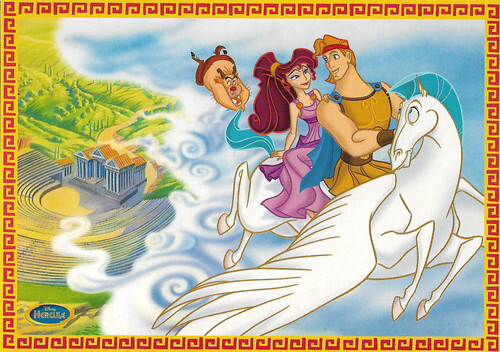
French postcard by Chromovogue, no. 10 155 A. Image: Walt Disney Pictures. Publicity still for Hercules (Ron Clements, John Musker, 1997).
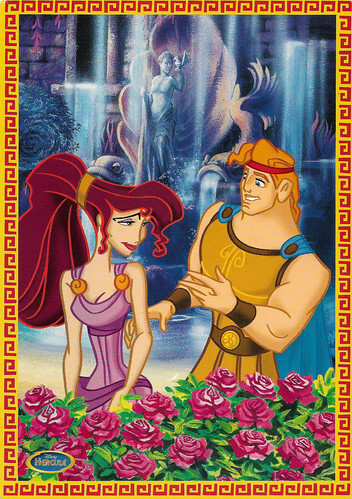
French postcard by Chromovogue, no. 10155 B. Image: Walt Disney Pictures. Meg and Hercules in Hercules (Ron Clements, John Musker, 1997).
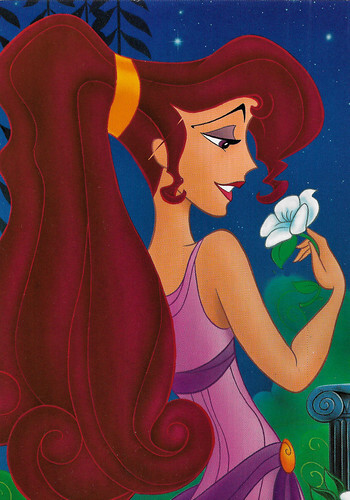
Vintage postcard by European Greetings, no. 535730. Image: Disney. Meg in Hercules (Ron Clements, John Musker, 1997).
Three monstrous ladies who can see into the past, present and future
The story of Hercules (Ron Clements, John Musker, 1997) is told by the Muses. The film begins with an introduction telling how the Greek god Zeus defeated and imprisoned the Titans, bringing peace to the world. The story then moves several years into the future. Zeus and his wife Hera now live with the other Greek gods on Mount Olympus.
They have just given birth to their first child, Hercules (Herakles in Greek). All the gods come to celebrate this joyous event. As a birth present, Hercules receives from his father Pegasus, which Zeus made from a cloud. Yet not everyone is happy about Hercules' birth. Hades, the god of the underworld, fears that Hercules will disrupt his plans to seize power on Olympus.
A visit by the Fates, three monstrous ladies who can see into the past, present and future, confirms this suspicion. Hades plots a plan to get rid of Hercules. He has Hercules kidnapped by his henchmen Pain and Panic. They must make him mortal through a special potion and then kill him. However, they are disturbed by a peasant couple. As a result, Hercules does not drink the last drop of the potion and retains his divine power. However, he is mortal and therefore cannot return to Olympus.
He is adopted by the couple. Pain and Panic decide to keep this news to themselves and tell Hades that Hercules is dead. Years later, Hercules gets into more and more trouble with his colossal strength. When his parents tell him they have found him, he decides to go to the temple of Zeus. Zeus appears to Hercules and tells him who he really is. He also tells Hercules that he can regain his divinity if he proves to be a true hero. Hercules regains his old friend Pegasus, who is now also an adult.
He sends Hercules to the satyr Philoctetes, called 'Phil', to be trained as a hero. Phil first refuses as he has had bad experiences with heroes, but agrees after Zeus strikes him with a thunderbolt. A long training session follows. After the training, Phil and Hercules go to Thebes with Pegasus. On the way, Hercules rescues a woman named Meg from a centaur. What he does not know is that Meg actually works for Hades, having sold her soul to him years ago.
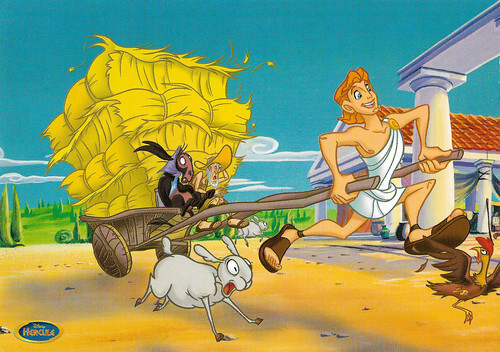
French postcard by Chromovogue, no. 10 155 C. Image: Walt Disney Pictures. Publicity still for Hercules (Ron Clements, John Musker, 1997).
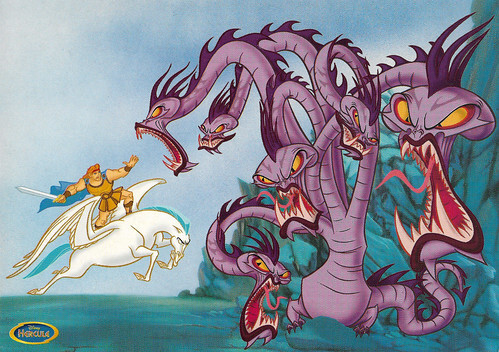
French postcard by Chromovogue, no. 10 156 B. Image: Walt Disney Pictures. Publicity still for Hercules (Ron Clements, John Musker, 1997).
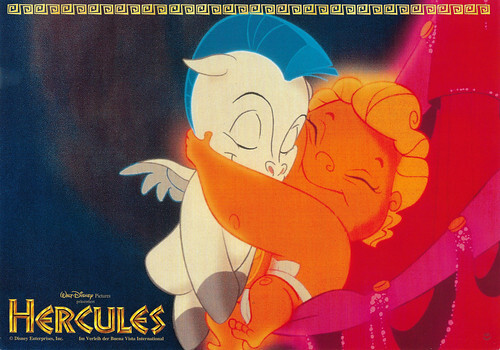
German lobby card. Image: Walt Disney Pictures. Little Pegasus and Hercules in Hercules (Ron Clements, John Musker, 1997).
Disney put its own spin on the mythological story
Hercules (Ron Clements, John Musker, 1997) has virtually nothing to do with the original stories of Hercules. John Musker and Ron Clements were attracted by the mythological aspect of the film and decided in the autumn of 1993 to direct and produce the film, with the help of Alice Dewey. Musker and Clements spent nine months defining the storyline, developing the initial script, and working with Andy Gaskill on the overall visuals; Gaskill then oversaw the art direction.
Animators spent the summer of 1994 in Greece to draw inspiration from the natural settings and archaeological sites, while British political cartoonist Gerald Scarfe helped to create the characters. Animation began in early 1995 and required nearly 700 artists, as well as Disney's first use of digital (computer-assisted) morphing.
Disney put its own spin on the mythological story. This was done partly because they felt certain events from mythology were inappropriate for young viewers. First of all, in the film, Hercules is the son of Zeus and Hera. In mythology, however, he is an illegitimate child of Zeus with the earthly woman Alcmene. Hera herself, in mythology, is Hercules' adversary. The Fates in the film are a fusion of the Fates goddesses and the Graeae.
In the film, the Titans are monstrous creatures, while in mythology they had a human appearance like the Greek gods. Possibly, in the film, the Titans are partly based on the Giants. Furthermore, some events from Greek mythology have been incorporated into the film in the wrong order. For instance, in Phil's home, Hercules collides with a piece of the Argo's mast, implying that the adventure of Jason and the Argonauts has already taken place. In mythology, however, Hercules was a member of the crew of the Argo.
Also, in the film, the Trojan War apparently took place before Hercules' training, while in mythology the war took place a generation after Hercules. Another difference in the film is that fear and panic work for Hades. In Greek mythology, they are sons of Ares and Aphrodite and have nothing to do with Hades.
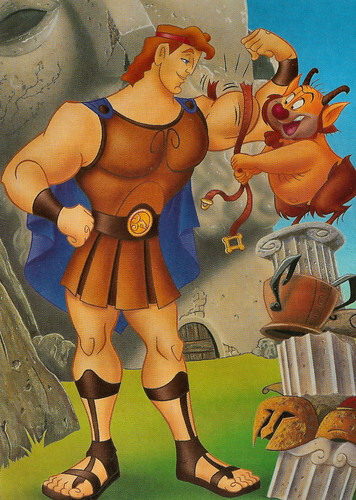
Vintage postcard by European Greetings, no. 553730. Image: Disney. Hercules and Phil in Hercules (Ron Clements, John Musker, 1997).
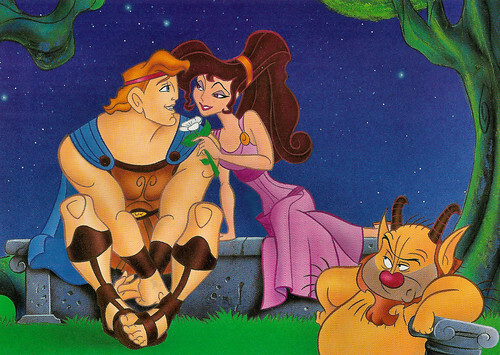
Vintage postcard by European Greetings, no. 553730. Image: Disney. Hercules, Meg and Phil in Hercules (Ron Clements, John Musker, 1997).
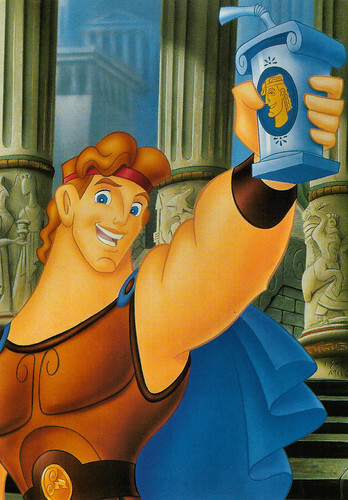
Vintage postcard by European Greetings, no. 553730. Image: Disney. Hercules in Hercules (Ron Clements, John Musker, 1997).
Many parodies of American culture
Walt Disney Pictures has stereotyped many of the characters in Hercules (Ron Clements, John Musker, 1997). For instance, Hercules is portrayed more as a superhero than a god. The film also contains many parodies of American culture, such as the huge merchandising created around Hercules when he becomes a hero.
The film does contain references to the 12 works of Hercules from mythology, such as his battle with the Hydra. Most of these references are incorporated in the clip of the song 'Zero to Hero', and the tasks Phil lists while Hercules poses for a painter. In this scene, Hercules is clad in a lion skin: that of Scar, the mean lion from the Disney film The Lion King (Roger Allers, Rob Minkoff, 1994).
When the film was released in the United States, it received positive, though rarely enthusiastic, reviews from American critics. In the Chicago Sun-Times, Roger Ebert gave the film a rating of 3.5 out of 4 and praised the graphics, voices and pacing.
Roger Ebert: "Although I thought last summer's The Hunchback of Notre Dame was a more original and challenging film, Hercules is lighter, brighter and more cheerful, with more for kids to identify with. (...) The look of the animation has a new freshness because of the style of Scarfe, famous in England for his sharp-penned caricatures of politicians and celebrities; the characters here are edgier and less rounded than your usual Disney heroes (although the cuddly Pegasus is in the traditional mode). The color palette too, makes less use of basic colors and stirs in more luminous shades, giving the picture a subtly different look that suggests it is different in geography and history from most Disney pictures."
The film got a spin-off, the TV series Hercules: The Animated Series (1998). The series ran for 1 season with 65 episodes.
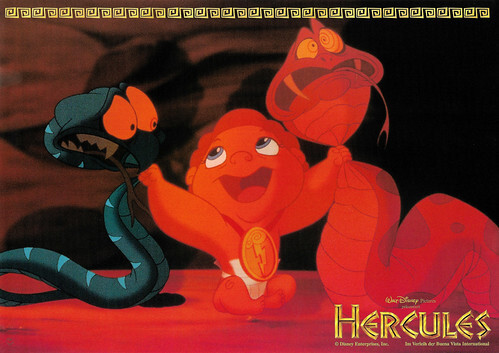
German lobby card. Image: Walt Disney Pictures. Hercules, Panic and Pain in Hercules (Ron Clements, John Musker, 1997).
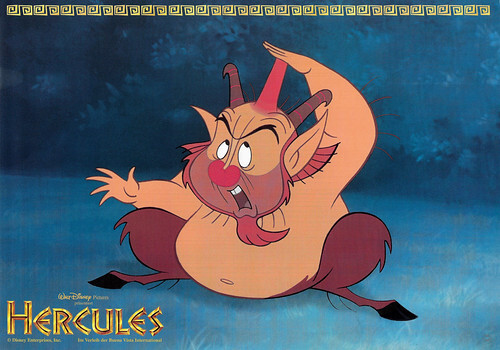
German lobbycard. Image: Disney. Phil in Hercules (Ron Clements, John Musker, 1997).
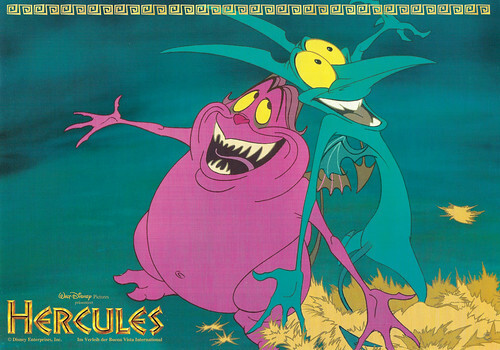
German lobbycard. Image: Disney. Panic and Pain in Hercules (Ron Clements, John Musker, 1997).
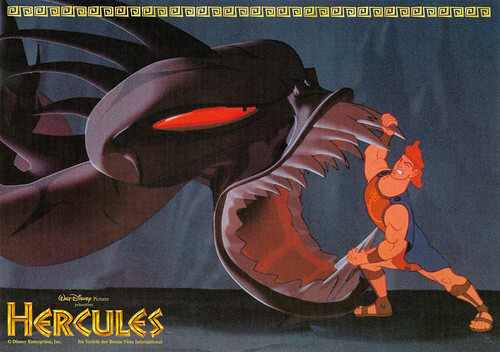
German lobby card. Image: Walt Disney Pictures. Hercules in Hercules (Ron Clements, John Musker, 1997).
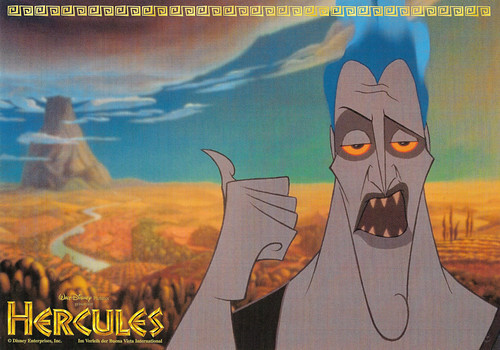
German lobby card. Image: Walt Disney Pictures. Hades in Hercules (Ron Clements, John Musker, 1997).
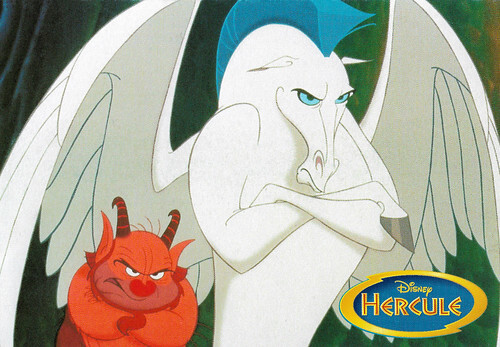
French double card by Mcdonalds'. Image: Walt Disney Pictures. Phil and Pegasus in Hercules (Ron Clements, John Musker, 1997).
Sources: Roger Ebert (Roger Ebert.com), Wikipedia (Dutch and French) and IMDb.

French postcard by Chromovogue, no. 10 155 A. Image: Walt Disney Pictures. Publicity still for Hercules (Ron Clements, John Musker, 1997).

French postcard by Chromovogue, no. 10155 B. Image: Walt Disney Pictures. Meg and Hercules in Hercules (Ron Clements, John Musker, 1997).

Vintage postcard by European Greetings, no. 535730. Image: Disney. Meg in Hercules (Ron Clements, John Musker, 1997).
Three monstrous ladies who can see into the past, present and future
The story of Hercules (Ron Clements, John Musker, 1997) is told by the Muses. The film begins with an introduction telling how the Greek god Zeus defeated and imprisoned the Titans, bringing peace to the world. The story then moves several years into the future. Zeus and his wife Hera now live with the other Greek gods on Mount Olympus.
They have just given birth to their first child, Hercules (Herakles in Greek). All the gods come to celebrate this joyous event. As a birth present, Hercules receives from his father Pegasus, which Zeus made from a cloud. Yet not everyone is happy about Hercules' birth. Hades, the god of the underworld, fears that Hercules will disrupt his plans to seize power on Olympus.
A visit by the Fates, three monstrous ladies who can see into the past, present and future, confirms this suspicion. Hades plots a plan to get rid of Hercules. He has Hercules kidnapped by his henchmen Pain and Panic. They must make him mortal through a special potion and then kill him. However, they are disturbed by a peasant couple. As a result, Hercules does not drink the last drop of the potion and retains his divine power. However, he is mortal and therefore cannot return to Olympus.
He is adopted by the couple. Pain and Panic decide to keep this news to themselves and tell Hades that Hercules is dead. Years later, Hercules gets into more and more trouble with his colossal strength. When his parents tell him they have found him, he decides to go to the temple of Zeus. Zeus appears to Hercules and tells him who he really is. He also tells Hercules that he can regain his divinity if he proves to be a true hero. Hercules regains his old friend Pegasus, who is now also an adult.
He sends Hercules to the satyr Philoctetes, called 'Phil', to be trained as a hero. Phil first refuses as he has had bad experiences with heroes, but agrees after Zeus strikes him with a thunderbolt. A long training session follows. After the training, Phil and Hercules go to Thebes with Pegasus. On the way, Hercules rescues a woman named Meg from a centaur. What he does not know is that Meg actually works for Hades, having sold her soul to him years ago.

French postcard by Chromovogue, no. 10 155 C. Image: Walt Disney Pictures. Publicity still for Hercules (Ron Clements, John Musker, 1997).

French postcard by Chromovogue, no. 10 156 B. Image: Walt Disney Pictures. Publicity still for Hercules (Ron Clements, John Musker, 1997).

German lobby card. Image: Walt Disney Pictures. Little Pegasus and Hercules in Hercules (Ron Clements, John Musker, 1997).
Disney put its own spin on the mythological story
Hercules (Ron Clements, John Musker, 1997) has virtually nothing to do with the original stories of Hercules. John Musker and Ron Clements were attracted by the mythological aspect of the film and decided in the autumn of 1993 to direct and produce the film, with the help of Alice Dewey. Musker and Clements spent nine months defining the storyline, developing the initial script, and working with Andy Gaskill on the overall visuals; Gaskill then oversaw the art direction.
Animators spent the summer of 1994 in Greece to draw inspiration from the natural settings and archaeological sites, while British political cartoonist Gerald Scarfe helped to create the characters. Animation began in early 1995 and required nearly 700 artists, as well as Disney's first use of digital (computer-assisted) morphing.
Disney put its own spin on the mythological story. This was done partly because they felt certain events from mythology were inappropriate for young viewers. First of all, in the film, Hercules is the son of Zeus and Hera. In mythology, however, he is an illegitimate child of Zeus with the earthly woman Alcmene. Hera herself, in mythology, is Hercules' adversary. The Fates in the film are a fusion of the Fates goddesses and the Graeae.
In the film, the Titans are monstrous creatures, while in mythology they had a human appearance like the Greek gods. Possibly, in the film, the Titans are partly based on the Giants. Furthermore, some events from Greek mythology have been incorporated into the film in the wrong order. For instance, in Phil's home, Hercules collides with a piece of the Argo's mast, implying that the adventure of Jason and the Argonauts has already taken place. In mythology, however, Hercules was a member of the crew of the Argo.
Also, in the film, the Trojan War apparently took place before Hercules' training, while in mythology the war took place a generation after Hercules. Another difference in the film is that fear and panic work for Hades. In Greek mythology, they are sons of Ares and Aphrodite and have nothing to do with Hades.

Vintage postcard by European Greetings, no. 553730. Image: Disney. Hercules and Phil in Hercules (Ron Clements, John Musker, 1997).

Vintage postcard by European Greetings, no. 553730. Image: Disney. Hercules, Meg and Phil in Hercules (Ron Clements, John Musker, 1997).

Vintage postcard by European Greetings, no. 553730. Image: Disney. Hercules in Hercules (Ron Clements, John Musker, 1997).
Many parodies of American culture
Walt Disney Pictures has stereotyped many of the characters in Hercules (Ron Clements, John Musker, 1997). For instance, Hercules is portrayed more as a superhero than a god. The film also contains many parodies of American culture, such as the huge merchandising created around Hercules when he becomes a hero.
The film does contain references to the 12 works of Hercules from mythology, such as his battle with the Hydra. Most of these references are incorporated in the clip of the song 'Zero to Hero', and the tasks Phil lists while Hercules poses for a painter. In this scene, Hercules is clad in a lion skin: that of Scar, the mean lion from the Disney film The Lion King (Roger Allers, Rob Minkoff, 1994).
When the film was released in the United States, it received positive, though rarely enthusiastic, reviews from American critics. In the Chicago Sun-Times, Roger Ebert gave the film a rating of 3.5 out of 4 and praised the graphics, voices and pacing.
Roger Ebert: "Although I thought last summer's The Hunchback of Notre Dame was a more original and challenging film, Hercules is lighter, brighter and more cheerful, with more for kids to identify with. (...) The look of the animation has a new freshness because of the style of Scarfe, famous in England for his sharp-penned caricatures of politicians and celebrities; the characters here are edgier and less rounded than your usual Disney heroes (although the cuddly Pegasus is in the traditional mode). The color palette too, makes less use of basic colors and stirs in more luminous shades, giving the picture a subtly different look that suggests it is different in geography and history from most Disney pictures."
The film got a spin-off, the TV series Hercules: The Animated Series (1998). The series ran for 1 season with 65 episodes.

German lobby card. Image: Walt Disney Pictures. Hercules, Panic and Pain in Hercules (Ron Clements, John Musker, 1997).

German lobbycard. Image: Disney. Phil in Hercules (Ron Clements, John Musker, 1997).

German lobbycard. Image: Disney. Panic and Pain in Hercules (Ron Clements, John Musker, 1997).

German lobby card. Image: Walt Disney Pictures. Hercules in Hercules (Ron Clements, John Musker, 1997).

German lobby card. Image: Walt Disney Pictures. Hades in Hercules (Ron Clements, John Musker, 1997).

French double card by Mcdonalds'. Image: Walt Disney Pictures. Phil and Pegasus in Hercules (Ron Clements, John Musker, 1997).
Sources: Roger Ebert (Roger Ebert.com), Wikipedia (Dutch and French) and IMDb.
Published on April 19, 2023 22:00
April 18, 2023
Lydia Quaranta
Lydia Quaranta (1891-1928) was an actress in the Italian silent cinema, just like her twin sisters, Letizia and Isabella Quaranta. Lydia specialised in lavish epics. Her career reached its apex with the title role in the mega-production Cabiria (1914), widely considered the first feature film in the history of cinema.
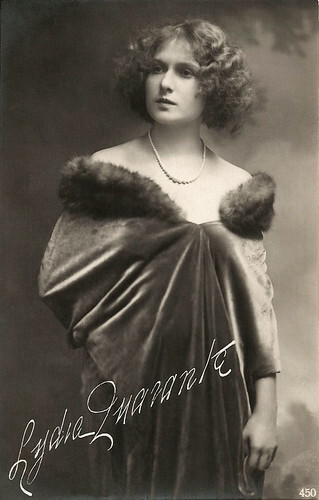
Italian postcard by Ed. A. Traldi, Milano, no. 450.
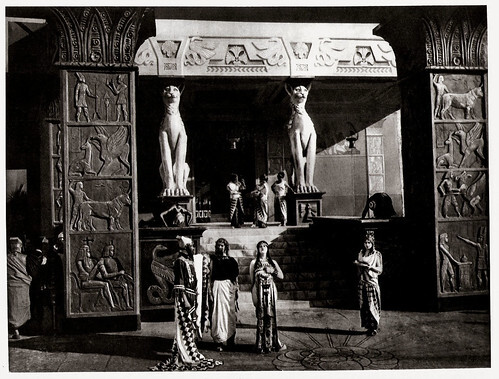
Publicity still for Cabiria (Giovanni Pastrone, 1914), with Alex Bernard, Edoardo Davesnes, Italia Almirante-Manzini and Lydia Quaranta.
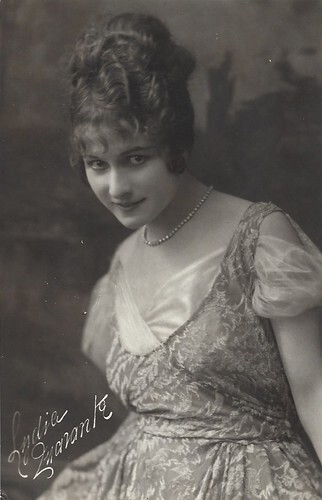
Italian postcard by Fotocelere, Torino.
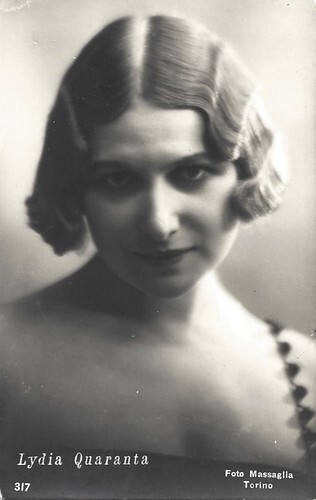
Italian postcard by Ed. Ballerini & Fratini, Firenze, no. 317. Photo: Massaglia, Torino.
Cabiria
Lydia or Lidia Quaranta was born Lidia Gemma Mattia Quaranta in Turin, Italy in 1891. She started her career as a stage actress at the company of Dante Testa. In 1910 she debuted in the film, together with her sister Letizia Quaranta when the company Itala Film enrolled both. Her true film debut though was in a short called L'ignota/The Unknown Woman (1910), produced by Aquila Films and directed by Edoardo Bencivenga.
After a few more Aquila productions, Quaranta played steadily at Itala, as in the aeroplane drama Come una sorella/Like a Sister (Vincenzo Denizot, 1912), the sensational drama Padre/Father (Dante Testa, Gino Zaccaria, 1912), starring Ermete Zacconi , Lo scomparso/The Dread of Doom (Dante Testa, 1913) with again Zacconi, and the crime story Tigris (Vincenzo Denizot, 1913).
Together with her sister Letizia, she played in Addio giovinezza!/Goodbye youth! (Nino Oxilia, 1913). In 1914 Lydia Quaranta’s cinema career reached its apex when she had the title role in the mega-production Cabiria. This was a historical film made on an epic scale by Giovanni Pastrone who used the pseudonym Piero Fosco.
For a lot of money, the famous author Gabriele D’Annunzio attached his name to the film as the scriptwriter. D’Annunzio in reality only invented some of the names of the characters and helped with the elaborate intertitles of the film.
Hal Erickson reviews at AllMovie : "Cabiria is an Italian historical epic that ran a full 14 reels (well over three hours) at a time when most American films were still short subjects. The plot hinges on the abduction of wealthy and virginal Cabiria (Lidia Quaranta) by pirates during the Roman/Carthaginian War of ancient times. Highlights (many of which were filmed on tinted stock) include the burning of the Roman fleet, an effect accomplished with miniatures and mirrors, and Hannibal's crossing of the Alps - with real Alps, and real elephants."
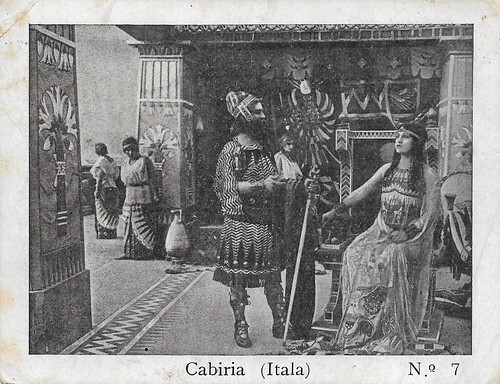
Spanish collectors card (minicard) by Chocolate Amatller, Barcelona, no. 7 of 12 cards. Photo: Itala Film. Picture from the Italian silent mega-epic Cabiria (Giovanni Pastrone, 1914), starring Italia Almirante Manzini as Sophonisba, Umberto Mozzato as Fulvio Axilla, Lydia Quaranta as Cabiria and Bartolomeo Pagano as Maciste. The high priest Karthalo (Dante Testa) is called by Queen Sophonisba to explain her nightmare. In between them, in the back, we see the adult Cabiria (Lydia Quaranta).
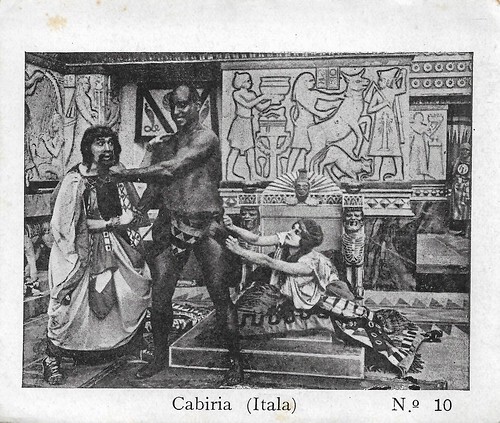
Spanish collectors card (minicard) by Chocolate Amatller, Barcelona, no. 10 of 12 cards. Photo: Itala Film. Picture from the Italian silent mega-epic Cabiria (Giovanni Pastrone, 1914), starring Italia Almirante Manzini as Sophonisba, Umberto Mozzato as Fulvio Axilla, Lydia Quaranta as Cabiria and Bartolomeo Pagano as Maciste. Here Maciste strangles the highpriest Karthalo (Dante Testa), but Cabiria holds him back.
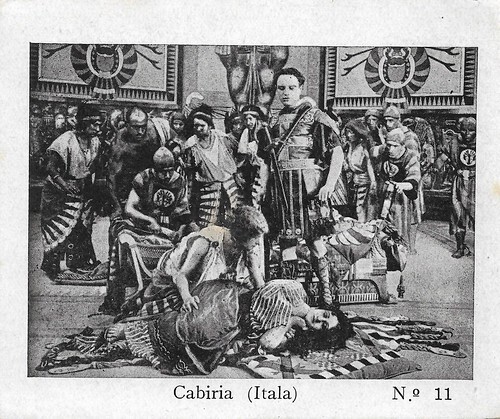
Spanish collectors card (minicard) by Chocolate Amatller, Barcelona, no. 11 of 12 cards. Photo: Itala Film. Picture from the Italian silent mega-epic Cabiria (Giovanni Pastrone, 1914), starring Italia Almirante Manzini as Sophonisba, Umberto Mozzato as Fulvio Axilla, Lydia Quaranta as Cabiria and Bartolomeo Pagano as Maciste. Here we see the death of Sophonisba, surrounded by Cabiria, Fulvio Axilla and the courtiers. She has poisoned herself, rather than become a slave to the Romans.
Struck with Pulmonitis
Cabiria was an international success. Pastrone eventually created a whole series around one of the popular characters of the film, the strong man Maciste (played by Bartolomeo Pagano ). Lydia Quaranta did not get this special exposure from Pastrone, but Cabiria did guarantee her many films offers in the years from 1915 to 1920, from various Turinese film companies, such as Gloria and Savoia.
Itala hired her again in 1919, for the then enormous sum of 10.000 lire per month. Among her memorable titles of this period are Iwna, perla del Gange/Iwna, Pearl of the Ganges (Giuseppe Pinto, 1914), Beffa di Satana/Mockery of Satan (Telemaco Ruggeri, 1915) with Dante Cappelli, Il romanzo di un atleta/The novel of an athlete (Vitorio Rossi Pianelli, 1915) with strong man Mario Guaita Ausonia , Nel vortice del peccato/In the vortex of sin (Telemaco Ruggeri, 1916) with Sandro Ruffini, Fiamma!/Flame! (Ettore Piergiovanni, 1920) with director Piergiovanni in the male lead as well, and I tre sentimentali/The three sentimental (Augusto Genina, 1921) - which film historian Vittorio Martinelli considered as her best film.
Hereafter, Quaranta moved to the Fert company, for which she did a few films such as the comedy Treno di piacere/Train of pleasure (Luciano Doria, 1924) with Alex Bernard.
In 1925 she played her last role, a small part in Mario Camerini’s Voglio tradire il mio marito/I want to betray my husband, starring Linda Pini . All in all Lydia Quaranta played in some 70 films.
In 1928, Quaranta was struck by an attack of pneumonia and died in her hometown Turin. She was only 36. Her sister Letizia (1893-1977) had a less intense but longer career. In 1921, she would marry film director Carlo Campogalliani and did various films with him, such as a few starring Maciste. Letizia had a twin sister Isabella (1892-1975) who also knew a career in Italian silent cinema between 1912 and 1917 but didn’t have the status her sisters had.
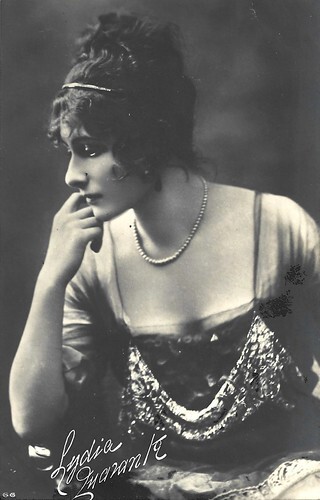
Italian postcard by Fotocelere, Torino, no. 66.
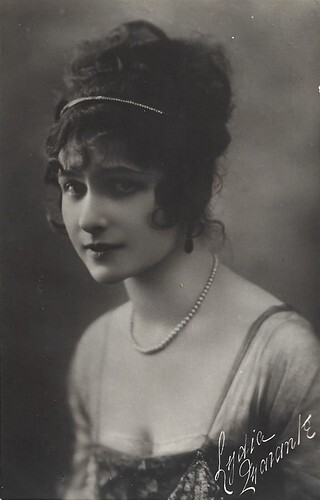
Italian postcard by Fotocelere, Torino.
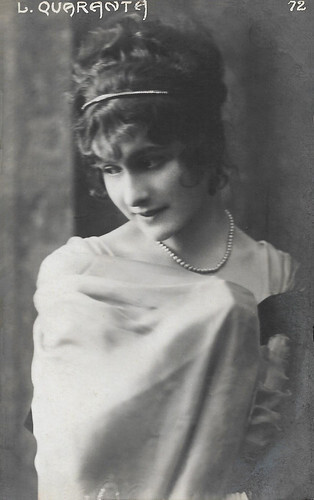
Italian postcard by G. Vettori, Bologna, no. 72.
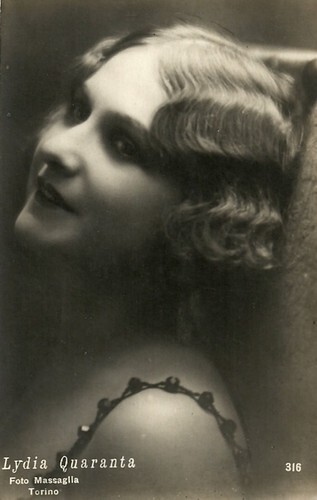
Italian postcard, no. 316. Photo: Massaglia, Torino.
Sources: Hal Erickson (AllMovie), Sandra Brennan (AllMovie), Cinema in Piemonte (Italian - now defunct), Wikipedia (Italian), and .

Italian postcard by Ed. A. Traldi, Milano, no. 450.

Publicity still for Cabiria (Giovanni Pastrone, 1914), with Alex Bernard, Edoardo Davesnes, Italia Almirante-Manzini and Lydia Quaranta.

Italian postcard by Fotocelere, Torino.

Italian postcard by Ed. Ballerini & Fratini, Firenze, no. 317. Photo: Massaglia, Torino.
Cabiria
Lydia or Lidia Quaranta was born Lidia Gemma Mattia Quaranta in Turin, Italy in 1891. She started her career as a stage actress at the company of Dante Testa. In 1910 she debuted in the film, together with her sister Letizia Quaranta when the company Itala Film enrolled both. Her true film debut though was in a short called L'ignota/The Unknown Woman (1910), produced by Aquila Films and directed by Edoardo Bencivenga.
After a few more Aquila productions, Quaranta played steadily at Itala, as in the aeroplane drama Come una sorella/Like a Sister (Vincenzo Denizot, 1912), the sensational drama Padre/Father (Dante Testa, Gino Zaccaria, 1912), starring Ermete Zacconi , Lo scomparso/The Dread of Doom (Dante Testa, 1913) with again Zacconi, and the crime story Tigris (Vincenzo Denizot, 1913).
Together with her sister Letizia, she played in Addio giovinezza!/Goodbye youth! (Nino Oxilia, 1913). In 1914 Lydia Quaranta’s cinema career reached its apex when she had the title role in the mega-production Cabiria. This was a historical film made on an epic scale by Giovanni Pastrone who used the pseudonym Piero Fosco.
For a lot of money, the famous author Gabriele D’Annunzio attached his name to the film as the scriptwriter. D’Annunzio in reality only invented some of the names of the characters and helped with the elaborate intertitles of the film.
Hal Erickson reviews at AllMovie : "Cabiria is an Italian historical epic that ran a full 14 reels (well over three hours) at a time when most American films were still short subjects. The plot hinges on the abduction of wealthy and virginal Cabiria (Lidia Quaranta) by pirates during the Roman/Carthaginian War of ancient times. Highlights (many of which were filmed on tinted stock) include the burning of the Roman fleet, an effect accomplished with miniatures and mirrors, and Hannibal's crossing of the Alps - with real Alps, and real elephants."

Spanish collectors card (minicard) by Chocolate Amatller, Barcelona, no. 7 of 12 cards. Photo: Itala Film. Picture from the Italian silent mega-epic Cabiria (Giovanni Pastrone, 1914), starring Italia Almirante Manzini as Sophonisba, Umberto Mozzato as Fulvio Axilla, Lydia Quaranta as Cabiria and Bartolomeo Pagano as Maciste. The high priest Karthalo (Dante Testa) is called by Queen Sophonisba to explain her nightmare. In between them, in the back, we see the adult Cabiria (Lydia Quaranta).

Spanish collectors card (minicard) by Chocolate Amatller, Barcelona, no. 10 of 12 cards. Photo: Itala Film. Picture from the Italian silent mega-epic Cabiria (Giovanni Pastrone, 1914), starring Italia Almirante Manzini as Sophonisba, Umberto Mozzato as Fulvio Axilla, Lydia Quaranta as Cabiria and Bartolomeo Pagano as Maciste. Here Maciste strangles the highpriest Karthalo (Dante Testa), but Cabiria holds him back.

Spanish collectors card (minicard) by Chocolate Amatller, Barcelona, no. 11 of 12 cards. Photo: Itala Film. Picture from the Italian silent mega-epic Cabiria (Giovanni Pastrone, 1914), starring Italia Almirante Manzini as Sophonisba, Umberto Mozzato as Fulvio Axilla, Lydia Quaranta as Cabiria and Bartolomeo Pagano as Maciste. Here we see the death of Sophonisba, surrounded by Cabiria, Fulvio Axilla and the courtiers. She has poisoned herself, rather than become a slave to the Romans.
Struck with Pulmonitis
Cabiria was an international success. Pastrone eventually created a whole series around one of the popular characters of the film, the strong man Maciste (played by Bartolomeo Pagano ). Lydia Quaranta did not get this special exposure from Pastrone, but Cabiria did guarantee her many films offers in the years from 1915 to 1920, from various Turinese film companies, such as Gloria and Savoia.
Itala hired her again in 1919, for the then enormous sum of 10.000 lire per month. Among her memorable titles of this period are Iwna, perla del Gange/Iwna, Pearl of the Ganges (Giuseppe Pinto, 1914), Beffa di Satana/Mockery of Satan (Telemaco Ruggeri, 1915) with Dante Cappelli, Il romanzo di un atleta/The novel of an athlete (Vitorio Rossi Pianelli, 1915) with strong man Mario Guaita Ausonia , Nel vortice del peccato/In the vortex of sin (Telemaco Ruggeri, 1916) with Sandro Ruffini, Fiamma!/Flame! (Ettore Piergiovanni, 1920) with director Piergiovanni in the male lead as well, and I tre sentimentali/The three sentimental (Augusto Genina, 1921) - which film historian Vittorio Martinelli considered as her best film.
Hereafter, Quaranta moved to the Fert company, for which she did a few films such as the comedy Treno di piacere/Train of pleasure (Luciano Doria, 1924) with Alex Bernard.
In 1925 she played her last role, a small part in Mario Camerini’s Voglio tradire il mio marito/I want to betray my husband, starring Linda Pini . All in all Lydia Quaranta played in some 70 films.
In 1928, Quaranta was struck by an attack of pneumonia and died in her hometown Turin. She was only 36. Her sister Letizia (1893-1977) had a less intense but longer career. In 1921, she would marry film director Carlo Campogalliani and did various films with him, such as a few starring Maciste. Letizia had a twin sister Isabella (1892-1975) who also knew a career in Italian silent cinema between 1912 and 1917 but didn’t have the status her sisters had.

Italian postcard by Fotocelere, Torino, no. 66.

Italian postcard by Fotocelere, Torino.

Italian postcard by G. Vettori, Bologna, no. 72.

Italian postcard, no. 316. Photo: Massaglia, Torino.
Sources: Hal Erickson (AllMovie), Sandra Brennan (AllMovie), Cinema in Piemonte (Italian - now defunct), Wikipedia (Italian), and .
Published on April 18, 2023 22:00
April 17, 2023
Béatrice Dalle
Seductive French actress and wild girl Béatrice Dalle (1964) made a big splash with her film debut in 37°2 le matin/Betty Blue (1986). She went on to appear in a series of major roles in French and American films. Her unpredictability has gained her almost as much attention off-screen as on.

French postcard by Edition F. Nugeron, no. 16. Photo: Collection de l'Ecole de Cinéma Casiris, Lyon. Béatrice Dalle in 37°2 le matin/Betty Blue (Jean-Jacques Beineix, 1986).
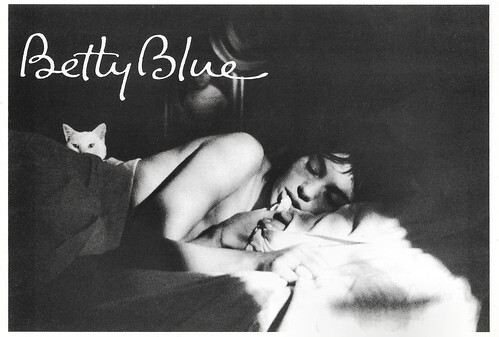
French postcard by Metro Music, no. MM 186. Béatrice Dalle in 37°2 le matin/Betty Blue (Jean-Jacques Beineix, 1986).
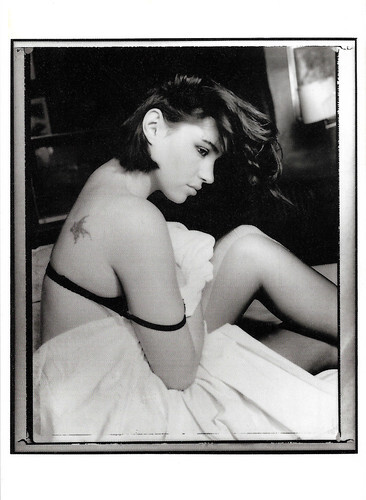
Swiss postcard by News Productions, Baulmes, no. 55955. Photo: Bettina Rheims / Musée de l'Élysée, Lausanne. Caption: Béatrice Dalle on the bed II, Paris, 1986.
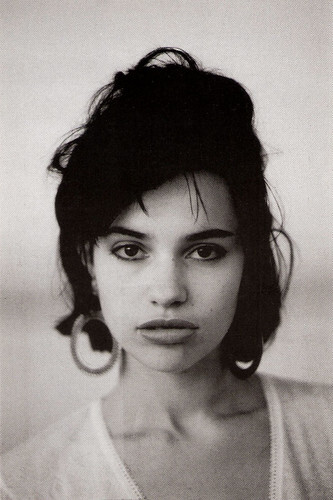
British postcard by Classics Postcards, London, no. 82.
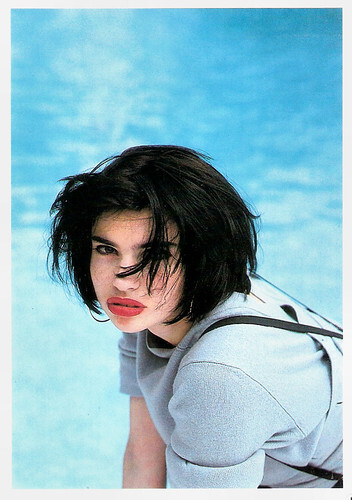
French postcard in the 'Collection Cinéma' series by Studio Magazine, Paris, no. PSM 389. Photo: Luc Roux.

French postcard by Editions F. Nugeron, no. 19. Photo: Collection de l'École de Cinéma CAMIRIS, Lyon.Béatrice Dalle in 37°2 le matin/Betty Blue (Jean-Jacques Beineix, 1986).
Lolitas
Béatrice Dalle was born as Béatrice Françoise Odona Cabarrou in Brest, France, in 1964. (However, a number of sources state she was born in Le Mans, France.) In 1985 she married the painter Jean-François Dalle but they divorced in 1988.
She was spotted by a photographer on the Champs Élysées. Following a cover shoot in Photo magazine on the subject of Lolitas, Dalle was introduced to agent Dominique Besnehard, who in turn introduced her to film director Jean-Jacques Beineix. He cast her in the lead role in his erotic drama 37°2 le matin/Betty Blue (Jean-Jacques Beineix, 1986).
Betty Blue is a sexually aggressive free spirit who becomes involved with Zorg ( Jean-Hugues Anglade ), a repairman moonlighting as a writer. The two engage in a variety of sexual encounters and grow more passionate toward each other. Her portrayal of the beautiful, impulsive but increasingly unstable Betty was a sensation. The French cinema had a new sex symbol.
Jason Buchanan at AllMovie : “Immediately recognized by the French masses for her unmistakable presence and stunning performance as the titular character, Dalle's career was soon on the rise, with a subsequent performance as a woman who claims to be a witch in La Visione del Sabba/The Witches' Sabbath (Marco Bellocchio, 1988) cementing her status as an unconventional actress of daring sensibilities.”
Chimère/Bubble (Claire Devers, 1989) was entered into the 1989 Cannes Film Festival. She then appeared opposite Isabelle Huppert in the dark drama La Vengeance d'une Femme/A Woman's Revenge (Jacques Doillon, 1989), based on Fyodor Dostoyevsky's 'The Eternal Husband'. Privately, she had a ten-year relationship with the French rapper Joey Starr.
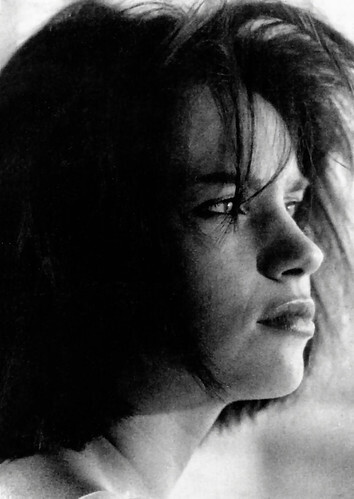
French postcard, no. 2082.
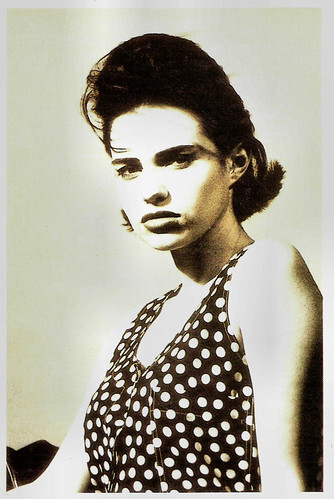
British postcard by World Postcards, Inc., 1989, no X223. Caption: Beatrice Dalle, Polka dot.
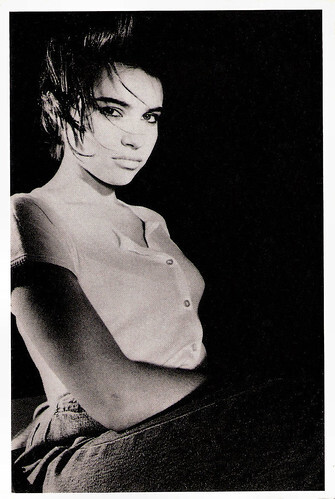
Vintage postcard, no. X208. Caption: White t-shirt.
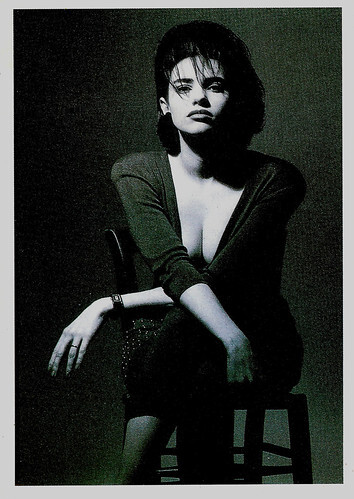
French postcard by Humour à la Carte, Paris, no. ST-160. Photo: J. Casano / Stills.
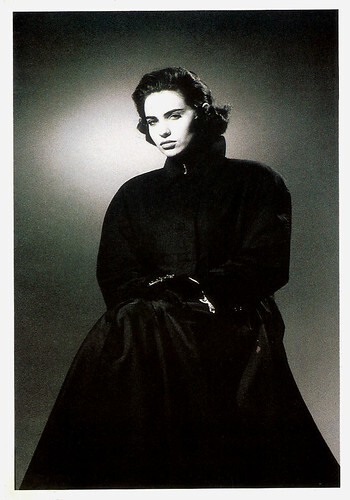
French postcard by Humour à la Carte, Paris, no. ST-162. photo: J. Casano / Stills.
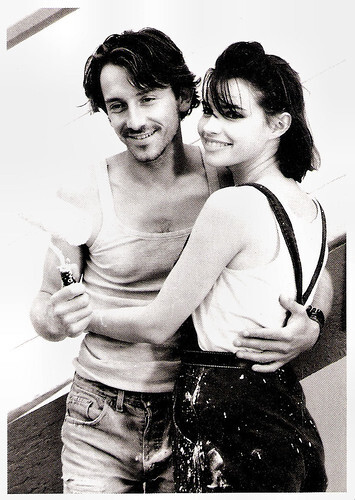
French postcard by Especially for you, Réf. 6. Photo: Jean-Hugues Anglade and Beatrice Dalle in 37°2 le matin/Betty Blue (1986).
Undesirable Immigrant
Béatrice Dalle made her international debut as a beautiful but surly blind girl in the Paris episode of the round-the-world comedy Night on Earth (Jim Jarmusch, 1991). That year, she also featured in the music video Move To Memphis (1991) by Norwegian band A-ha.
Dalle appeared almost exclusively in French films, including À la Folie/Six days, six nights (Diane Kurys, 1994) about A menage-a-trois between rival sisters (Dalle and Anne Parillaud) and a boyfriend, and J'ai Pas Sommeil/I Can't Sleep (Claire Denis, 1994) about two nocturnal serial killers who terrorize Paris.
Her first Hollywood production was The Blackout (Abel Ferrara, 1997) as the girlfriend of Matthew Modine, but her American career was cut short. During the production of The Blackout in Miami, she was arrested for cocaine possession. The incident would later come back to haunt her. Following her arrest, Dalle was declared an ‘Undesirable Immigrant'.
She would later be denied an American work permit to play the role of Bruce Willis' wife in The Sixth Sense, leaving the role open for actress Olivia Williams to fill.
It was not the only incident. In 1991, Dalle had already been arrested for a drug conviction in France in addition to a prior conviction of stealing jewels from a Paris boutique. She also had a drug conviction in France and there was another incident in which Dalle physically attacked a Parisian meter maid who was writing the actress a ticket for parking in a handicapped space.
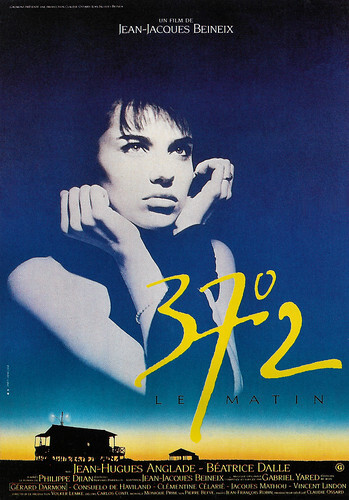
French postcard by Editions F. Nugeron, no. E 309. Image: French film poster for 37°2 le matin/Betty Blue (Jean-Jacques Beineix, 1986).
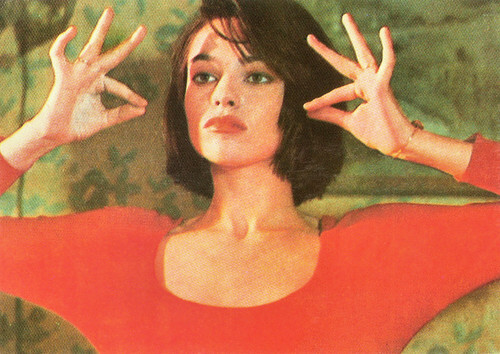
Romanian postcard by Casa Filmului Acin. Béatrice Dalle in 37°2 le matin/Betty Blue (Jean-Jacques Beineix, 1986).
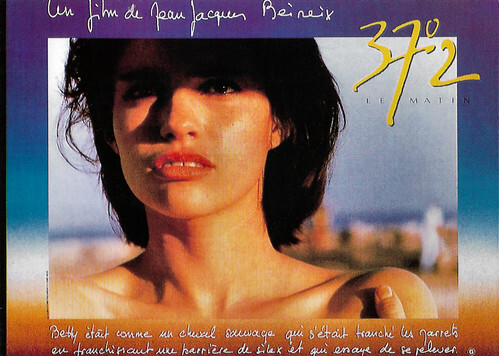
French postcard by Humour a la carte, Paris, no. A-C 1242. Photo: Gaumont. Béatrice Dalle in 37°2 le matin/Betty Blue (Jean-Jacques Beineix, 1986). Caption: Betty was like a wild horse that had cut its hocks on a fence and was trying to get back up.
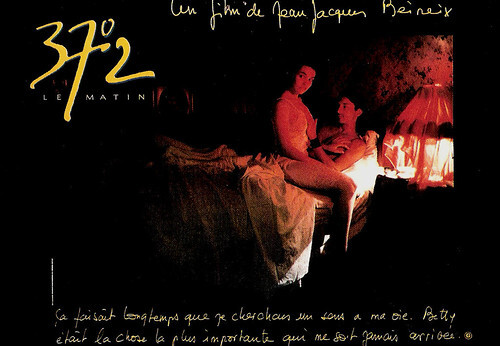
French postcard by Humour a la carte, Paris, no. A-C 1243. Photo: Gaumont. Béatrice Dalle and Jean-Hugues Anglade in 37°2 le matin/Betty Blue (Jean-Jacques Beineix, 1986). Caption: I had been looking for meaning in my life for a long time. Betty was the most important thing that ever happened to me.
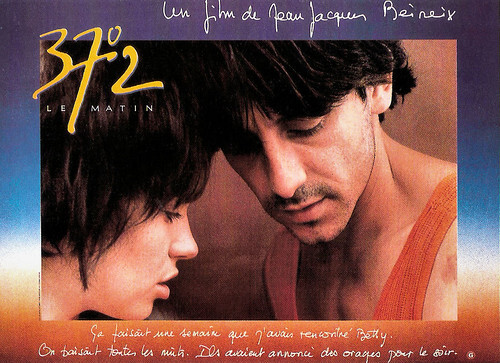
French postcard by Humour a la carte, Paris, no. A-C 1244. Photo: Gaumont. Béatrice Dalle and Jean-Hugues Anglade in 37°2 le matin/Betty Blue (Jean-Jacques Beineix, 1986). Caption: It had been a week since I met Betty. We had sex every night. They had announced thunderstorms for the evening.
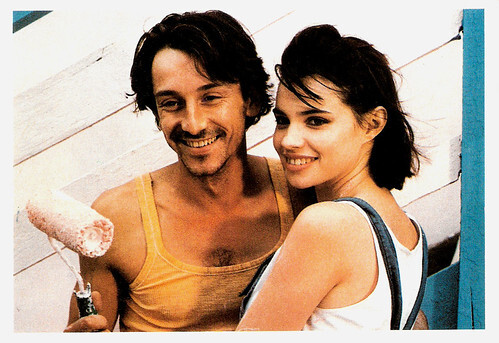
French postcard by Ebulittions, no. 16. Photo: publicity still for 37°2 le matin/Betty Blue (1986).
A princess who falls for a prisoner
In 2001, Béatrice Dalle appeared in the controversial art-house thriller Trouble Every Day (Claire Denis, 2003), in which she played a cannibal opposite Vincent Gallo. Then she was directed by Nobuhiro Suwa in H Story (2001), a postmodern adaptation of Alain Renais' classic Hiroshima, Mon Amour (1959). Suwa plays himself as a director who is seeking to remake the masterwork and who has cast Dalle in the lead role originally played by Emmanuelle Riva .
Critical successes were the dramas Le temps du loup/The Time of the Wolf (Michael Haneke, 2003) starring Isabelle Huppert , Clean (Olivier Assayas, 2004) with Maggie Cheung and Nick Nolte, and L'Intrus/The Intruder (Claire Denis, 2004) with Michel Subor .
In 2005, Dalle encountered Guénaël Méziani when they co-starred in Tête d'Or/Golden Head (2005), a film produced inside a prison in Brest. She appeared as a princess who falls for a prisoner. In reality, Dalle also fell in love at first sight with Meziani who was really serving a 12-year prison sentence for assaulting and raping his ex-girlfriend. She married him after 24 one-hour visits with him and spoke on his behalf at hearings for his early release. According to the newspaper Le Parisien, in May 2009 just weeks after he was given a conditional release for good behaviour, police were called to her flat in the Marais district of Paris because of a violent dispute in which Meziani allegedly threatened to kill Dalle. Their divorce was pronounced in July 2014.
In the next years, she starred in such films as À l'intérieur/Inside (Alexandre Bustillo, Julien Maury, 2007), in which she played a cruel psychopath stalking a pregnant woman, the TV film New Wave (Gaël Morel, 2008) and the family drama Domaine/Domain (Patric Chiha, 2009) in which she played an alcoholic and onetime professor of mathematics. Then followed Notre paradis/Our Paradise (Gaël Morel, 2011) and Bye Bye Blondie (Virginie Despentes, 2012) with Emmanuelle Béart .
In recent years, she appeared in such films as Rupert Everett 's The Happy Prince (2018), a biographical drama film about Oscar Wilde, Gaspar Noé's Lux Æterna (2019), an independent experimental meta-art film, and La Bête dans la jungle/The Beast in the Jungle (Patric China, 2023), an internationally co-produced drama, loosely based on the 1903 novella 'The Beat in the Jungle' by Henry James.

French postcard, no. A079. Sent by mail in 1994.
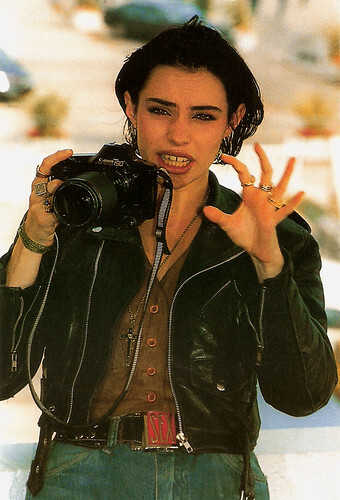
French postcard, no. A080.
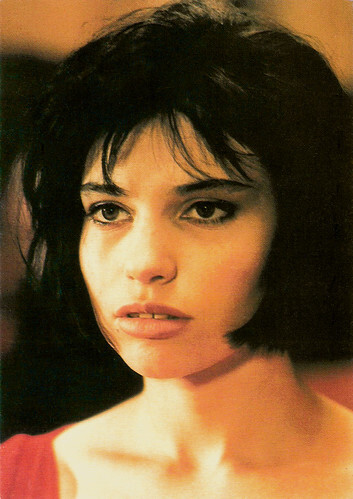
French postcard by Heroes, no. SPC 2330.
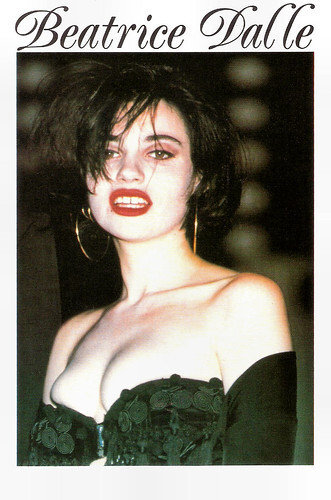
British postcard by Heroes Publishing LTD., London, no. SPC 2355.
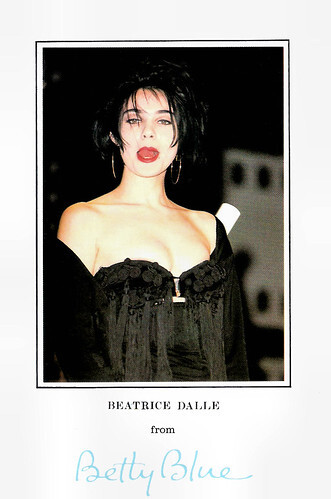
British postcard by A Bigger Splash, Manchester, no. X300. Caption: Beatrice Dalle from Betty Blue.
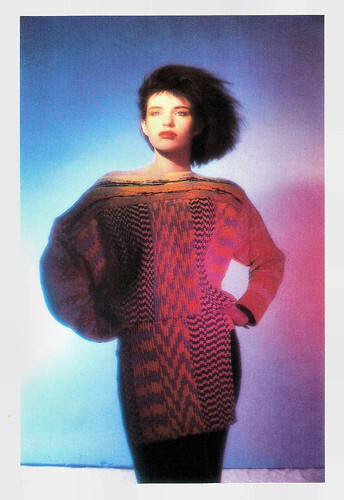
French postcard by Editions L'Echiquier d'Art, Paris, no. RC 7. Photo: Robert Chouraqui.
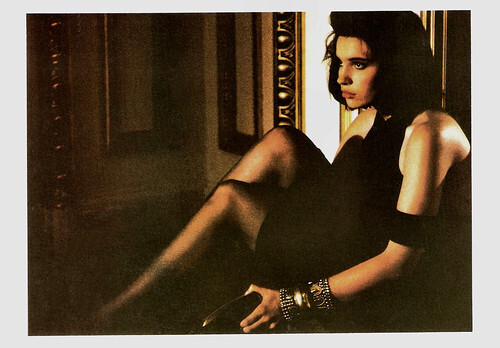
Vintage postcard. Beatrice Dalle in On a volé Charlie Spencer!/Charlie Spencer was stolen! (Francis Huster, 1986).
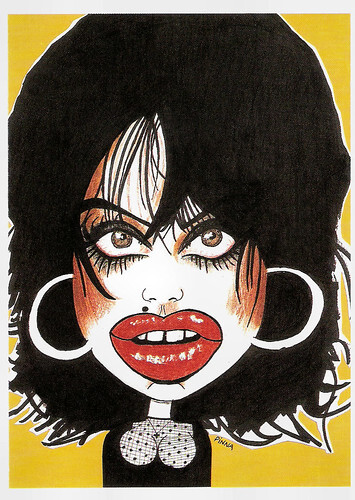
French postcard in the Pinna-cothèque series by Trema Compo, La Puy, no. 6. Caricature: Pinna.
Sources: Jason Buchanan (AllMovie), Colin Randall (The Telegraph), Henry Samuel (The Telegraph), Wikipedia and .

French postcard by Edition F. Nugeron, no. 16. Photo: Collection de l'Ecole de Cinéma Casiris, Lyon. Béatrice Dalle in 37°2 le matin/Betty Blue (Jean-Jacques Beineix, 1986).

French postcard by Metro Music, no. MM 186. Béatrice Dalle in 37°2 le matin/Betty Blue (Jean-Jacques Beineix, 1986).

Swiss postcard by News Productions, Baulmes, no. 55955. Photo: Bettina Rheims / Musée de l'Élysée, Lausanne. Caption: Béatrice Dalle on the bed II, Paris, 1986.

British postcard by Classics Postcards, London, no. 82.

French postcard in the 'Collection Cinéma' series by Studio Magazine, Paris, no. PSM 389. Photo: Luc Roux.

French postcard by Editions F. Nugeron, no. 19. Photo: Collection de l'École de Cinéma CAMIRIS, Lyon.Béatrice Dalle in 37°2 le matin/Betty Blue (Jean-Jacques Beineix, 1986).
Lolitas
Béatrice Dalle was born as Béatrice Françoise Odona Cabarrou in Brest, France, in 1964. (However, a number of sources state she was born in Le Mans, France.) In 1985 she married the painter Jean-François Dalle but they divorced in 1988.
She was spotted by a photographer on the Champs Élysées. Following a cover shoot in Photo magazine on the subject of Lolitas, Dalle was introduced to agent Dominique Besnehard, who in turn introduced her to film director Jean-Jacques Beineix. He cast her in the lead role in his erotic drama 37°2 le matin/Betty Blue (Jean-Jacques Beineix, 1986).
Betty Blue is a sexually aggressive free spirit who becomes involved with Zorg ( Jean-Hugues Anglade ), a repairman moonlighting as a writer. The two engage in a variety of sexual encounters and grow more passionate toward each other. Her portrayal of the beautiful, impulsive but increasingly unstable Betty was a sensation. The French cinema had a new sex symbol.
Jason Buchanan at AllMovie : “Immediately recognized by the French masses for her unmistakable presence and stunning performance as the titular character, Dalle's career was soon on the rise, with a subsequent performance as a woman who claims to be a witch in La Visione del Sabba/The Witches' Sabbath (Marco Bellocchio, 1988) cementing her status as an unconventional actress of daring sensibilities.”
Chimère/Bubble (Claire Devers, 1989) was entered into the 1989 Cannes Film Festival. She then appeared opposite Isabelle Huppert in the dark drama La Vengeance d'une Femme/A Woman's Revenge (Jacques Doillon, 1989), based on Fyodor Dostoyevsky's 'The Eternal Husband'. Privately, she had a ten-year relationship with the French rapper Joey Starr.

French postcard, no. 2082.

British postcard by World Postcards, Inc., 1989, no X223. Caption: Beatrice Dalle, Polka dot.

Vintage postcard, no. X208. Caption: White t-shirt.

French postcard by Humour à la Carte, Paris, no. ST-160. Photo: J. Casano / Stills.

French postcard by Humour à la Carte, Paris, no. ST-162. photo: J. Casano / Stills.

French postcard by Especially for you, Réf. 6. Photo: Jean-Hugues Anglade and Beatrice Dalle in 37°2 le matin/Betty Blue (1986).
Undesirable Immigrant
Béatrice Dalle made her international debut as a beautiful but surly blind girl in the Paris episode of the round-the-world comedy Night on Earth (Jim Jarmusch, 1991). That year, she also featured in the music video Move To Memphis (1991) by Norwegian band A-ha.
Dalle appeared almost exclusively in French films, including À la Folie/Six days, six nights (Diane Kurys, 1994) about A menage-a-trois between rival sisters (Dalle and Anne Parillaud) and a boyfriend, and J'ai Pas Sommeil/I Can't Sleep (Claire Denis, 1994) about two nocturnal serial killers who terrorize Paris.
Her first Hollywood production was The Blackout (Abel Ferrara, 1997) as the girlfriend of Matthew Modine, but her American career was cut short. During the production of The Blackout in Miami, she was arrested for cocaine possession. The incident would later come back to haunt her. Following her arrest, Dalle was declared an ‘Undesirable Immigrant'.
She would later be denied an American work permit to play the role of Bruce Willis' wife in The Sixth Sense, leaving the role open for actress Olivia Williams to fill.
It was not the only incident. In 1991, Dalle had already been arrested for a drug conviction in France in addition to a prior conviction of stealing jewels from a Paris boutique. She also had a drug conviction in France and there was another incident in which Dalle physically attacked a Parisian meter maid who was writing the actress a ticket for parking in a handicapped space.

French postcard by Editions F. Nugeron, no. E 309. Image: French film poster for 37°2 le matin/Betty Blue (Jean-Jacques Beineix, 1986).

Romanian postcard by Casa Filmului Acin. Béatrice Dalle in 37°2 le matin/Betty Blue (Jean-Jacques Beineix, 1986).

French postcard by Humour a la carte, Paris, no. A-C 1242. Photo: Gaumont. Béatrice Dalle in 37°2 le matin/Betty Blue (Jean-Jacques Beineix, 1986). Caption: Betty was like a wild horse that had cut its hocks on a fence and was trying to get back up.

French postcard by Humour a la carte, Paris, no. A-C 1243. Photo: Gaumont. Béatrice Dalle and Jean-Hugues Anglade in 37°2 le matin/Betty Blue (Jean-Jacques Beineix, 1986). Caption: I had been looking for meaning in my life for a long time. Betty was the most important thing that ever happened to me.

French postcard by Humour a la carte, Paris, no. A-C 1244. Photo: Gaumont. Béatrice Dalle and Jean-Hugues Anglade in 37°2 le matin/Betty Blue (Jean-Jacques Beineix, 1986). Caption: It had been a week since I met Betty. We had sex every night. They had announced thunderstorms for the evening.

French postcard by Ebulittions, no. 16. Photo: publicity still for 37°2 le matin/Betty Blue (1986).
A princess who falls for a prisoner
In 2001, Béatrice Dalle appeared in the controversial art-house thriller Trouble Every Day (Claire Denis, 2003), in which she played a cannibal opposite Vincent Gallo. Then she was directed by Nobuhiro Suwa in H Story (2001), a postmodern adaptation of Alain Renais' classic Hiroshima, Mon Amour (1959). Suwa plays himself as a director who is seeking to remake the masterwork and who has cast Dalle in the lead role originally played by Emmanuelle Riva .
Critical successes were the dramas Le temps du loup/The Time of the Wolf (Michael Haneke, 2003) starring Isabelle Huppert , Clean (Olivier Assayas, 2004) with Maggie Cheung and Nick Nolte, and L'Intrus/The Intruder (Claire Denis, 2004) with Michel Subor .
In 2005, Dalle encountered Guénaël Méziani when they co-starred in Tête d'Or/Golden Head (2005), a film produced inside a prison in Brest. She appeared as a princess who falls for a prisoner. In reality, Dalle also fell in love at first sight with Meziani who was really serving a 12-year prison sentence for assaulting and raping his ex-girlfriend. She married him after 24 one-hour visits with him and spoke on his behalf at hearings for his early release. According to the newspaper Le Parisien, in May 2009 just weeks after he was given a conditional release for good behaviour, police were called to her flat in the Marais district of Paris because of a violent dispute in which Meziani allegedly threatened to kill Dalle. Their divorce was pronounced in July 2014.
In the next years, she starred in such films as À l'intérieur/Inside (Alexandre Bustillo, Julien Maury, 2007), in which she played a cruel psychopath stalking a pregnant woman, the TV film New Wave (Gaël Morel, 2008) and the family drama Domaine/Domain (Patric Chiha, 2009) in which she played an alcoholic and onetime professor of mathematics. Then followed Notre paradis/Our Paradise (Gaël Morel, 2011) and Bye Bye Blondie (Virginie Despentes, 2012) with Emmanuelle Béart .
In recent years, she appeared in such films as Rupert Everett 's The Happy Prince (2018), a biographical drama film about Oscar Wilde, Gaspar Noé's Lux Æterna (2019), an independent experimental meta-art film, and La Bête dans la jungle/The Beast in the Jungle (Patric China, 2023), an internationally co-produced drama, loosely based on the 1903 novella 'The Beat in the Jungle' by Henry James.

French postcard, no. A079. Sent by mail in 1994.

French postcard, no. A080.

French postcard by Heroes, no. SPC 2330.

British postcard by Heroes Publishing LTD., London, no. SPC 2355.

British postcard by A Bigger Splash, Manchester, no. X300. Caption: Beatrice Dalle from Betty Blue.

French postcard by Editions L'Echiquier d'Art, Paris, no. RC 7. Photo: Robert Chouraqui.

Vintage postcard. Beatrice Dalle in On a volé Charlie Spencer!/Charlie Spencer was stolen! (Francis Huster, 1986).

French postcard in the Pinna-cothèque series by Trema Compo, La Puy, no. 6. Caricature: Pinna.
Sources: Jason Buchanan (AllMovie), Colin Randall (The Telegraph), Henry Samuel (The Telegraph), Wikipedia and .
Published on April 17, 2023 22:00
April 16, 2023
Directed by Billy Wilder
Billy Wilder (1906-2002) was an American filmmaker of Jewish descent. He was a multiple Oscar winner and is considered one of the most important directors in American film history. His oeuvre comprises more than 60 films made over a period of over 50 years. He was nominated for an Oscar 21 times as a writer, producer and director and won six awards. At the 1961 Oscars, he won three awards as producer, screenwriter and director for the film The Apartment, a feat that has only been achieved by a total of nine directors to date.
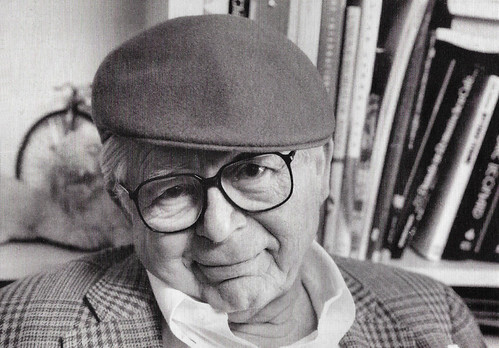
Austrian postcard by Mandelbaum / Österreichische Exilbibliothek im Literaturhaus, Wien/ Photo: Allisa Dauer. Caption: Billy Wilder, born in 1906 in Sucha, Galicia, director and screenwriter.

French postcard by Editions P.I., offered by Victoria S.A. (Biscuits, Chocolates and Patisserie), Brussels. Photo: Paramount Pictures 1950. Barbara Stanwyck in Double Indemnity (Billy Wilder, 1944).
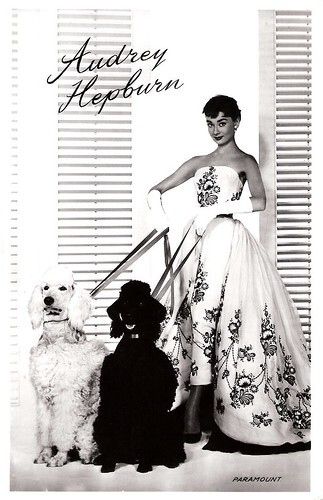
Dutch postcard by Takken, Utrecht, no. 1530. Photo: Paramount. Audrey Hepburn in Sabrina (Billy Wilder, 1954). Costume: Hubert de Givenchy.
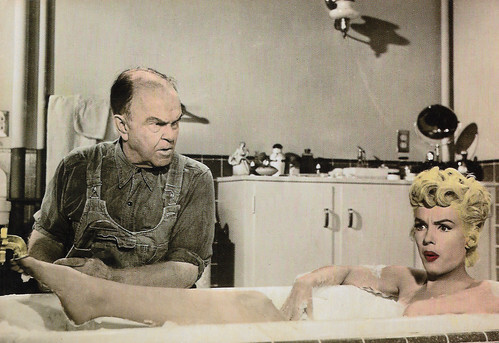
American postcard by Classico San Francisco, no. 105/001. Photo: Twentieth Century Fox / Charles K. Feldman Group Productions. Victor Moore and Marilyn Monroe in The Seven Year Itch (Billy Wilder, 1955).
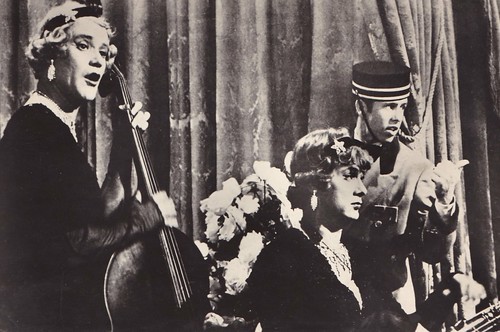
Czech postcard by Pressfoto, Praha (Prague). Photo: Jack Lemmon and Tony Curtis in Some Like it Hot (Billy Wilder, 1959). Collection: Carla Bosch.
The biggest media scandal of the First Republic in Austria
Samuel 'Billie' Wilder was born in 1906 in Sucha, Austria-Hungary often referred to as the Austro-Hungarian Empire. Samuel was the son of Jewish parents, Max and Eugenia Wilder. His father ran the "City" hotel in Krakow as well as several railway station restaurants in the area.
His mother always called her son "Billie". Samuel, therefore, called himself Billie Wilder. Later in the USA, he changed the spelling to Billy. In 1916, during the First World War, the family moved to Vienna fearing the approaching Russian army. In the capital, Billie became close friends with the later Hollywood director Fred Zinnemann, and they kept in touch throughout his life.
Wilder began his career as a reporter for the Viennese tabloid Die Stunde (The Hour). When he interviewed the jazz musician Paul Whiteman in 1926, the latter was so enthusiastic about him that he invited him to come with him to Berlin to show him the city. A week later it turned out that Die Stunde was blackmailing Viennese businessmen and celebrities at the time with the threat of publishing unflattering articles about them. The affair became the biggest media scandal of the First Republic in Austria and Wilder decided to stay in Berlin and work for another newspaper, the city's largest tabloid.
There he came in contact with the film industry. German Wikipedia : "when the director of a film company, Maxim Galitzenstein, had to escape in his pants from the neighbour's bedroom to Wilder's room, he couldn't help but buy Wilder's first screenplay." Billie was hired as a ghostwriter for well-known screenwriters such as Robert Liebmann and Franz Schulz. It was an additional source of income alongside his work as a reporter. In 1929, he contributed with Curt Siodmak, Robert Siodmak, Fred Zinnemann and Edgar G. Ulmer to the classic film Menschen am Sonntag/People on Sunday (Robert Siodmak, Edgar G. Ulmer, 1930). The film follows a group of young residents of Berlin on a summer's day during the interwar period. Hailed as a work of genius, it is a pivotal film in the development of German cinema.
Together with Erich Kästner, Billie wrote the screenplay for Emil und die Detektive/Emil and the Detectives (Gerhard Lamprecht, 1931) the first film adaptation of Kästner's novel and generally considered to be the best film version. Wilder realised his Jewish ancestry would cause problems when the National Socialists would seize power. Immediately after Adolf Hitler came to power in 1933, Wilder moved to France. In Paris, Billie earned his living as a ghostwriter for French screenwriters. Here he also directed his first film, the crime drama Mauvaise graine/Bad Seed (Billie Wilder, Alexander Esway, 1934) with Danielle Darrieux .
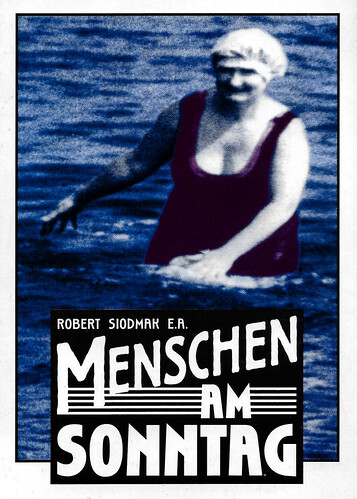
Dutch postcard by Filmmuseum, Amsterdam. Photo: Filmmuseum. Poster for Menschen am Sonntag/People on Sunday (Robert Siodmak, Edgar G. Ulmer, 1930) for which Billy Wilder contributed to the story.
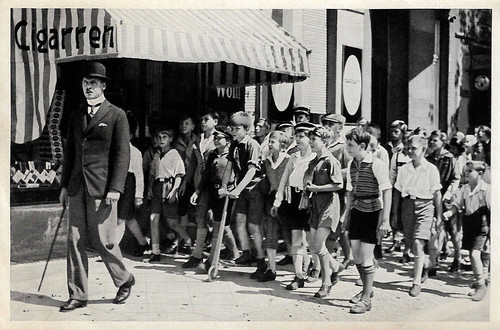
German collectors card in the series 'Vom Werden deutscher Filmkunst - Der Tonfilm', album no. 11, picture no. 58, group 44. Photo: Ufa / Ross Verlag. Fritz Rasp in Emil und die Detektive/Emil and the Detectives (Gerhard Lamprecht, 1931).
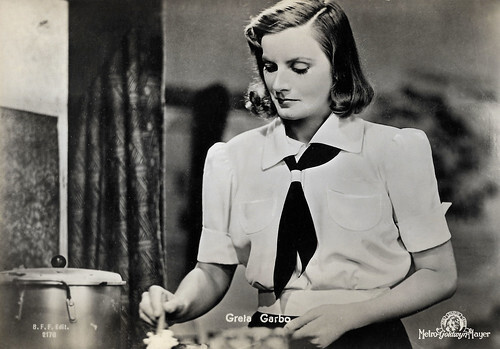
Italian postcard by B.F.F. Edit. (Casa Editr. Ballerini & Fratini, Firenze), no. 2178. Photo: Metro-Goldwyn-Mayer. Greta Garbo in Ninotchka (Ernst Lubitsch, 1939).
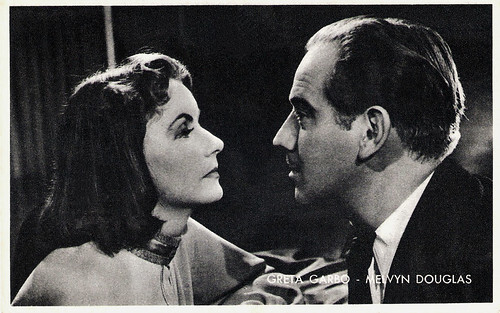
Belgian collectors card by Kwatta, Bois - D'Haine, no. C 181. Photo: MGM. Greta Garbo and Melvyn Douglas in Ninotchka (Ernst Lubitsch, 1939).
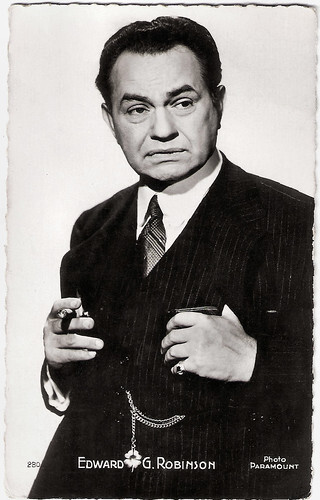
French postcard by Edition P.I., Paris, no. 280, 1950. Photo: Paramount. Edward G. Robinson in Double Indemnity (Billy Wilder, 1944).
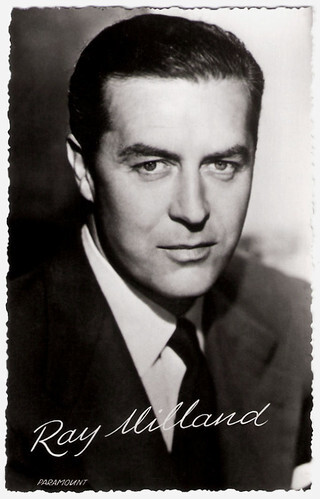
Dutch postcard by Takken, no. 3446. Photo: Paramount. Ray Milland .
The atrocities committed by the Nazi regime
In 1934 Billie Wilder was able to enter the United States, thanks to a visitor's visa granted by Joe May . Although he spoke no English when he arrived in Hollywood, Wilder was a fast learner. Thanks to contacts such as Peter Lorre , with whom he shared an apartment, he was signed by Paramount Pictures in 1936. After his emigration, he became a naturalised American named Billy.
His partnership with author Charles Brackett started in 1938 and the team was responsible for writing some of Hollywood's classic comedies, including Ninotchka (Ernst Lubitsch, 1939) starring Greta Garbo and Ball of Fire (Howard Hawks, 1941) with Barbara Stanwyck and Gary Cooper .
However, Wilder was dissatisfied with the constant changes to his scripts and wanted to take the reins himself. His partnership with Brackett expanded into a producer-director one in 1942. The comedy The Major and the Minor (1942) with Ginger Rogers and Ray Milland was the first film he directed. His second film, Five Graves to Cairo (1943) with Franchot Tone , served as a propaganda film against the Nazi regime during World War II.
Wilder quickly garnered success as a director. He had his breakthrough with the Film Noir Double Indemnity (1944), starring Fred MacMurray , Edward G. Robinson and Barbara Stanwyck as a femme fatale. The film received seven Oscar nominations, including two for Wilder in the categories of Best Director and Best Adapted Screenplay.
In 1945, Wilder was commissioned by the U.S. Army Signal Corps to condense the extensive material available from the American and British military about, among other things, the liberation of the Bergen-Belsen concentration camp into a short film, Death Mills/Die Todesmühlen (1945). The film was intended for German audiences to educate them about the atrocities committed by the Nazi regime. It became the only documentary film under his supervision. Not having seen his mother and stepfather since he went to Berlin in 1933 to make films, he joined American patrols through war-torn Europe during WWII. Through intense research, he learned they had been murdered in concentration camps and his grandmother had died in a Polish ghetto. Later, he usually declined to discuss this.
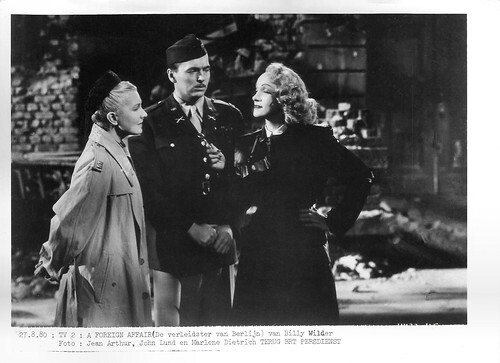
Belgian press photo by BRT Television. Jean Arthur , John Lund and Marlene Dietrich in A Foreign Affair (Billy Wilder, 1948).
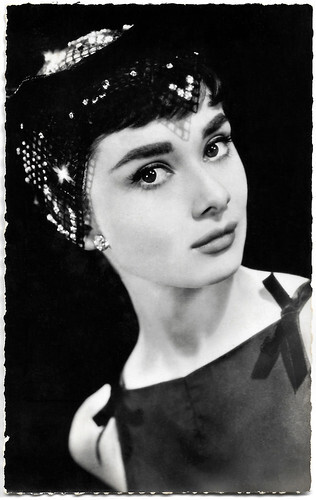
French postcard by Editions du Globe, Paris, no. 384. Photo: Paramount / PPC, 1955. Audrey Hepburn in Sabrina (Billy Wilder, 1954). Costume: Hubert de Givenchy.
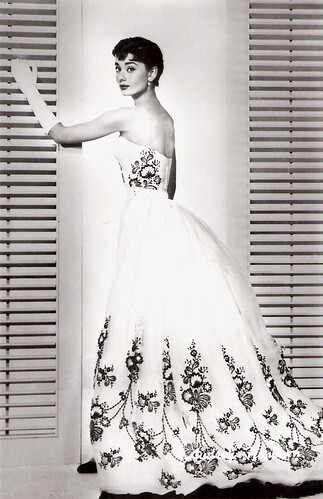
French postcard. Audrey Hepburn in Sabrina (Billy Wilder, 1954). Dress: Hubert de Givenchy.
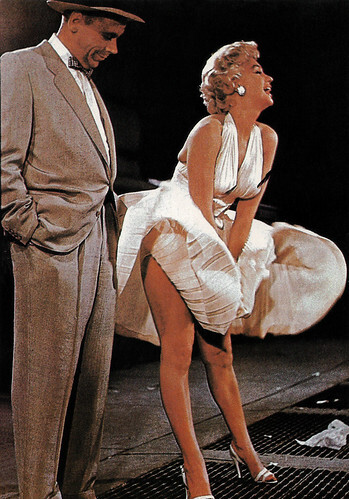
French postcard, no. A030. Marilyn Monroe and Tom Ewell in The Seven Year Itch (Billy Wilder, 1955).
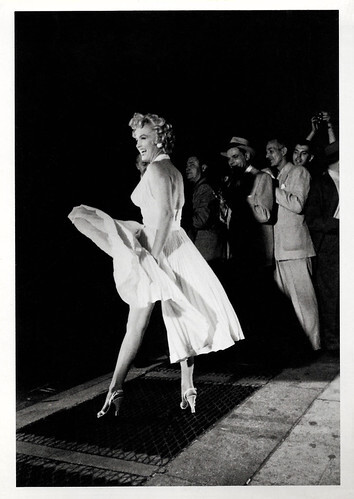
American postcard by Fotofolio, New York, no. MP65. Photo: Elliot Erwitt. Marilyn Monroe and Tom Ewell at the set of The Seven Year Itch (Billy Wilder, 1955).
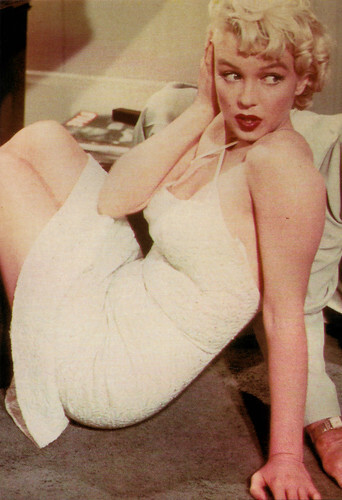
American postcard by Classico San Francisco, no. 105/031. Marilyn Monroe in The Seven Year Itch (Billy Wilder, 1955).
Cynicism, humour and an original storyline
Billy Wilder received his first Oscar for the drama The Lost Weekend (1945), starring Ray Milland as an unsuccessful author with a drinking problem. The film dealt unusually realistically with the problems of an alcoholic.
Shortly afterwards, Wilder went to Germany on behalf of the American government with the rank of colonel and directed the film A Foreign Affair (1948), starring Jean Arthur and Marlene Dietrich , which dealt critically with the Nazi past in occupied Germany.
Among his other classics are the drama Sunset Boulevard (1950) starring William Holden and Gloria Swanson , the romance Sabrina (1954) starring Audrey Hepburn and Humphrey Bogart , and the comedies The Seven Years Itch (1955) and Some Like It Hot (1959), both starring Marilyn Monroe .
He had a long-standing partnership with screenwriter I.A.L. Diamond with whom he made such classic comedies as The Apartment (1961) and Irma La Douce (1963), both with Jack Lemmon and Shirley MacLaine . His work is characterised by cynicism, humour and an original storyline. He was fascinated by a wide variety of subjects and he often used the same actors, such as Jack Lemmon and Walter Matthau.
Wilder's later works were unable to match the success of his heyday. Although he lost some of his brilliance as a filmmaker later in his life, many of his films are still considered classics. From the mid-1980s, he limited himself to consulting work for United Artists. In 2002, Billy Wilder died of pneumonia in Los Angeles, California at the age of 95. He had been struggling with health problems for some time, but still gave interviews. His grave is in Westwood Village Memorial Park Cemetery. Wilder was married to Judith Coppicus-Iribe from 1936 to 1947. They had a daughter together, Victoria (1939). In 1949 Wilder married the actress and singer Audrey Young (1922-2012).
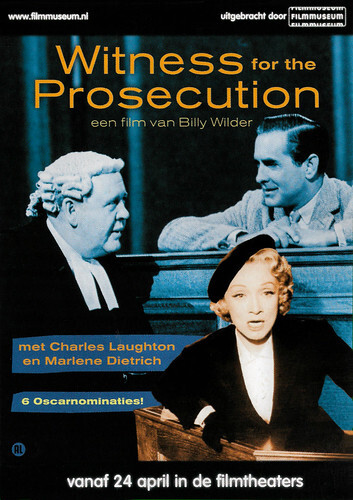
Dutch postcard by Filmmuseum, Amsterdam. Photo: Filmmuseum. Marlene Dietrich , Charles Laughton and Tyrone Power in Witness for the Prosecution (Billy Wilder, 1957). Caption: "I am constantly surprised that women's hats do not provoke more murders."
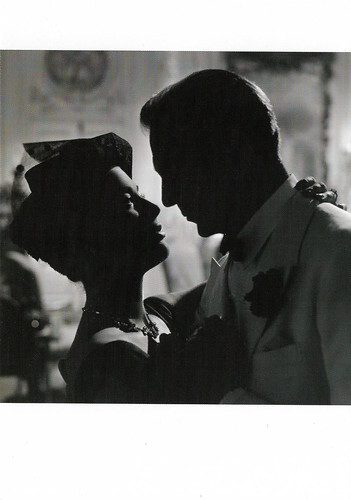
French postcard for the exhibition 'Figures de Facteur' (2004-2005) in Paris by Cartapub / Ministerie de la Culture et de la Communication. Photo: Raymond Voinquel. Gary Cooper and Lise Bourdin in Love in the Afternoon (Billy Wilder, 1956).
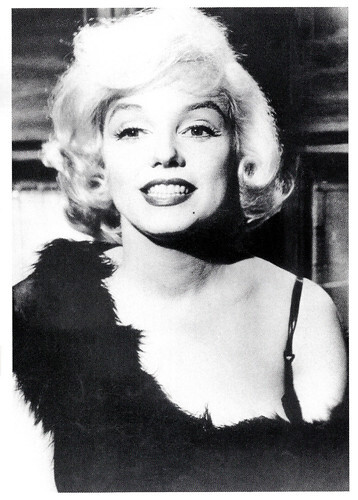
Dutch freecard by Boomerang, Amsterdam. Photo: Filmmuseum. Marilyn Monroe in Some Like It Hot (Billy Wilder, 1959). Caption: Filmmuseum Classics Tour 2002: Some Like It Hot and 26 other unforgettable classics.
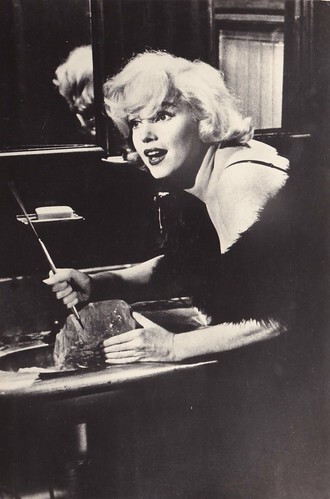
Czech postcard by Pressfoto, Praha (Prague). Photo: Marilyn Monroe in Some Like it Hot (Billy Wilder, 1959). Collection: Carla Bosch.
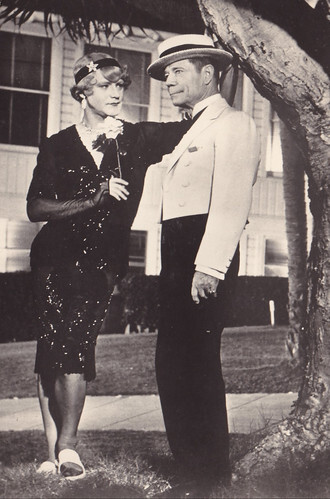
Czech postcard by Pressfoto, Praha (Prague). Photo: Jack Lemmon and Joe E. Brown in Some Like it Hot (Billy Wilder, 1959). Collection: Carla Bosch.
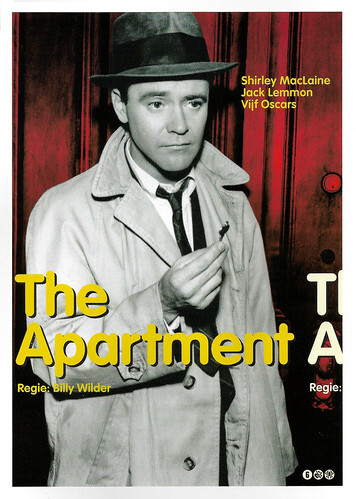
Dutch postcard by Filmmuseum, Amsterdam. Photo: Filmmuseum. Jack Lemmon in The Apartment (Billy Wilder, 1960).

Big East-German card by VEB Progress Film-Vertrieb, Berlin, no. 65/72,1972. Jack Lemmon and Judi West in The Fortune Cookie (Billy Wilder, 1966).
Sources: (IMDb), Wikipedia (Dutch and German) and .

Austrian postcard by Mandelbaum / Österreichische Exilbibliothek im Literaturhaus, Wien/ Photo: Allisa Dauer. Caption: Billy Wilder, born in 1906 in Sucha, Galicia, director and screenwriter.

French postcard by Editions P.I., offered by Victoria S.A. (Biscuits, Chocolates and Patisserie), Brussels. Photo: Paramount Pictures 1950. Barbara Stanwyck in Double Indemnity (Billy Wilder, 1944).

Dutch postcard by Takken, Utrecht, no. 1530. Photo: Paramount. Audrey Hepburn in Sabrina (Billy Wilder, 1954). Costume: Hubert de Givenchy.

American postcard by Classico San Francisco, no. 105/001. Photo: Twentieth Century Fox / Charles K. Feldman Group Productions. Victor Moore and Marilyn Monroe in The Seven Year Itch (Billy Wilder, 1955).

Czech postcard by Pressfoto, Praha (Prague). Photo: Jack Lemmon and Tony Curtis in Some Like it Hot (Billy Wilder, 1959). Collection: Carla Bosch.
The biggest media scandal of the First Republic in Austria
Samuel 'Billie' Wilder was born in 1906 in Sucha, Austria-Hungary often referred to as the Austro-Hungarian Empire. Samuel was the son of Jewish parents, Max and Eugenia Wilder. His father ran the "City" hotel in Krakow as well as several railway station restaurants in the area.
His mother always called her son "Billie". Samuel, therefore, called himself Billie Wilder. Later in the USA, he changed the spelling to Billy. In 1916, during the First World War, the family moved to Vienna fearing the approaching Russian army. In the capital, Billie became close friends with the later Hollywood director Fred Zinnemann, and they kept in touch throughout his life.
Wilder began his career as a reporter for the Viennese tabloid Die Stunde (The Hour). When he interviewed the jazz musician Paul Whiteman in 1926, the latter was so enthusiastic about him that he invited him to come with him to Berlin to show him the city. A week later it turned out that Die Stunde was blackmailing Viennese businessmen and celebrities at the time with the threat of publishing unflattering articles about them. The affair became the biggest media scandal of the First Republic in Austria and Wilder decided to stay in Berlin and work for another newspaper, the city's largest tabloid.
There he came in contact with the film industry. German Wikipedia : "when the director of a film company, Maxim Galitzenstein, had to escape in his pants from the neighbour's bedroom to Wilder's room, he couldn't help but buy Wilder's first screenplay." Billie was hired as a ghostwriter for well-known screenwriters such as Robert Liebmann and Franz Schulz. It was an additional source of income alongside his work as a reporter. In 1929, he contributed with Curt Siodmak, Robert Siodmak, Fred Zinnemann and Edgar G. Ulmer to the classic film Menschen am Sonntag/People on Sunday (Robert Siodmak, Edgar G. Ulmer, 1930). The film follows a group of young residents of Berlin on a summer's day during the interwar period. Hailed as a work of genius, it is a pivotal film in the development of German cinema.
Together with Erich Kästner, Billie wrote the screenplay for Emil und die Detektive/Emil and the Detectives (Gerhard Lamprecht, 1931) the first film adaptation of Kästner's novel and generally considered to be the best film version. Wilder realised his Jewish ancestry would cause problems when the National Socialists would seize power. Immediately after Adolf Hitler came to power in 1933, Wilder moved to France. In Paris, Billie earned his living as a ghostwriter for French screenwriters. Here he also directed his first film, the crime drama Mauvaise graine/Bad Seed (Billie Wilder, Alexander Esway, 1934) with Danielle Darrieux .

Dutch postcard by Filmmuseum, Amsterdam. Photo: Filmmuseum. Poster for Menschen am Sonntag/People on Sunday (Robert Siodmak, Edgar G. Ulmer, 1930) for which Billy Wilder contributed to the story.

German collectors card in the series 'Vom Werden deutscher Filmkunst - Der Tonfilm', album no. 11, picture no. 58, group 44. Photo: Ufa / Ross Verlag. Fritz Rasp in Emil und die Detektive/Emil and the Detectives (Gerhard Lamprecht, 1931).

Italian postcard by B.F.F. Edit. (Casa Editr. Ballerini & Fratini, Firenze), no. 2178. Photo: Metro-Goldwyn-Mayer. Greta Garbo in Ninotchka (Ernst Lubitsch, 1939).

Belgian collectors card by Kwatta, Bois - D'Haine, no. C 181. Photo: MGM. Greta Garbo and Melvyn Douglas in Ninotchka (Ernst Lubitsch, 1939).

French postcard by Edition P.I., Paris, no. 280, 1950. Photo: Paramount. Edward G. Robinson in Double Indemnity (Billy Wilder, 1944).

Dutch postcard by Takken, no. 3446. Photo: Paramount. Ray Milland .
The atrocities committed by the Nazi regime
In 1934 Billie Wilder was able to enter the United States, thanks to a visitor's visa granted by Joe May . Although he spoke no English when he arrived in Hollywood, Wilder was a fast learner. Thanks to contacts such as Peter Lorre , with whom he shared an apartment, he was signed by Paramount Pictures in 1936. After his emigration, he became a naturalised American named Billy.
His partnership with author Charles Brackett started in 1938 and the team was responsible for writing some of Hollywood's classic comedies, including Ninotchka (Ernst Lubitsch, 1939) starring Greta Garbo and Ball of Fire (Howard Hawks, 1941) with Barbara Stanwyck and Gary Cooper .
However, Wilder was dissatisfied with the constant changes to his scripts and wanted to take the reins himself. His partnership with Brackett expanded into a producer-director one in 1942. The comedy The Major and the Minor (1942) with Ginger Rogers and Ray Milland was the first film he directed. His second film, Five Graves to Cairo (1943) with Franchot Tone , served as a propaganda film against the Nazi regime during World War II.
Wilder quickly garnered success as a director. He had his breakthrough with the Film Noir Double Indemnity (1944), starring Fred MacMurray , Edward G. Robinson and Barbara Stanwyck as a femme fatale. The film received seven Oscar nominations, including two for Wilder in the categories of Best Director and Best Adapted Screenplay.
In 1945, Wilder was commissioned by the U.S. Army Signal Corps to condense the extensive material available from the American and British military about, among other things, the liberation of the Bergen-Belsen concentration camp into a short film, Death Mills/Die Todesmühlen (1945). The film was intended for German audiences to educate them about the atrocities committed by the Nazi regime. It became the only documentary film under his supervision. Not having seen his mother and stepfather since he went to Berlin in 1933 to make films, he joined American patrols through war-torn Europe during WWII. Through intense research, he learned they had been murdered in concentration camps and his grandmother had died in a Polish ghetto. Later, he usually declined to discuss this.

Belgian press photo by BRT Television. Jean Arthur , John Lund and Marlene Dietrich in A Foreign Affair (Billy Wilder, 1948).

French postcard by Editions du Globe, Paris, no. 384. Photo: Paramount / PPC, 1955. Audrey Hepburn in Sabrina (Billy Wilder, 1954). Costume: Hubert de Givenchy.

French postcard. Audrey Hepburn in Sabrina (Billy Wilder, 1954). Dress: Hubert de Givenchy.

French postcard, no. A030. Marilyn Monroe and Tom Ewell in The Seven Year Itch (Billy Wilder, 1955).

American postcard by Fotofolio, New York, no. MP65. Photo: Elliot Erwitt. Marilyn Monroe and Tom Ewell at the set of The Seven Year Itch (Billy Wilder, 1955).

American postcard by Classico San Francisco, no. 105/031. Marilyn Monroe in The Seven Year Itch (Billy Wilder, 1955).
Cynicism, humour and an original storyline
Billy Wilder received his first Oscar for the drama The Lost Weekend (1945), starring Ray Milland as an unsuccessful author with a drinking problem. The film dealt unusually realistically with the problems of an alcoholic.
Shortly afterwards, Wilder went to Germany on behalf of the American government with the rank of colonel and directed the film A Foreign Affair (1948), starring Jean Arthur and Marlene Dietrich , which dealt critically with the Nazi past in occupied Germany.
Among his other classics are the drama Sunset Boulevard (1950) starring William Holden and Gloria Swanson , the romance Sabrina (1954) starring Audrey Hepburn and Humphrey Bogart , and the comedies The Seven Years Itch (1955) and Some Like It Hot (1959), both starring Marilyn Monroe .
He had a long-standing partnership with screenwriter I.A.L. Diamond with whom he made such classic comedies as The Apartment (1961) and Irma La Douce (1963), both with Jack Lemmon and Shirley MacLaine . His work is characterised by cynicism, humour and an original storyline. He was fascinated by a wide variety of subjects and he often used the same actors, such as Jack Lemmon and Walter Matthau.
Wilder's later works were unable to match the success of his heyday. Although he lost some of his brilliance as a filmmaker later in his life, many of his films are still considered classics. From the mid-1980s, he limited himself to consulting work for United Artists. In 2002, Billy Wilder died of pneumonia in Los Angeles, California at the age of 95. He had been struggling with health problems for some time, but still gave interviews. His grave is in Westwood Village Memorial Park Cemetery. Wilder was married to Judith Coppicus-Iribe from 1936 to 1947. They had a daughter together, Victoria (1939). In 1949 Wilder married the actress and singer Audrey Young (1922-2012).

Dutch postcard by Filmmuseum, Amsterdam. Photo: Filmmuseum. Marlene Dietrich , Charles Laughton and Tyrone Power in Witness for the Prosecution (Billy Wilder, 1957). Caption: "I am constantly surprised that women's hats do not provoke more murders."

French postcard for the exhibition 'Figures de Facteur' (2004-2005) in Paris by Cartapub / Ministerie de la Culture et de la Communication. Photo: Raymond Voinquel. Gary Cooper and Lise Bourdin in Love in the Afternoon (Billy Wilder, 1956).

Dutch freecard by Boomerang, Amsterdam. Photo: Filmmuseum. Marilyn Monroe in Some Like It Hot (Billy Wilder, 1959). Caption: Filmmuseum Classics Tour 2002: Some Like It Hot and 26 other unforgettable classics.

Czech postcard by Pressfoto, Praha (Prague). Photo: Marilyn Monroe in Some Like it Hot (Billy Wilder, 1959). Collection: Carla Bosch.

Czech postcard by Pressfoto, Praha (Prague). Photo: Jack Lemmon and Joe E. Brown in Some Like it Hot (Billy Wilder, 1959). Collection: Carla Bosch.

Dutch postcard by Filmmuseum, Amsterdam. Photo: Filmmuseum. Jack Lemmon in The Apartment (Billy Wilder, 1960).

Big East-German card by VEB Progress Film-Vertrieb, Berlin, no. 65/72,1972. Jack Lemmon and Judi West in The Fortune Cookie (Billy Wilder, 1966).
Sources: (IMDb), Wikipedia (Dutch and German) and .
Published on April 16, 2023 22:00
Paul van Yperen's Blog
- Paul van Yperen's profile
- 13 followers
Paul van Yperen isn't a Goodreads Author
(yet),
but they
do have a blog,
so here are some recent posts imported from
their feed.



